In the fast-paced world of ecommerce, staying ahead of product trends is key to capturing consumer interest. We’ve compiled 100+ trending products for 2025 across popular niches – all backed by data and market insights. Below you’ll find how we chose these products, a category-by-category breakdown of trending items (with brief descriptions, target audiences, market analysis, search demand, and price guidance), and tips for identifying winning niches and integrating these products into your business strategy.
How We Chose These Trending Products
To curate this list, we analyzed current market data, search trends, and consumer behavior. We looked at Google Trends, social media hashtags, industry reports, and top-selling items on major platforms. Our focus was on high-growth niches and products with surging interest or consistent demand. For example, we favored products showing significant search volume increases or market size growth. We also considered sustainability, tech innovation, and lifestyle shifts (like remote work or wellness focus) influencing product popularity. The result is a data-driven selection of trending products that offer strong sales potential in 2025. Each product listed includes a mini analysis and relevant statistics to illustrate why it’s hot.
Best Trending Tech & Gadgets Products
1.Smart Robot Vacuum Cleaners
Autonomous vacuum cleaners equipped with smart mapping and self-emptying features.

Target audience: Busy professionals, pet owners, and smart home enthusiasts who value automation.
Market analysis: The robot vacuum market is booming – with an estimated 2.5 million monthly searches in the US for related terms (around 600k just for “robot vacuum”). This growth is driven by improving tech and widespread adoption (consumer searches spike during holidays as people seek time-saving gadgets).
Monthly search volume: ~600,000+ for “robot vacuum” (very high demand).
Price range: ~$150–$800, with budget models under $150 and luxury models $800+ for cutting-edge features.
2.Smart Video Doorbells
WiFi-enabled doorbell cameras that allow real-time viewing and two-way talk via smartphone.
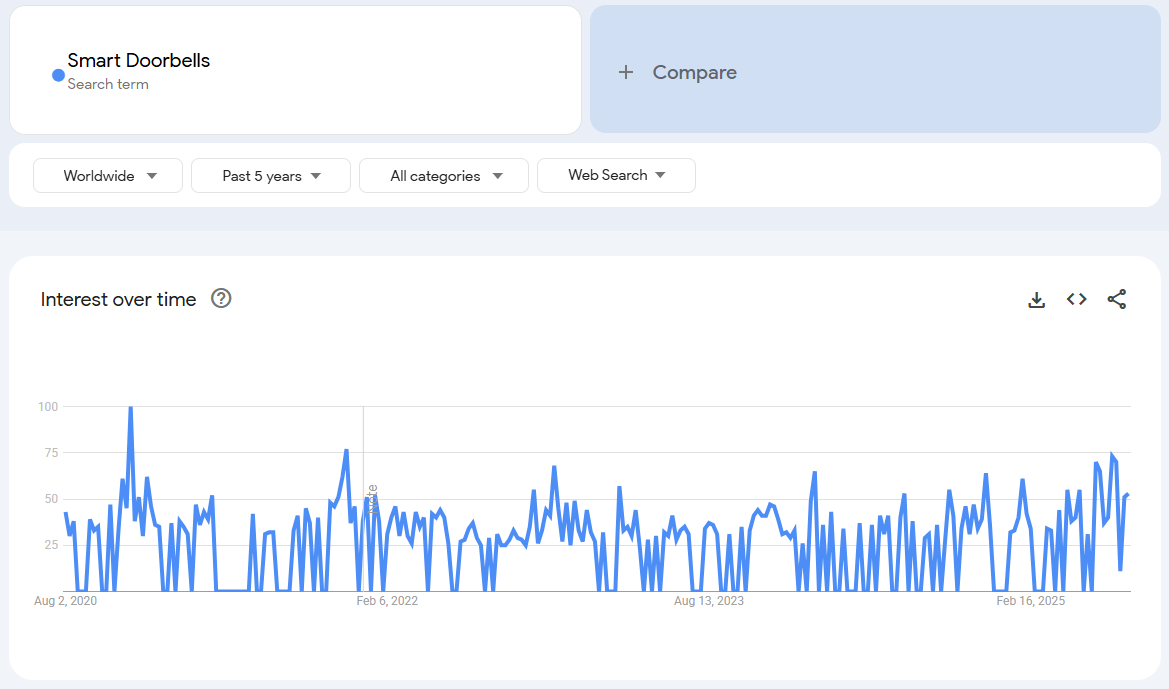
Target audience: Homeowners, renters, and families wanting enhanced home security and convenience.
Market analysis: Smart home tech continues to surge, and video doorbells hit all the marks: functional, affordable, DIY-friendly. They appeal to security-conscious shoppers and gadget lovers alike. Viral marketing (e.g. TikTok clips of porch interactions) has boosted awareness.
Monthly search volume: ~90,000 (for “video doorbell” and related terms).
Price range: ~$50–$250. Lower-priced models attract budget consumers, while premium brands with cloud storage and advanced features command higher prices.
3.Key Fob Covers
Protective and decorative silicone or leather covers for car key fobs.
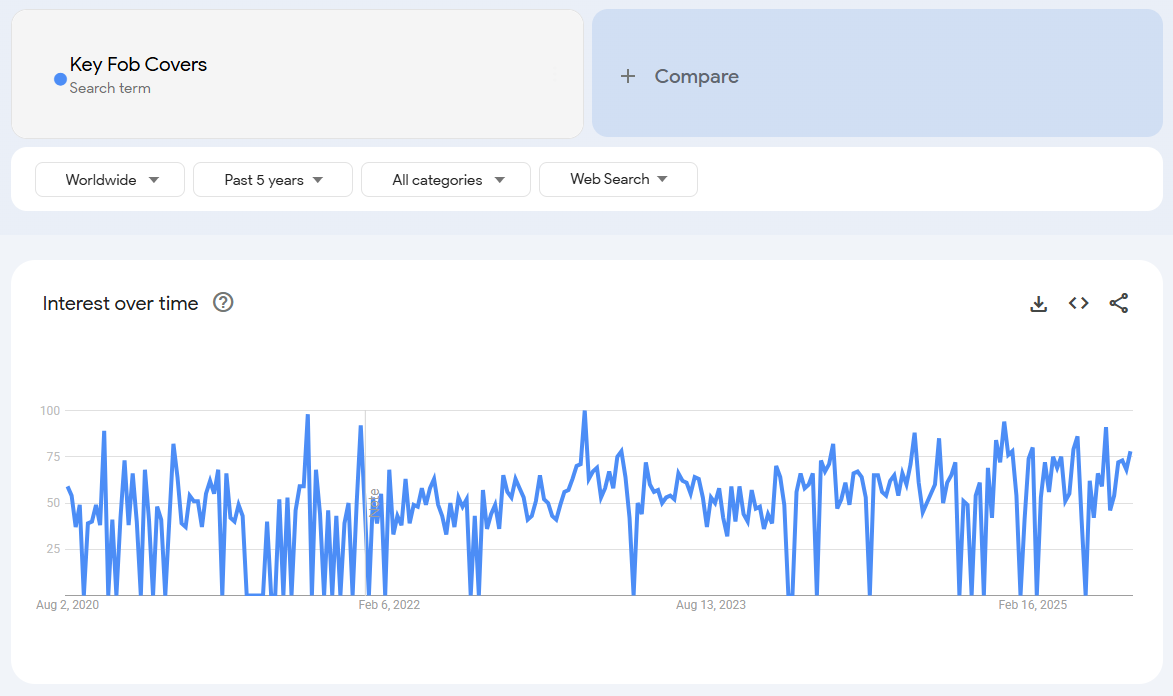
Target audience: Gen Z and millennial car owners who personalize their accessories, and anyone looking to protect their car keys.
Market analysis: This niche product is a viral Gen Z trend – primarily driven by aesthetics on social media. One TikTok-famous key fob cover garnered ~3 million views. Interest in key fob covers grew ~83% over 5 years, now seeing 8,100+ searches a month. Consumers like that these covers prevent scratches and add a personal flair to otherwise plain key fobs.
Price range: ~$8–$20, making them an easy impulse buy.
4.Gaming Earbuds
High-quality wireless earbuds designed for gaming, often with low latency and noise-canceling mics.
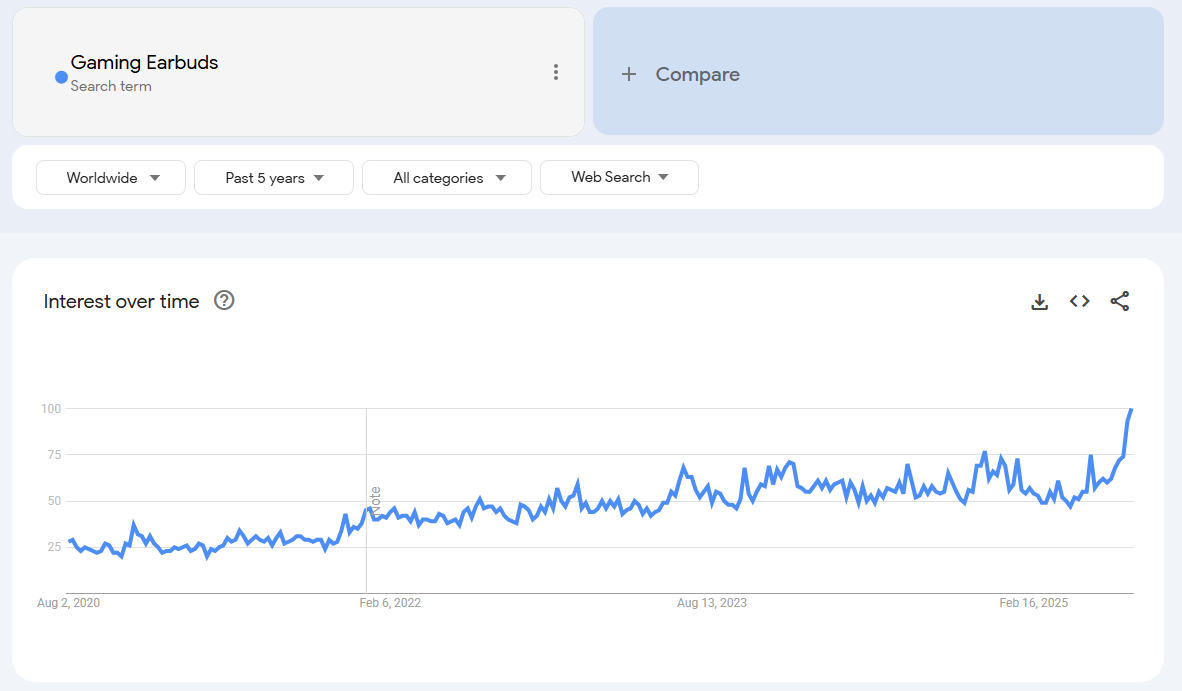
Target audience: Mobile and console gamers seeking a lightweight audio solution, plus general consumers wanting versatile earbuds.
Market analysis: With over 3 billion gamers worldwide, gaming peripherals are in demand. Gaming earbuds have seen 5-year search growth around 139%, now drawing about 49,500 searches per month. They tap into the trend of mobile gaming and streaming on the go. TikTok interest is huge too – gaming earbud videos have over 135 million views.
Price range: Widely varies from budget ~$15 up to $200+ for premium brands (some pro models even higher). Mid-range ($50–$100) hits the sweet spot for most gamers.
5.Hall-Effect Joysticks
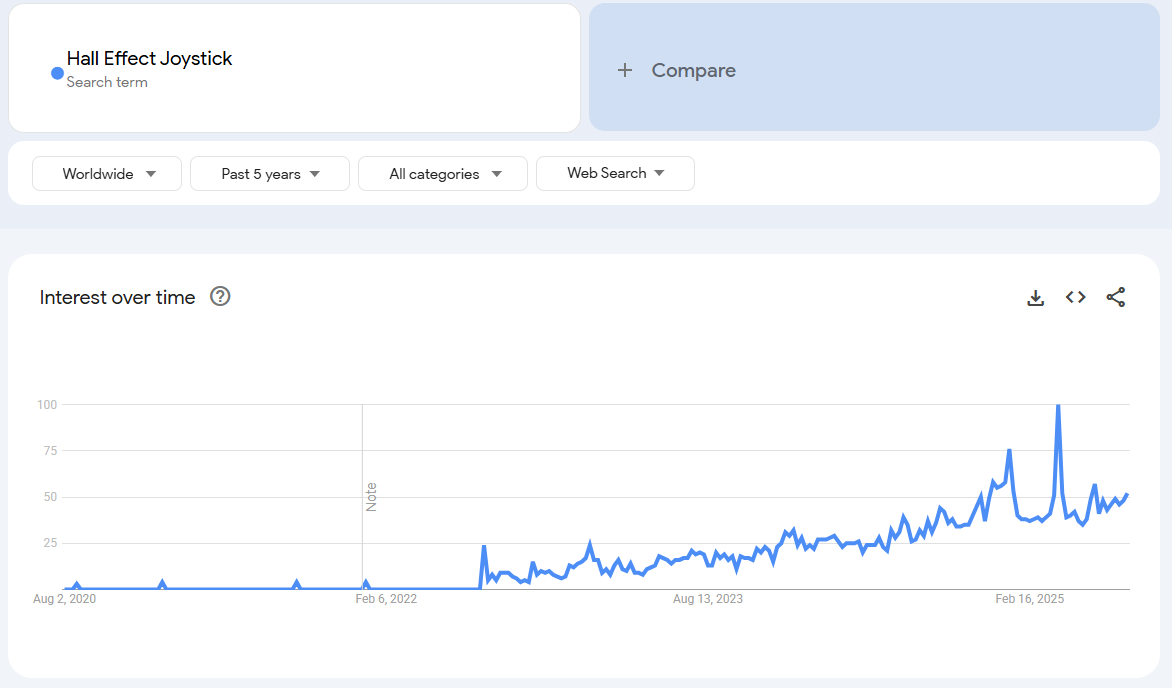
Joystick controllers using magnetic Hall-effect sensors for greater precision and durability (common in high-end gamepads and flight sim sticks).
Target audience: Hardcore gamers, simulation enthusiasts, and professionals needing reliable controllers (e.g. industrial or drone operators).
Market analysis: This techy sub-niche is trending due to gamers seeking drift-free, long-lasting sticks (a response to issues like controller drift in conventional potentiometer sticks). Search volume is about 27,100/mo for “Hall effect joystick”, with astronomical 5-year search growth (8,400%) as awareness explodes. As next-gen consoles and VR increase demand for better controllers, this product sees steady growth.
Price range: ~$15–$30 for standalone Hall-effect thumbsticks or ~$100–$250 for premium controllers featuring them.
6.Smartwatches & Fitness Trackers
Wearable tech for health tracking, notifications, and apps.
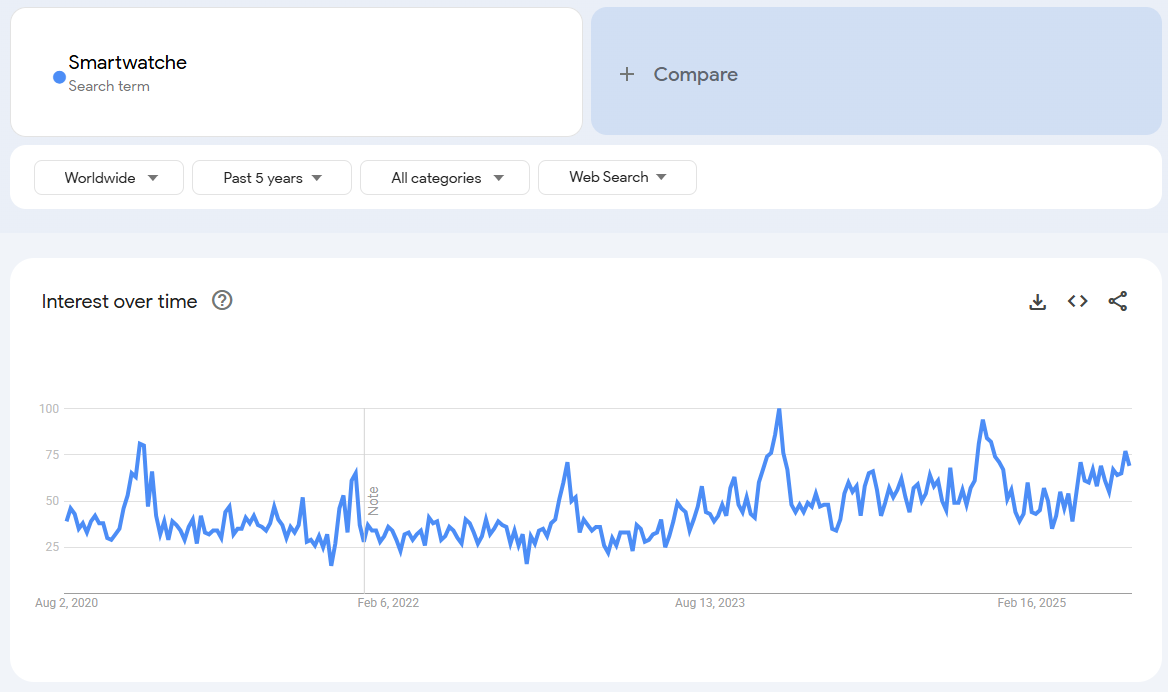
Target audience: Health-conscious users, tech enthusiasts, and mainstream consumers (from teens to seniors) using wearables for fitness and convenience.
Market analysis: Wearables remain on a strong growth trajectory. There are ~454 million smartwatch users worldwide in 2025, up 41% from 2023. The market is worth ~$50+ billion. Consumers rely on these devices for health monitoring – 92% use them for fitness tracking. With new models offering advanced features (ECG, blood oxygen) and fashion collabs, demand stays high.
Monthly search volume: ~150,000+ for “smartwatch” (consistently high).
Price range: ~$50 for basic trackers up to $400+ for premium smartwatches (Apple, Garmin etc.). Mid-range $100–$250 devices are popular for balancing cost and features.
7.MagSafe and Wireless Charging Accessories
Devices like magnetic wireless chargers, car mounts, and power banks compatible with the latest iPhones and other Qi-enabled phones.

Target audience: Smartphone owners (especially iPhone users) looking to modernize charging and use their devices hands-free (e.g. in cars).
Market analysis: As more phones support wireless charging, accessories in this space are in high demand. For instance, searches for MagSafe accessories doubled (up 100% in the past year), and car phone holders (many now MagSafe-compatible) jumped ~90%. Consumers want convenient, cable-free solutions – whether for desks, nightstands, or car dashboards.
Monthly search volume: ~40,000 for “MagSafe charger” plus strong demand across related keywords.
Price range: ~$15–$60 for most accessories (charging pucks on the lower end, multi-device docks higher).
8.Mechanical Gaming Keyboards
Tactile, customizable keyboards favored by gamers and professionals for their feedback and durability.
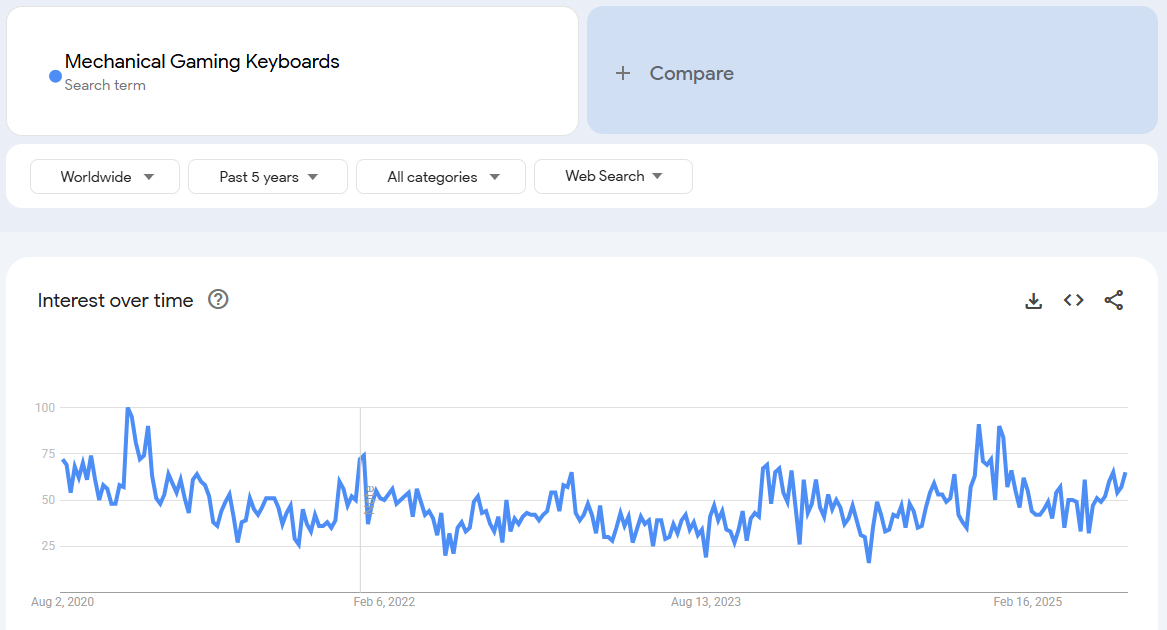
Target audience: PC gamers, programmers, and work-from-home users who want a better typing experience.
Market analysis: The gaming peripherals market has expanded as PC gaming surged. Searches for mechanical keyboards have risen ~40% in the last five years, and related gear like gaming mice up 90% in the same period. Niche communities drive trends like custom keycaps, RGB lighting, and new switch types.
Monthly search volume: ~60,000+ (consistent, with spikes around back-to-school and holiday seasons).
Price range: ~$50–$180. Entry-level boards around $50–$70 (from brands like Redragon), while enthusiast or pro models (Corsair, Razer, custom kits) can approach $150+.
9.VR/AR Headsets and Accessories
Virtual reality and augmented reality devices, including headsets (like Oculus/Meta Quest, Apple Vision Pro) and related gear (controllers, sensors).

Target audience: Tech-savvy early adopters, gamers, enterprise and education sectors (for training/simulation), and VR content consumers.
Market analysis: The AR/VR space is set for exponential growth this decade. By one estimate, the global AR/VR market could soar from ~$30 billion in 2022 to over $520 billion by 2031. Recent product launches (e.g. Apple’s entry into mixed reality) have sparked massive interest. Though current search volume (~40k/mo for “VR headset”) is moderate compared to established electronics, growth is accelerating as more practical use cases emerge.
Price range: Broad – mobile VR viewers as low as $20, popular all-in-one VR headsets ~$300–$600, and enterprise or high-end devices $1,000+. Accessories (face cushions, controller straps) are typically under $50.
10.Drone Cameras (Action Drones)
Compact camera drones and action cams for aerial photography and adventure filming.
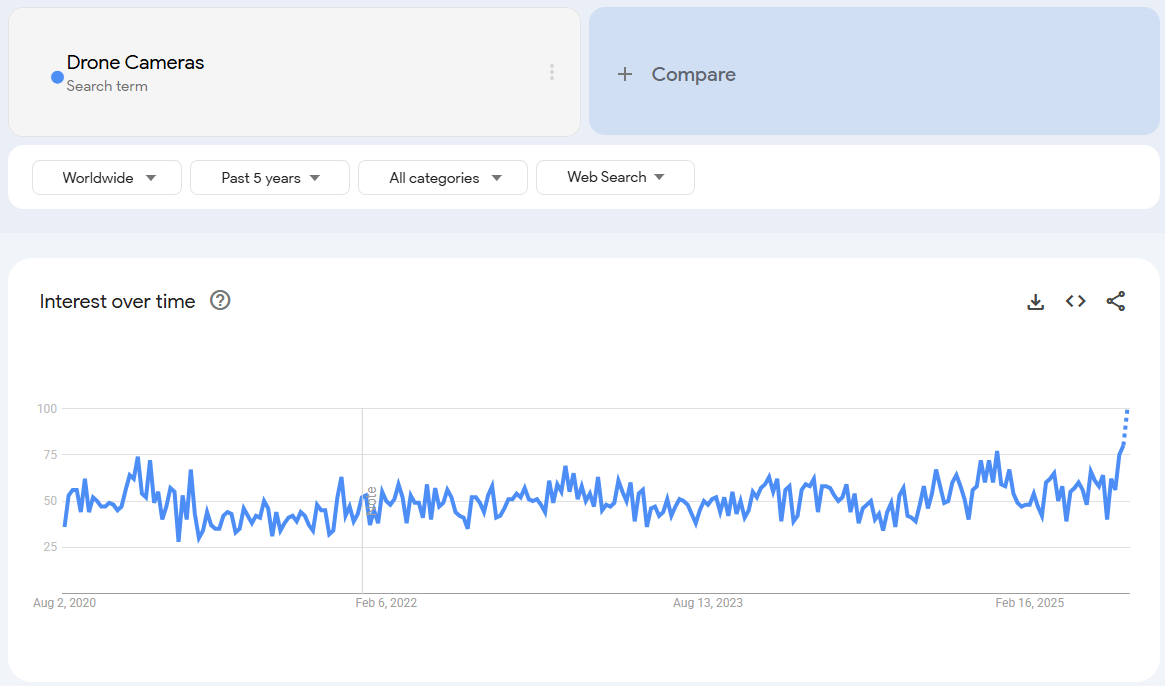
Target audience: Outdoor adventurers, travel bloggers, content creators, and hobbyists capturing sports or travel footage.
Market analysis: User-generated content trends (TikToks, YouTube vlogs) keep these gadgets trending. The camera drone market grows annually as technology improves and prices become accessible. For action cameras, GoPro and competitors see steady demand; for example, GoPro searches spike every summer. These products benefit from social proof – videos shot on drones or action cams go viral, fueling sales.
Monthly search volume: ~50,000 for “GoPro” and strong interest for “drones” (~200k+ including variations).
Price range: Drones vary widely – mini consumer drones $50–$200, advanced 4K drones $500–$1500. Action cameras range ~$100–$400. Many consumers spend ~$300 for a good mid-tier drone or cam.
Best Trending Eco-Friendly & Sustainable Products
1.Beeswax Food Wraps
Reusable cloth wraps coated with natural beeswax, used as an eco-friendly alternative to plastic cling film.

Target audience: Eco-conscious households, zero-waste enthusiasts, and health-conscious consumers avoiding plastics.
Market analysis: As single-use plastic bans spread, these wraps have grown popular for food storage. They cater to the 49% of U.S. consumers who bought a sustainable product in the past month (up from 43% the year prior). Many brands highlight organic materials and compostability, tapping into a global eco-friendly products market expected to double from $355B in 2024 to $692B by 2033.
Monthly search volume: ~12,000 (“beeswax wraps”).
Price range: ~$10–$20 for multi-size pack. Typically $6–$8 each, often sold in 3-packs or kitchen sets.
2.Bamboo Toothbrushes & Utensils
Personal care and kitchen products made from bamboo (e.g. toothbrushes, cutlery, straws).

Target audience: Zero-waste and plastic-free lifestyle followers, and consumers seeking natural product alternatives.
Market analysis: Bamboo’s sustainability (fast-growing, biodegradable) makes it a poster child of eco products. Items like bamboo toothbrushes have become common in eco subscription boxes and are often among the first swaps people make toward green living. They align with consumer demand for plastic-free daily essentials. Many retailers report steady sales growth as more people ditch single-use plastics.
Monthly search volume: ~20,000 for “bamboo toothbrush”, similar for bamboo straws.
Price range: Toothbrush ~$3–$5 each (often in value packs), utensil sets ~$10–$25.
3.Reusable Kitchen Bags & Containers
Silicone food storage bags, beeswax sandwich wraps, and glass or metal tiffins replacing disposable bags and plastic containers.
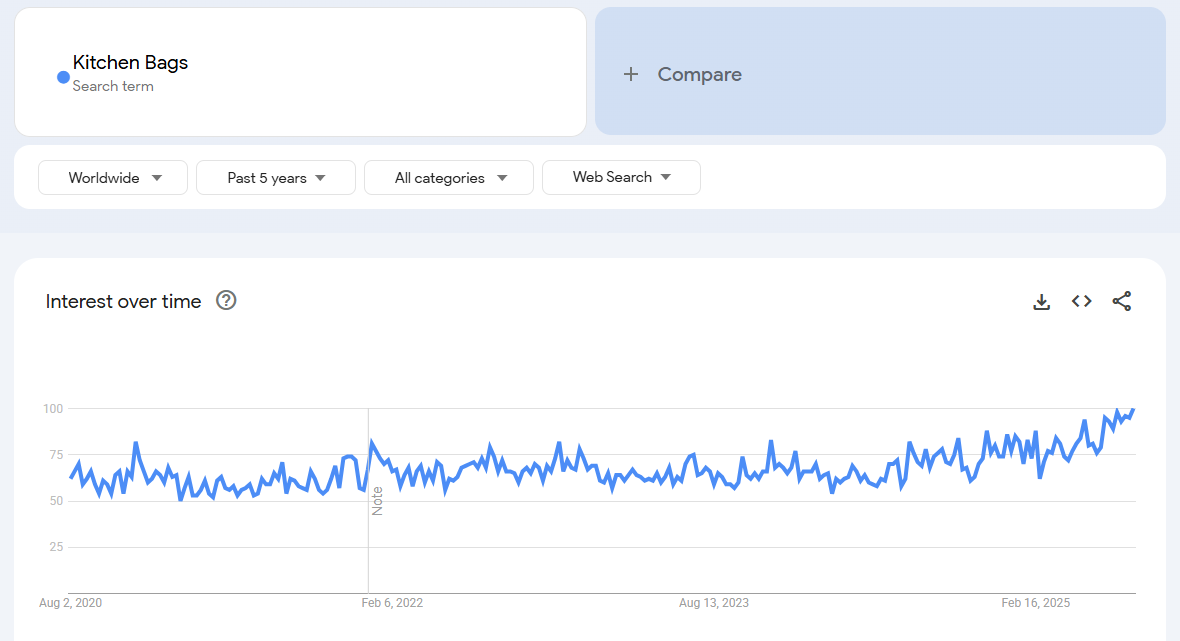
Target audience: Families, meal-prep enthusiasts, and eco-minded shoppers aiming to reduce waste at home.
Market analysis: The kitchen is a major waste generator, so reusable solutions are in high demand. For example, reusable silicone bag searches have surged as consumers tire of buying (and trashing) Ziplocs. Similarly, “#CleanTok” (eco-friendly cleaning) trends on TikTok promote these items. Sustainable kitchenware brands have seen significant growth by marketing durability and long-term savings.
Monthly search volume: ~15,000 (“reusable silicone bags”), plus high engagement on social media.
Price range: ~$10–$20 per silicone bag (multi-packs ~$30+), and ~$20–$40 for stainless lunch boxes or container sets.
4.Wool Dryer Balls
Natural wool balls that soften laundry and reduce drying time, replacing single-use dryer sheets.

Target audience: Homeowners and laundry-doers seeking non-chemical fabric softening and energy savings.
Market analysis: Dryer balls hit the mainstream as an easy eco swap – they’ve been featured by sustainability bloggers and even major retailers. Consumers appreciate that they’re reusable hundreds of times, cut drying time (saving electricity), and eliminate chemical residues on clothes. With rising energy costs and an emphasis on healthier homes, these have strong appeal.
Monthly search volume: ~8,000 (“wool dryer balls”), indicating steady interest.
Price range: ~$10–$20 for a set of 4–6 balls. Often sold in packs (e.g. a $15 pack can last years).
5.Solar-Powered Garden Lights
Outdoor LED lights and lanterns powered by solar panels, for gardens and pathways.
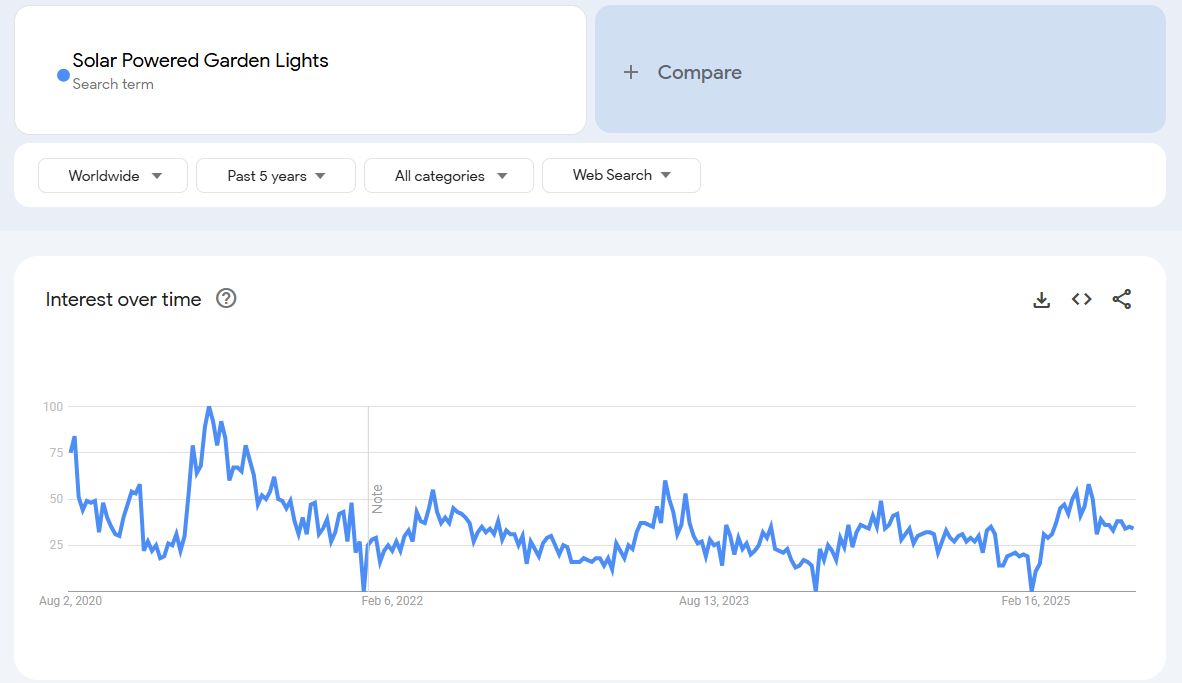
Target audience: Homeowners and gardeners looking to light outdoor spaces without increasing electricity use.
Market analysis: Solar tech has become cheaper and more efficient, boosting adoption. Garden solar lights are popular both for eco reasons and convenience (no wiring). They sell especially well in spring/summer. As interest in sustainable living grows, DIY home improvement and “green landscaping” trends include solar features. Many consumers are also driven by lower utility bills.
Monthly search volume: ~25,000 (“solar garden lights”).
Price range: ~$20–$50 per set (varies by style and quantity in set; basic stake lights can be ~$3 each in multi-packs).
6.Eco-Friendly Cleaning Products
Refills and zero-waste cleaning supplies (e.g. concentrated cleaners, dissolvable pods, plant-based detergents).

Target audience: Households (especially families with kids or pets) seeking non-toxic, sustainable cleaning solutions.
Market analysis: The cleaning aisle is undergoing a green revolution. A majority of consumers now deliberately choose products with sustainable packaging and ingredients. Brands offering refillable bottles or compostable packaging (like detergent sheets, powder concentrates) are trending. Social media (the #CleanTok community) has helped viral-marketing these products.
Monthly search volume: ~10,000 (“eco friendly cleaner”), but growing via word-of-mouth.
Price range: Comparable to traditional cleaners: ~$5–$15 per unit (often slightly higher price offset by longer-lasting concentrates or multi-use kits).
7.Stainless Steel Water Bottles
High-quality metal bottles (often insulated) as a sustainable alternative to disposable plastic bottles.
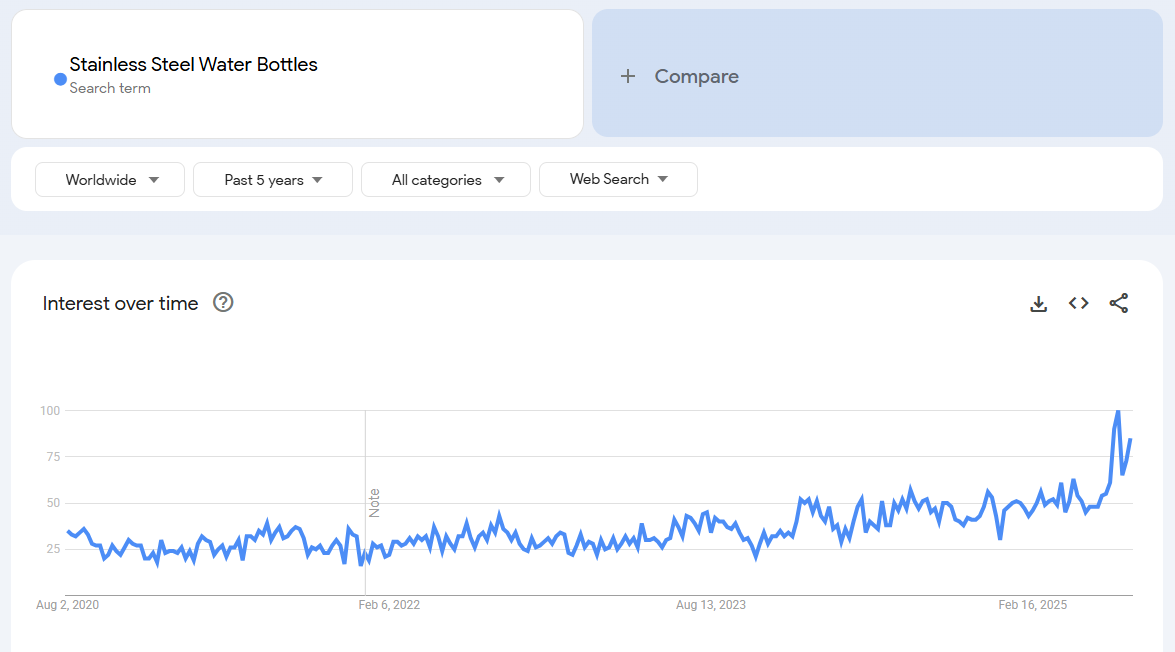
Target audience: Virtually everyone – from students to professionals – especially those into fitness, travel, or simply staying hydrated sustainably.
Market analysis: Reusable water bottles are now mainstream and continue to grow in popularity. Consumers are willing to pay a premium for good bottles; in fact, they’re willing to pay up to 59% more for sustainable products like these. The category is huge (estimated global market of over $10B) with viral brands (e.g. Hydro Flask, Yeti, Stanley).
Monthly search volume: ~60,000 (“stainless steel water bottle”).
Price range: ~$15–$40 for most, with top insulated brands around $30–$50. Lower-cost generic bottles exist ~$10, but many opt for trusted quality even at higher prices.
8.Eco-Friendly Phone Cases
Phone cases made from biodegradable or recycled materials (such as plant-based bioplastics, cork, or reclaimed ocean plastic).

Target audience: Smartphone owners (especially younger users) who want device protection without contributing to plastic waste.
Market analysis: Over 1.3 billion phone cases were sold in 2024, and a growing chunk are eco-friendly. The global eco-friendly phone case market (~$1.3B in 2024) is forecast to reach $3.7B by 2033, reflecting robust demand. Consumers enjoy that these cases are stylish and functional, while aligning with their values. Many are also drawn by brand missions (e.g. Pela Case’s ocean plastic mission).
Monthly search volume: ~5,000 (“biodegradable phone case”), but climbing as awareness increases.
Price range: ~$20–$45, slightly higher than basic plastic cases, but customers justify it for sustainability.
9.Reusable Straws & Cups
Metal or silicone straw sets, and portable coffee cups/tumblers meant to replace disposables.
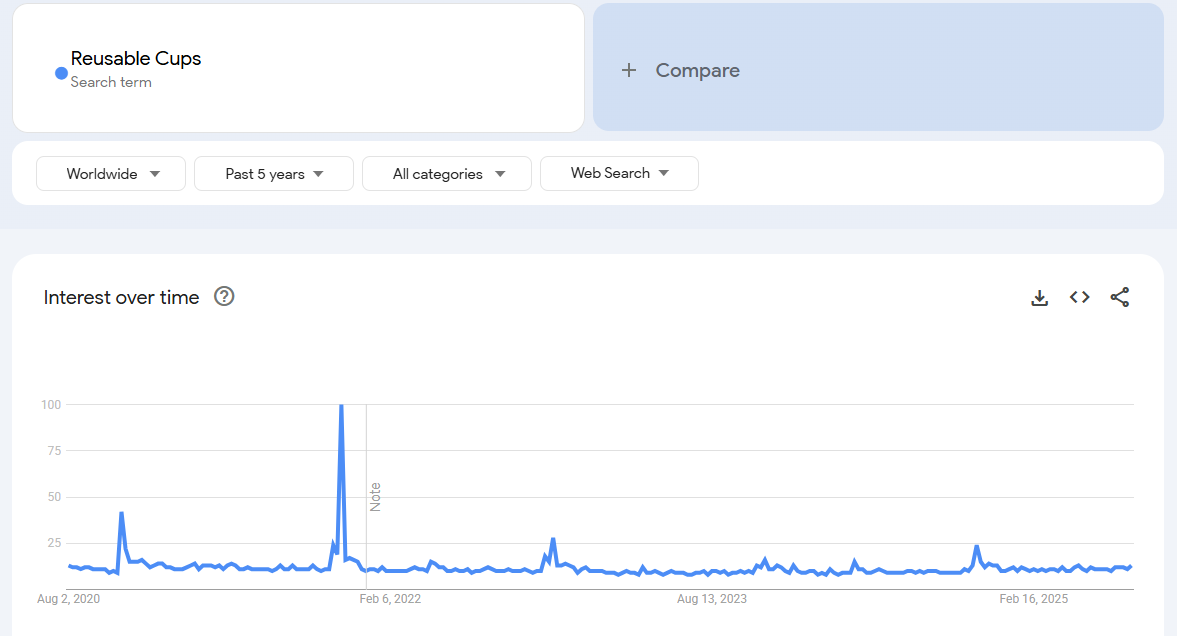
Target audience: Urban commuters, coffee/tea drinkers, and anyone looking to cut single-use waste in their daily routine.
Market analysis: Ever since cities started banning plastic straws, reusable straw sales spiked. On Instagram and TikTok, reusable cups with aesthetic designs are often featured by influencers. The “Bring your own cup” movement has even been encouraged by some cafés (sometimes with discounts). Hydration trends also play a role – the viral success of items like the Stanley Quencher tumbler (a social media sensation) shows people crave stylish, sustainable drinkware.
Monthly search volume: ~20,000 (“reusable straws”), “travel coffee mug” ~30,000.
Price range: Straws ~$5–$15 (for multi-packs with cleaning brushes), insulated reusable cups ~$15–$30.
10.Refillable Personal Care Products
Items like refillable deodorant sticks, shampoo bars (no plastic bottle), or systems where you buy one container and refill concentrate or pods.
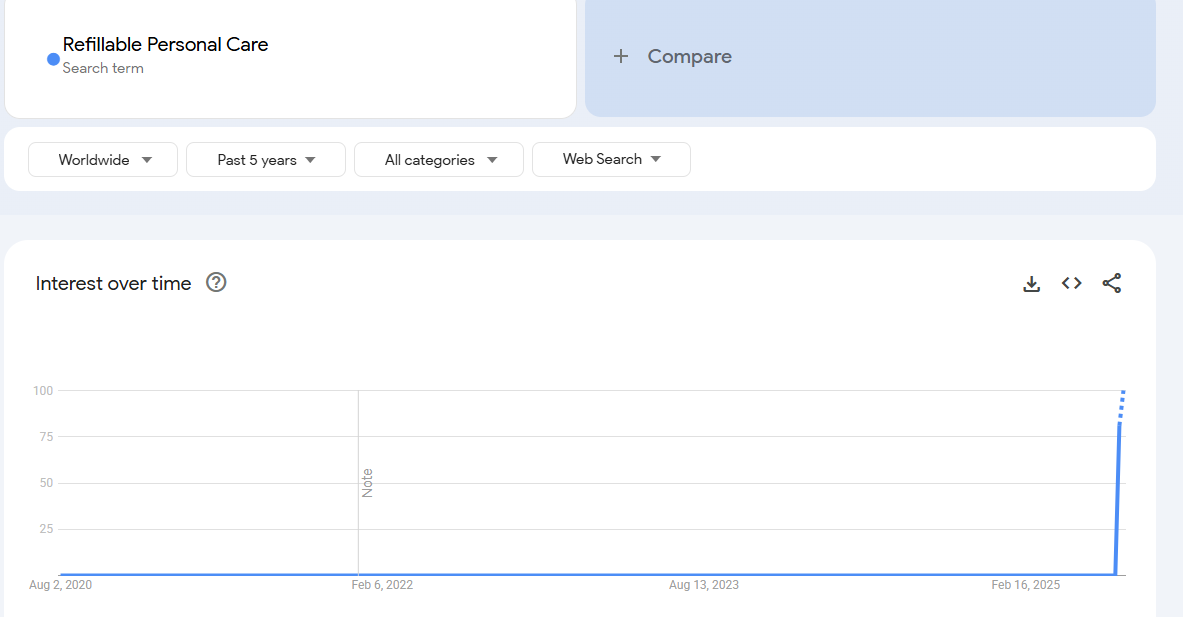
Target audience: Sustainability-minded consumers in beauty and personal care, including Gen Z and millennials highly concerned with waste.
Market analysis: Refill culture is rising: major brands have launched refill stations or mail-back refill schemes. Skincare and beauty refills are especially hot – 62% of U.S. consumers are interested in personalized beauty products, and many indie brands offer custom formulations in refillable packaging. Solid shampoos and refillable deodorants (like Myro, Dove’s refill line) gained traction as people sought to cut down bathroom plastic.
Monthly search volume: ~5,000 (“refillable deodorant”) but growing steadily.
Price range: Typically initial kit ~$10–$20, with refills slightly cheaper than buying new each time (e.g. deodorant refills $8 vs $12 initial with case).
Best Trending Health & Wellness Products
1.ADHD & Nootropic Supplements
Vitamins and supplements marketed to improve focus, memory, or stress for those with ADHD or busy lifestyles (often containing omega-3, magnesium, ginkgo, etc.).
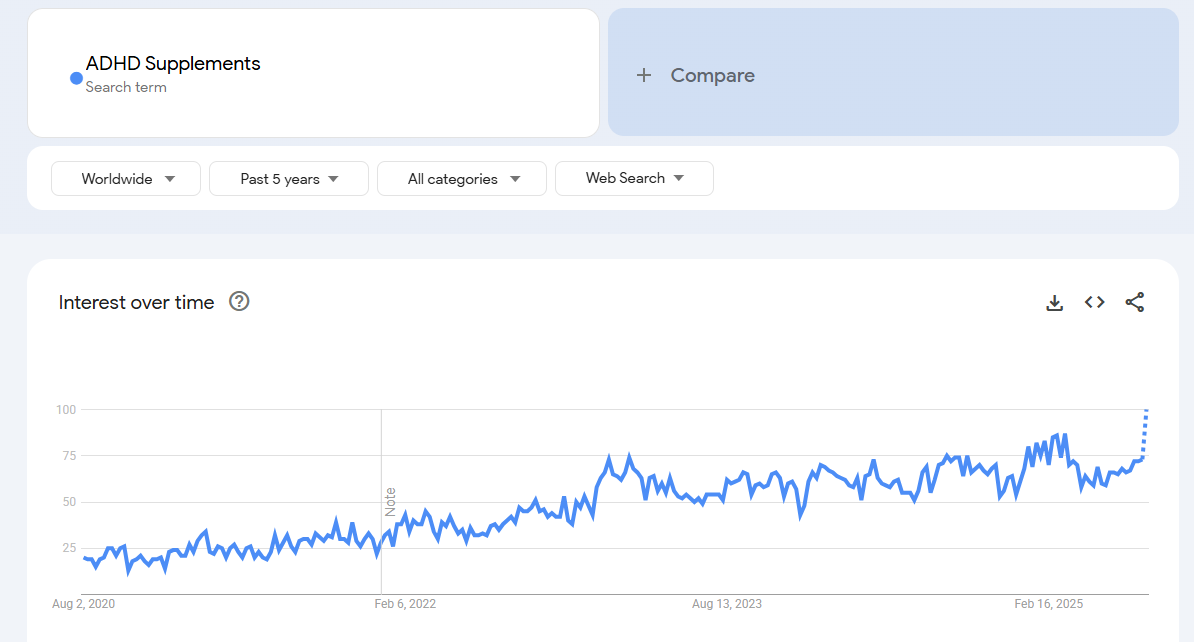
Target audience: Adults (and sometimes parents of teens) looking for natural concentration aids or cognitive boosters, including the nootropics community and wellness enthusiasts.
Market analysis: Interest in brain health supplements has spiked as awareness of adult ADHD and “biohacking” grows. For instance, search interest in ADHD supplements has more than doubled since 2018. While actual search volume is relatively niche (~220/mo), the trend is significant – bolstered by the popularity of nootropics in general. Blogs and forums buzz about alternatives to medication, driving sales of focus pills and gummies.
Monthly search volume: ~200–300 (“ADHD supplement”) – small but rapidly growing.
Price range: ~$15–$60 per bottle (30-day supply), depending on formulation and brand.
2.Functional “Superfood” Gummies
Gummies enriched with trendy ingredients like mushroom extracts, turmeric, apple cider vinegar, collagen, or melatonin for health benefits.
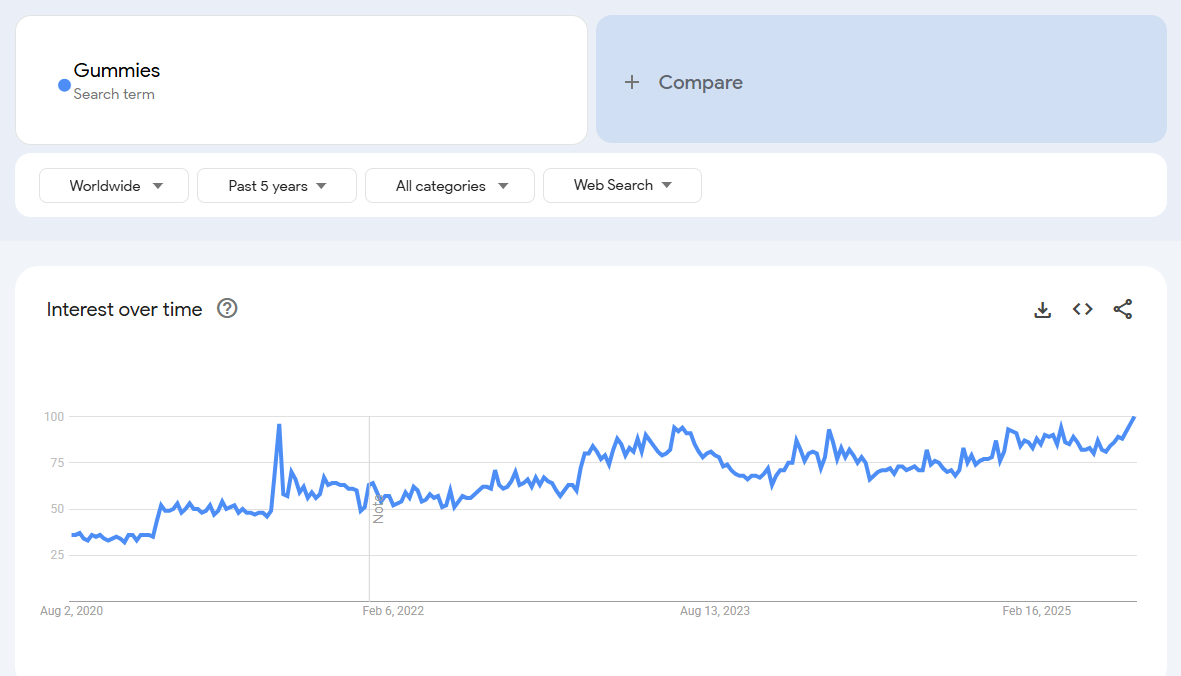
Target audience: Millennials and Gen Z who prefer convenient, candy-like supplements over pills – targeting various goals (immunity, sleep, skin health, etc.).
Market analysis: The gummy vitamin market is exploding. Over the past year, searches jumped for things like “best collagen gummies” and “mushroom gummies”. In fact, mushroom gummies saw a 75% spike in interest recently, as people explore alternatives for immunity and wellness. TikTok is a huge driver here: billions of views for videos on wellness hacks have normalized taking daily gummies.
Monthly search volume: e.g. ~5,000 for “turmeric gummies”, ~12,000 for “apple cider vinegar gummies”. Collectively substantial.
Price range: ~$10–$25 per bottle (usually a month’s supply). People often don’t hesitate to pay around $20 for a tasty supplement if it promises results.
3.Ashwagandha and Herbal Teas
Herbal teas or powders featuring adaptogens like ashwagandha, reishi, chamomile, etc., marketed for stress relief and relaxation.
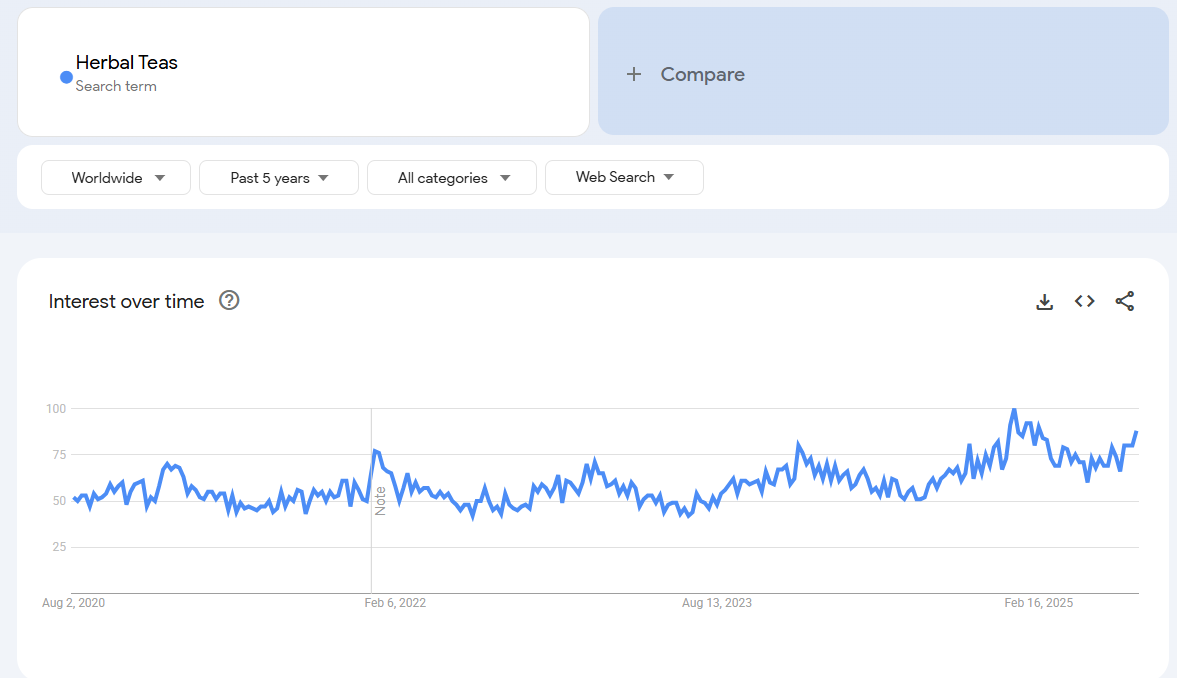
Target audience: Stressed professionals, students, and wellness seekers interested in natural remedies for anxiety and better sleep.
Market analysis: Adaptogenic herbs have gone mainstream. Ashwagandha in particular is trending: it’s being added to teas, lattes, and gummies. Ashwagandha tea has about 27,100 monthly searches, reflecting its rising popularity as “one of the most convenient ways to consume ashwagandha”. Viral social media posts tout its benefits for stress and cortisol reduction. Health food stores and even big-box retailers now carry these products, validating their demand.
Price range: ~$5–$15 for a box of herbal tea bags, or $20+ for bulk powders/extracts. Given the broad appeal, many buyers are willing to pay for premium organic blends.
4.Collagen Peptides & Beauty Supplements
Collagen powders, biotin gummies, vitamin C, and other ingestible beauty products for skin, hair, and nails.
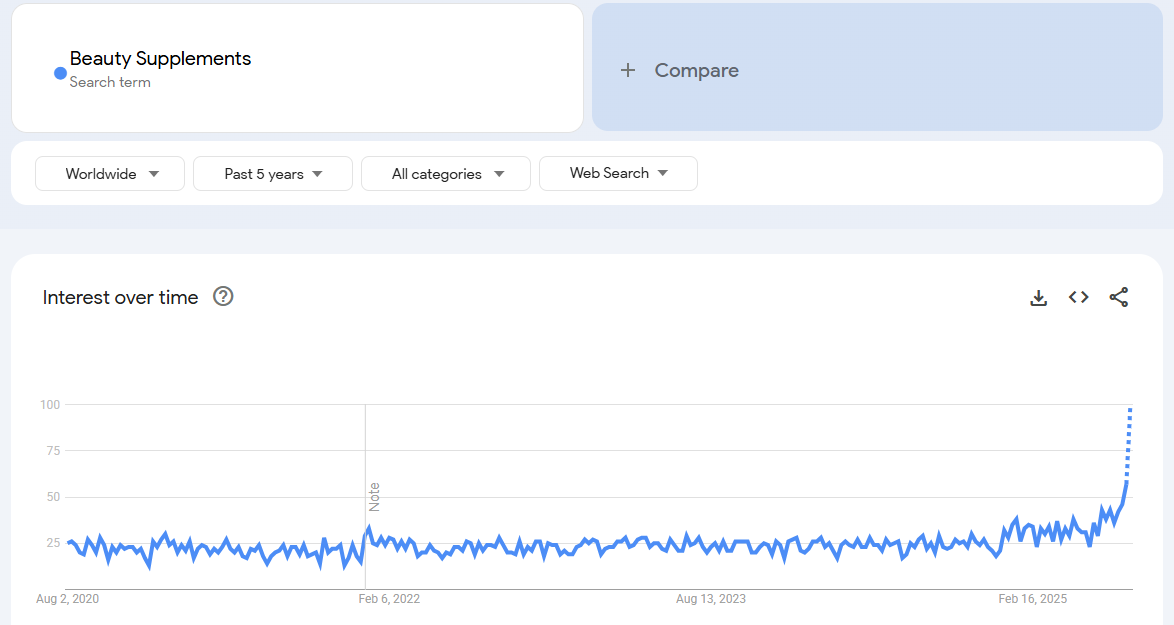
Target audience: Primarily women 25–50 interested in beauty-from-within, plus older consumers looking to improve skin elasticity or joint health.
Market analysis: The “ingestible beauty” category keeps growing even in economic slowdowns – a phenomenon dubbed the “skincare index” where people treat themselves to small wellness luxuries. Collagen is a star: search queries like “best collagen supplement for women” have spiked in the last year. Globally, the collagen market (including supplements) is booming thanks to social media testimonials and visible results.
Monthly search volume: ~40,000 (“collagen powder”) – consistently high.
rice range: ~$20–$45 for a month’s supply of collagen peptides or multi-vitamins. Many purchase on a subscription basis, delivering recurring revenue.
5.Percussion Massage Guns
Handheld massage devices that deliver rapid percussive therapy to muscles (for recovery, pain relief, etc.).
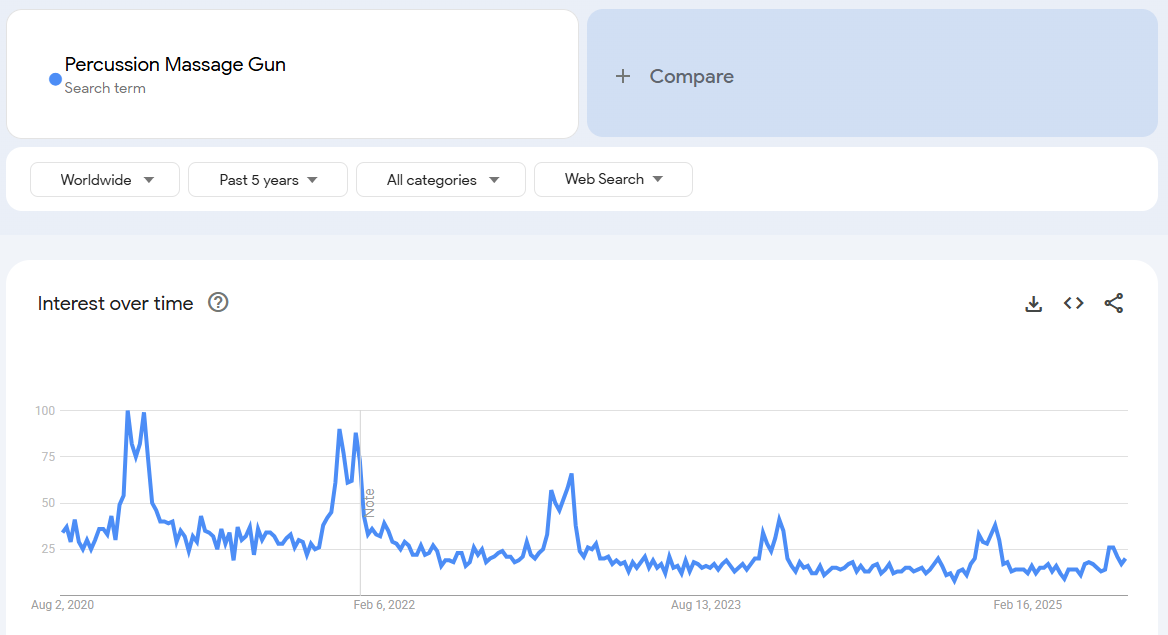
Target audience: Athletes, fitness enthusiasts, physical therapy patients, and anyone with muscle tension (including office workers with back/neck pain).
Market analysis: Massage guns have moved from pro athletes to the mass market. Search interest in “massage gun” grew modestly (~2% last year) but volume is huge – around 872,000 searches per month as of 2025. The market, valued about $1.5B in 2025, is projected to reach $3.7B by 2035. Consumers appreciate that these devices offer a portable deep-tissue massage at home; they became especially popular during lockdowns when spa access was limited.
Monthly search volume: ~870k (very high).
Price range: ~$50 for budget models, $200–$400 for top brands (Theragun, Hyperice). The sweet spot for quality and affordability is about $100–$150, which many are willing to invest for health.
6.Red Light Therapy Devices
Wearable belts or panels that emit red/infrared light, used for muscle recovery, fat loss, skin health, or pain relief.
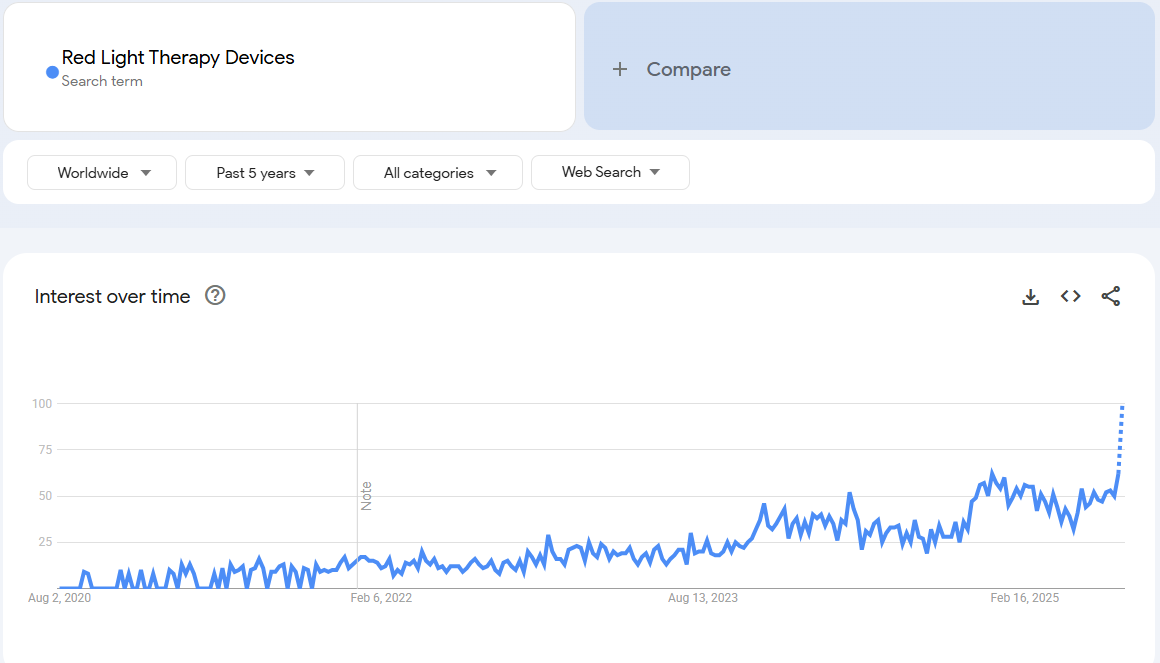
Target audience: Biohackers, gym-goers, chronic pain sufferers, and beauty/wellness consumers looking for non-invasive therapies.
Market analysis: Once exclusive to clinics, red light therapy has entered homes via compact gadgets. Interest is skyrocketing – e.g., searches for red light therapy belts are up an astonishing 9,800% in 5 years. Current search volume is around 3,600/mo, and rising fast. These devices promise a high-tech solution to common issues (sore muscles, wrinkles), appealing to an aging but active population. They often appear in “recovery hack” videos on YouTube and TikTok.
Price range: ~$50–$200 for belts and small panels. Consumers comparing to costly spa treatments find this price reasonable for unlimited at-home use.
7.Home Fitness Gear (Yoga & Pilates)
Items like yoga mats, resistance band sets, foam rollers, and yoga blocks.
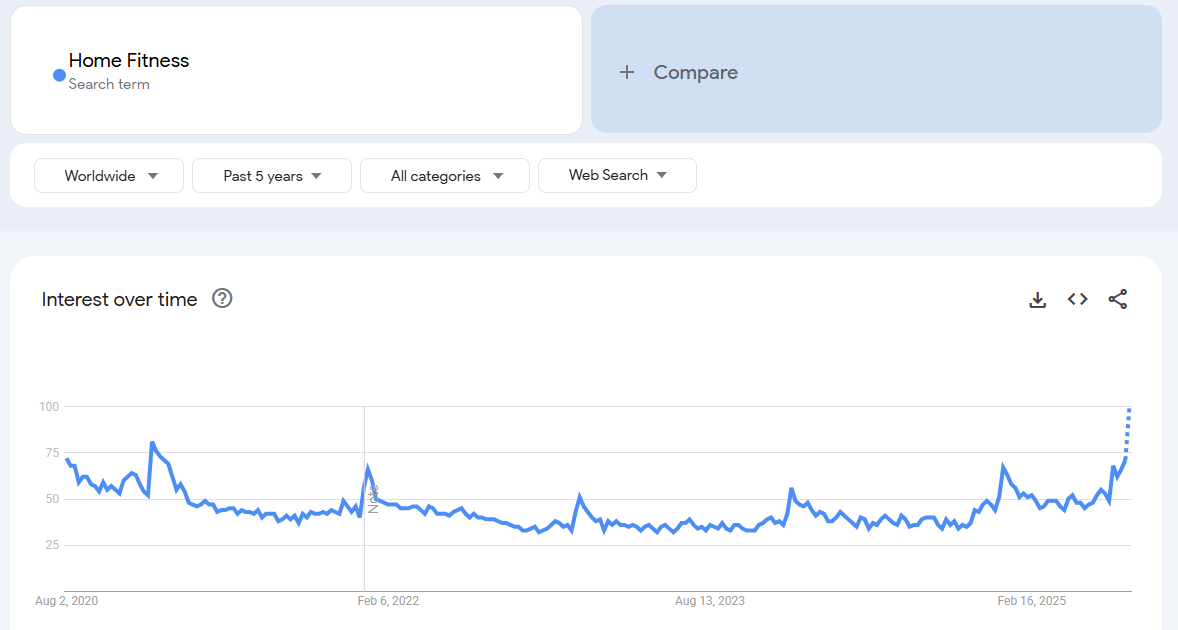
Target audience: Home workout enthusiasts, yogis, and those supplementing gym routines with at-home exercise (a trend that persisted post-pandemic).
Market analysis: The home fitness niche remains strong. While gym reopenings slowed equipment sales a bit, many have permanently adopted hybrid fitness habits. Yoga apparel and gear see steady demand – Google Trends shows sustained interest year-round for yoga mats and accessories. In the past 12 months, some specific trends emerged: searches for “cotton yoga clothes” up 110% and “flare yoga pants” up 70%, indicating people expanding their yoga lifestyle. Foam rollers and resistance bands often spike around New Year and summer as people ramp up fitness goals.
Monthly search volume: ~50,000 (“yoga mat”), ~20,000 (“resistance band set”).
Price range: Yoga mats ~$20–$60 (eco-friendly materials on higher end), band sets ~$10–$30, rollers ~$15–$40.
8.Sleep Improvement Aids
Products like weighted blankets, sleep gummies, white noise machines, and smart sleep trackers.
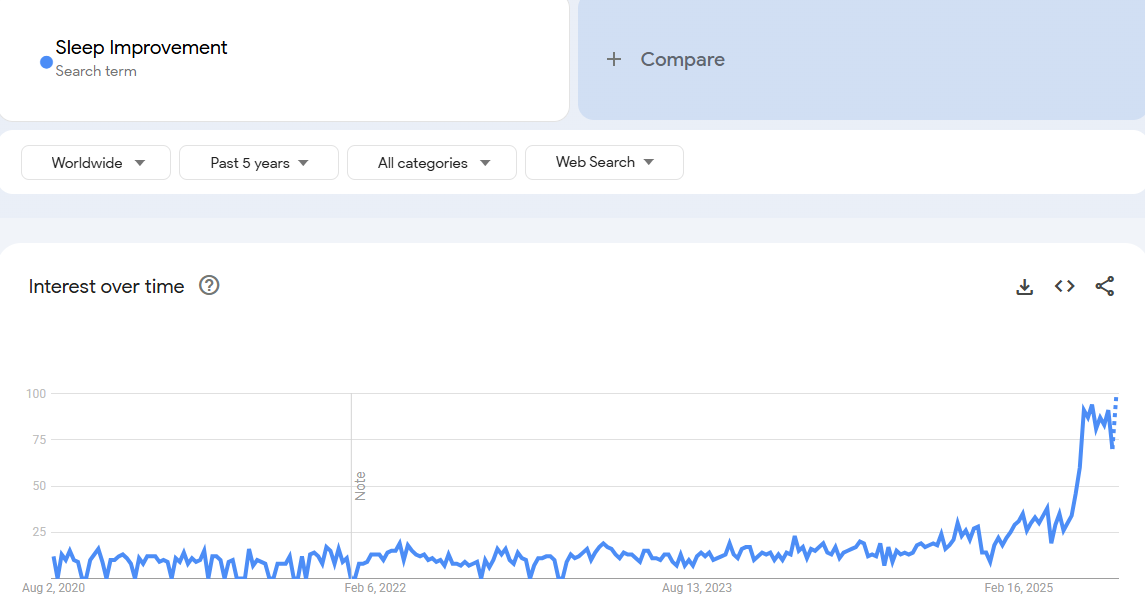
Target audience: Individuals with insomnia or anxiety, and generally anyone prioritizing better sleep (a huge wellness focus across ages).
Market analysis: Sleep economy is booming as consumers treat quality rest as essential to health. Weighted blankets, for example, became a $1B+ industry after going viral a few years back; they remain popular for stress relief (weighted sleep sacks for infants are also trending, with interest growing as a safer alternative for babies). Sleep supplements like melatonin or magnesium gummies have also risen sharply (interest in “sleep gummies” has climbed per Google Trends). Additionally, devices like sunrise alarm clocks and sleep trackers sell well – even during economic dips, people invest in small comforts to improve daily life.
Monthly search volume: ~60,000 (“weighted blanket”), ~30,000 (“melatonin gummies”).
Price range: Weighted blankets ~$50–$120 (varies by weight/brand), sleep gummy jar ~$10–$20, white noise machine ~$20–$50.
9.Personal Health Monitors
Smart health monitoring devices beyond wearables – e.g. smart blood pressure monitors, portable EKG devices, blood glucose monitors (for wellness), or digital posture trainers.

Target audience: Health-conscious adults, seniors managing chronic conditions at home, and caregivers.
Market analysis: Empowered by telehealth and personal data trends, people are proactively tracking health metrics. For instance, at-home blood pressure cuffs and pulse oximeters saw a surge during the pandemic and the habit stuck. These devices often rank high in Amazon’s health device sales. The market also sees innovation: devices that sync with smartphone apps for long-term tracking are especially popular (e.g., FDA-approved mobile EKGs). With an aging population in many countries, demand for home health tech is on a long-term upswing.
Monthly search volume: ~40,000 (“blood pressure monitor”), ~12,000 (“EKG monitor”).
Price range: $30–$100 for most digital health monitors; high-end smart versions (with Bluetooth/app integration) at the upper end.
10.Mental Wellness & Meditation Aids
Products to support mental health, such as meditation cushions, sound bath bowls, stress relief fidget toys, or mindfulness journals.
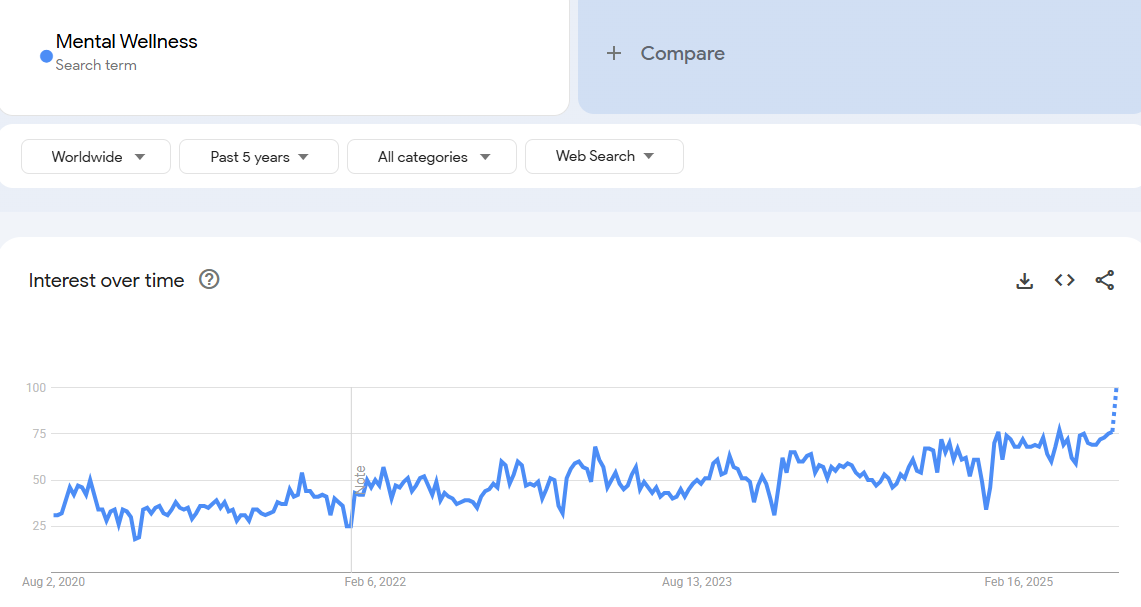
Target audience: Stressed professionals, students, and anyone into self-care routines or therapy adjuncts.
Market analysis: The destigmatizing of mental health has opened a market for tangible products that help reduce stress. For example, adult fidget/sensory toys (e.g. stress balls, fidget cubes) have become common office items. Meditation accessories are selling more as meditation apps go mainstream – a comfortable cushion or a Tibetan singing bowl can enhance a home practice. On social media, hashtags like #MentalHealth and #SelfCareSunday often feature these products. Companies are even providing employees with wellness kits (which might include items like calming lamps or journaling tools).
Monthly search volume: ~10,000 (“meditation cushion”), but interest is fragmented across many different items.
Price range: Fidget gadgets ~$5–$20, meditation cushions ~$30–$70, therapy lamps ~$40–$100. Many consumers consider it a worthy investment for peace of mind.
Best Trending Fashion & Accessories Products
1.Oversized Streetwear
Oversized t-shirts, hoodies, and jackets that prioritize comfort and style.

Target audience: Gen Z and Millennials embracing casual streetwear and work-from-home comfort, plus anyone following urban fashion trends.
Market analysis: The pendulum has swung from skinny fits to baggy silhouettes. In fact, searches for oversized tees jumped 150% in the last 5 years (hoodies up 100% too). Influenced by both high fashion (think Balenciaga style) and everyday comfort, oversized apparel is a dominant trend. It’s big in streetwear and K-fashion, and it aligns with the unisex, body-positive movement (loose fits for all).
Monthly search volume: ~40,000 (“oversized hoodie”).
Price range: T-shirts ~$20–$50 (depending on if branded or designer collab), hoodies ~$30–$90. Streetwear brands often charge a premium, but plenty of affordable options exist.
2.Athleisure Matching Sets
Coordinated athletic wear sets (e.g. leggings with sports bra or joggers with sweatshirt) that transition from gym to everyday wear.

Target audience: Women and men 18–40 who want stylish yet comfortable outfits for workouts, errands, and lounging.
Market analysis: Athleisure isn’t just a trend – it’s a lifestyle category with constant demand. To stand out, newer styles focus on “elevated basics” and matching sets. Searches for “athleisure sets” are up 350%, indicating shoppers want put-together looks rather than mismatched separates. Consumers expect technical performance and fashion-forward designs (think sleek cuts, neutral palettes). This trend is bolstered by remote work and the wellness movement – people want clothes that support an active routine and look good on Instagram.
Monthly search volume: ~25,000 (“matching workout set”).
Price range: ~$40–$100 per set (some fast-fashion sets on lower end, premium active brands on higher end).
3.Wide-Leg & Barrel Jeans
Relaxed-fit denim, including wide-leg, barrel cut, and “dad” jeans that move away from skinny styles.

Target audience: Young adults, especially fashion-forward women, plus older demographics happy that comfy jeans are back.
Market analysis: The return of 90s and Y2K fashion has made loose jeans the denim style of the moment. Retailers report surges in sales of these cuts. Notably, “barrel fit jeans” searches skyrocketed 500% recently as this curved-leg style gained traction. Wide-leg pants broadly have seen a ~40% increase in search interest in the past year. Consumers enjoy the blend of vintage vibe and comfort – these jeans are often high-waisted, flattering, and pair well with crop tops (another trend).
Monthly search volume: ~30,000 (“wide leg jeans”).
Price range: ~$30–$80 for most fast fashion or mall brands; $100+ for premium denim lines. Given denim’s durability, many are willing to invest in a good pair.
4.Nostalgic Y2K Fashion Items
Accessories and apparel inspired by late 90s/early 2000s style, like baguette bags, claw hair clips, tiny sunglasses, and baby tees.
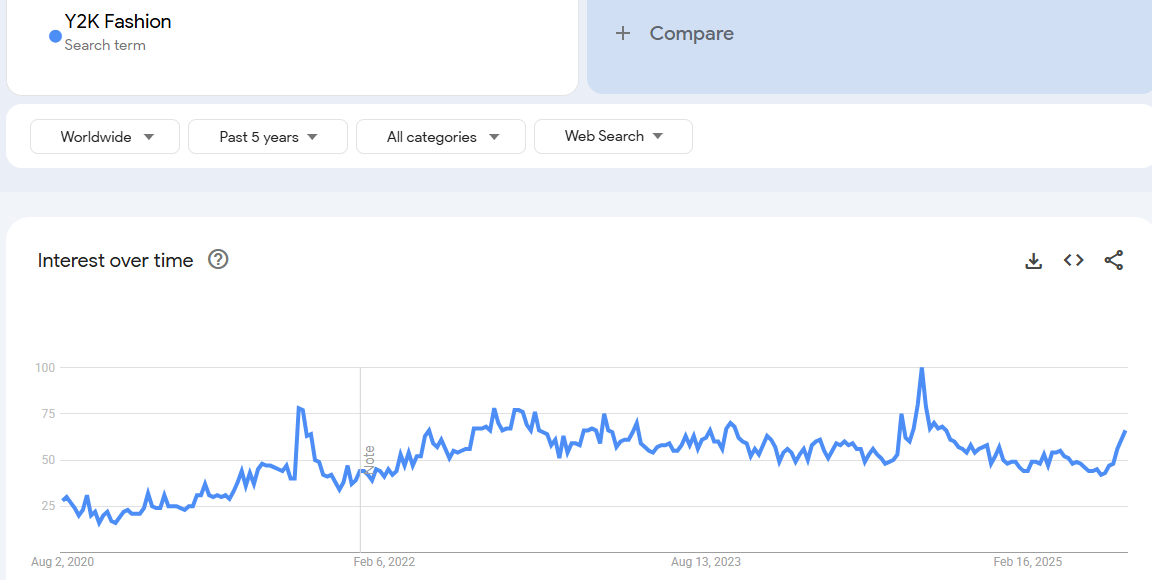
Target audience: Primarily Gen Z (teens and early 20s) reveling in early 2000s nostalgia they never lived, and Millennials revisiting the trends of their youth.
Market analysis: The Y2K revival is in full swing on TikTok and Depop. Thrifted and vintage items are highly sought, and fast fashion has jumped on the aesthetic. Think butterfly clips, low-rise cargos, rhinestone logos – fun, kitschy pieces are trending again. For example, claw clip hair accessories went from mom-item to must-have, selling out at Urban Outfitters last year. Brands that originally thrived in that era (Juicy Couture, Ed Hardy) have reappeared through collabs.
Monthly search volume: ~60,000 (“Y2K fashion”) though many specific items trend individually (e.g. “baguette bag” ~10k searches).
Price range: Accessories $5–$30 (often inexpensive impulse buys), apparel $20–$70 (plenty of affordable options, though some nostalgic designer collabs can cost more).
5.Personalized Jewelry (Name/Initial Pieces)
Jewelry featuring personalization, such as nameplate necklaces, initial pendants, and zodiac or birth year designs.

Target audience: Gift buyers, teens, and women 15–35 who love custom, meaningful accessories.
Market analysis: Personalized jewelry is evergreen but currently very trendy due to social media and influencer culture. Shoppers want unique pieces that express identity. Men’s jewelry is growing too, with interest in minimalist chains and signet rings on the rise. The overall jewelry market is huge (valued at $242B globally) and set to reach ~$344B by 2032, and personalization is a key driver. Many D2C brands (like Mejuri, etc.) offer engraving or initials as options, meeting the demand.
Monthly search volume: ~20,000 (“name necklace”), spikes around holidays.
Price range: Costume/fashion jewelry $15–$40, plated or sterling silver $50–$100, solid gold fine pieces $200+. Plenty of accessible options exist, which fuels impulse gift purchases.
6.Trucker & Bucket Hats
Stylish hats from retro trucker caps with mesh backs to 90s-style bucket hats.
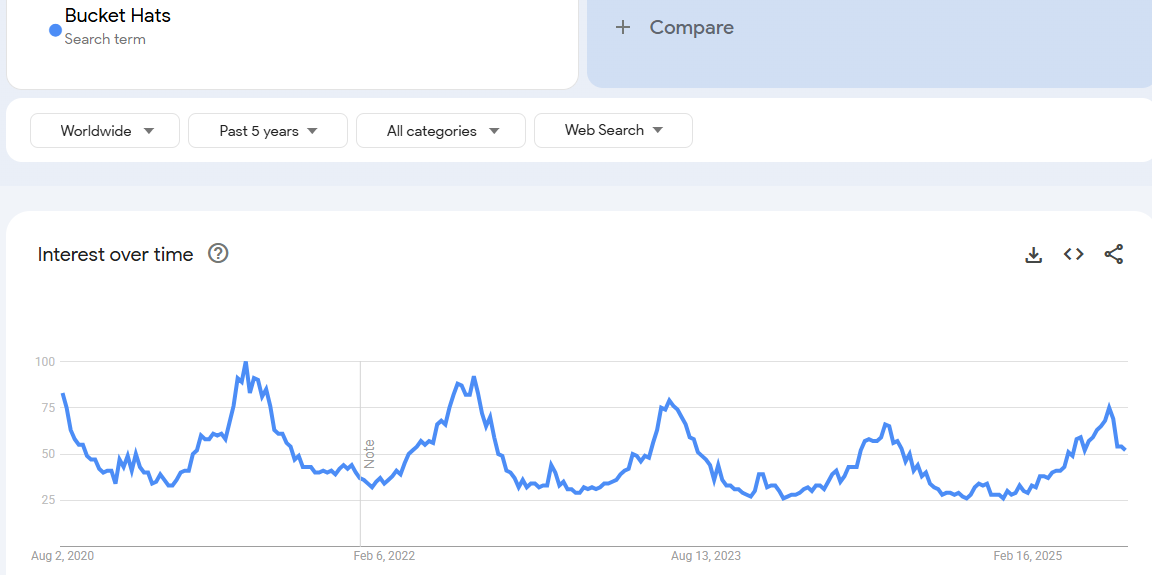
Target audience: Trend-conscious teens and young adults, festival goers, streetwear fans.
Market analysis: Hats have made a big comeback as fashion statements. Seasonal shifts drive interest (beanies in winter, caps in summer), but trend-wise: Trucker hats (especially for men) saw interest grow 450% in 5 years, and bucket hats (especially for women) jumped 350%. Celebrities sporting throwback Von Dutch trucker caps or tie-dye bucket hats have amplified this. They’re also popular merchandising items (with logos or funny sayings) on platforms like Etsy.
Monthly search volume: ~30,000 (“bucket hat”), ~15,000 (“trucker cap”), with summer peaks.
Price range: ~$10–$30 (streetwear collabs or luxury brand versions can go higher). Generally a low-cost accessory, which encourages collection of multiple styles.
7.Sustainable & Ethical Fashion
Apparel made from organic, recycled, or upcycled materials (e.g. organic cotton basics, recycled polyester activewear, vegan leather bags).

Target audience: Eco-conscious consumers, often 18–40, who seek stylish clothing that aligns with their values.
Market analysis: Sustainability is a major force in fashion for 2025. Many shoppers now consider how and where clothes are made. There’s rising demand for items like organic cotton or hemp clothing, and ethically made accessories. For example, searches for “sustainable fashion” and “ethical brand” hit all-time highs recently. Big retailers have launched conscious collections, and startups are thriving by being transparent about sourcing. While not every consumer will pay more for sustainability, a significant segment will – especially as climate awareness grows.
Monthly search volume: ~10,000 (“sustainable clothing”), but the trend permeates many specific product searches too.
Price range: Often slightly premium – e.g. organic cotton t-shirt $30 vs $15 fast fashion. However, many consumers justify the extra cost as an investment in quality and ethics. There’s also a burgeoning resale market (thrifting apps etc.) as part of this movement.
8.Swimwear (Inclusive & Sustainable)
Trendy swimsuits including couples’ matching swimwear, sustainable fabric bikinis, and diverse sizing one-pieces.
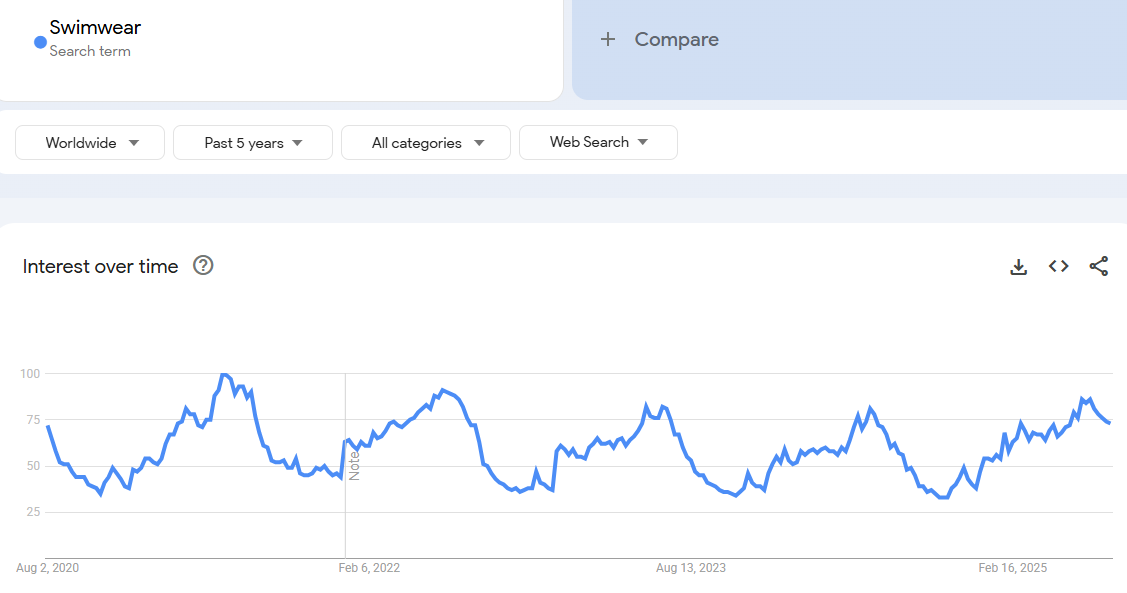
Target audience: Beach-goers and vacationers (teens through adults) wanting Instagrammable swim looks, as well as eco-conscious shoppers. Market analysis: Swimwear is no longer just seasonal – thanks to year-round vacations and content creation. Two big trends:
Matching swim sets for couples/groups (searches up 700% in 5 years!) which reflects the social media “twinning” culture, and sustainable swimwear (search interest up 450%) as buyers ask what their suits are made of. Additionally, inclusivity in size and style is crucial; brands offering extended sizes and adaptive fits are winning loyalty. Each summer brings viral swim trends (remember the high-waist bikini craze, etc.).
Monthly search volume: ~50,000 (“bikini” or “swimsuit”), with huge seasonal spikes.
Price range: Fast fashion bikinis ~$20–$40, mid-range $50–$100 per set, luxury or eco-friendly ~$100–$150. Many consumers mix high and low pieces or invest in one good suit per season.
9.Sneakers (Retro & Niche Collabs)
Popular sneaker styles, especially retro re-releases (Air Jordans, Nike Dunks, New Balance 550s) and limited-edition collaborations (artists, streetwear brands).
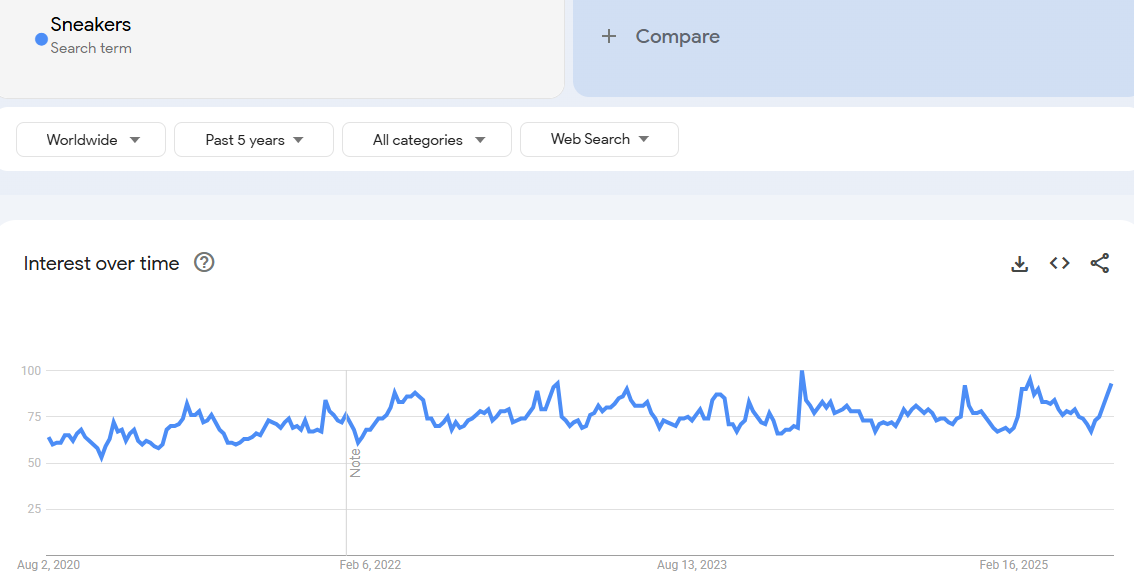
Target audience: Sneakerheads (collectors) and mainstream casual wearers globally – skewing male 15–35 but increasingly unisex.
Market analysis: Sneakers remain one of the top-selling fashion items worldwide. In the US, sneakers and boots rank in the top 10 products sold by Shopify merchants. The trend cycle currently favors retro silhouettes (80s–90s basketball shoes, chunky dad sneakers) and collabs that create hype (each drop often sells out instantly). Resale marketplaces like StockX indicate demand: many sneakers appreciate in value post-release. With comfy footwear now acceptable in most settings, everyday sneaker demand is robust too.
Monthly search volume: “Nike Air Force 1” ~90k, “Air Jordan” ~100k+, etc. Consistently massive interest. Price range: Retail $70–$200 for most, but aftermarket can balloon prices of hot releases. General consumers spend ~$60–$120 on fashion sneakers, while enthusiasts will pay $300+ for limited pairs.
10.Embroidered & Customized Apparel
Clothing with embroidery details or customized prints (e.g. embroidered denim jackets, monogrammed caps, or made-to-order graphic tees).
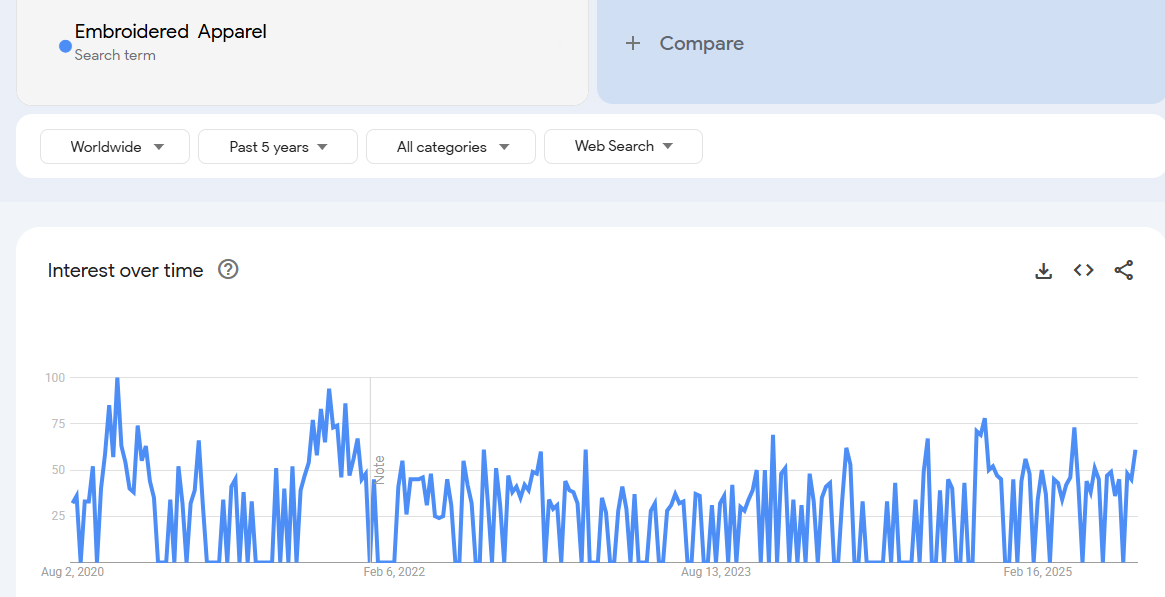
Target audience: Fashion-savvy individuals who want unique pieces, as well as gift buyers (for monogrammed items).
Market analysis: Customization is a big appeal in fashion now. Embroidery in particular has an artisanal, premium vibe – and it’s Instagram-friendly. On Instagram, #embroidery has 31+ million posts, showcasing how shareable and popular embroidered designs are. Print-on-demand services have made one-off custom tees and hoodies easily accessible, fueling a market for personalized statement clothing (say a niche meme or personal slogan on a shirt). Consumers love wearing something not everyone can get off a rack.
Monthly search volume: ~8,000 (“custom hoodie”), but platforms like Etsy have tens of thousands of monthly searches for specific custom clothing styles.
Price range: Standard tees $20–$35 with custom print, embroidered apparel $40–$100 depending on complexity (since embroidery often costs a premium). Many customers are willing to pay extra for a personal touch or limited-run design.
Best Trending Home & Kitchen Products
1.Throw Blankets & Quilts
Cozy blankets, particularly those that are decorative (for couches/beds) and seasonal.
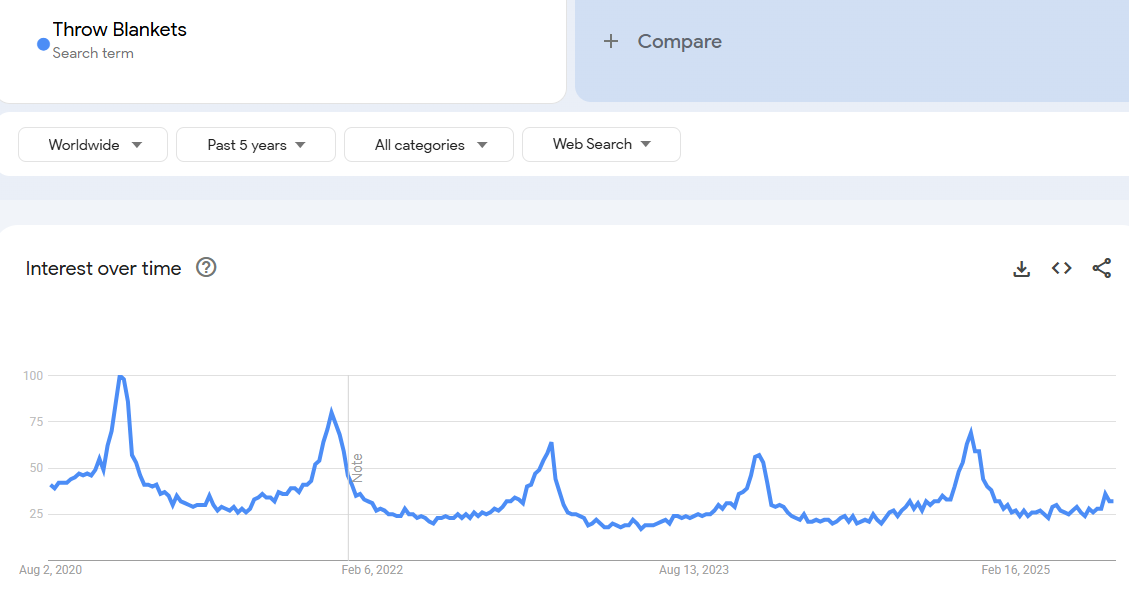
Target audience: Home decorators, gift buyers, and anyone looking to amp up comfort in their living space (including the huge work-from-home cohort).
Market analysis: Blankets have become a year-round seller with a spike in cooler months. Over the last 5 years, searches for throw blankets for couches skyrocketed 350% (and up 50% in the last year alone). This is tied to the nesting trend – people investing in home ambiance – and social media (plenty of “cozy vibe” posts feature chunky knit throws). Personalized and holiday-themed blankets also do well (e.g. Halloween or Christmas throws).
Monthly search volume: ~60,000 (“throw blanket”), peaking in Q4.
Price range: ~$20–$60 for standard throws; higher for hand-knit, weighted, or designer blankets. Generally an affordable luxury, making them popular gift items.
2.Scented Candles & Home Fragrance
Candles (especially soy or natural wax), aromatherapy diffusers, and candle gift sets.

Target audience: Practically everyone – but notably millennials and Gen Z who indulge in self-care rituals, as well as gift shoppers.
Market analysis: The candle craze is burning strong. The global candle market is projected to reach $13B by 2033. Beyond just scents, candles are now seen as an expression of personality and mood (hence niche scents like “bookshelf” or zodiac-themed candles trend online). Consumers value natural ingredients – eco-friendly candles made of soy or beeswax and housed in reusable jars are on the rise. Customizable candles (personalized labels, birthdate scents) are also trending, aligning with the personalization wave.
Monthly search volume: ~90,000 (“scented candles”).
Price range: Small indie candles ~$10–$15, popular brands $20–$40, luxury candles $50+. Many buyers are willing to pay more for unique scents or aesthetically pleasing jars since candles double as decor.
3.Air Fryers & Kitchen Gadgets
Air fryers (countertop convection cookers) and related trendy gadgets like Instant Pot multi-cookers and bread makers.

Target audience: Home cooks, busy parents, health-conscious individuals who want “fried” food with less oil.
Market analysis: Air fryers have been a top-selling kitchen appliance for a few years and continue to trend upward. Google searches for “air fryer” jumped 45% in the past year, showing that interest hasn’t cooled off. With more folks cooking at home, any gadget promising convenience or healthier comfort food gets attention. Social media recipes (TikTok has countless viral air fryer recipes) further boost sales. Similarly, multi-cookers and specialized gadgets (like electric pressure cookers, yogurt makers) ride the same wave of home culinary exploration.
Monthly search volume: ~450,000 (“air fryer”), consistently high.
Price range: ~$50–$150 for air fryers (larger capacity and smart features at higher end). Many decent models around $100, which consumers find reasonable for daily-use appliances.
4.Milk Frothers & Coffee Accessories
Electric milk frothers, pour-over coffee makers, French presses, and other at-home barista tools.
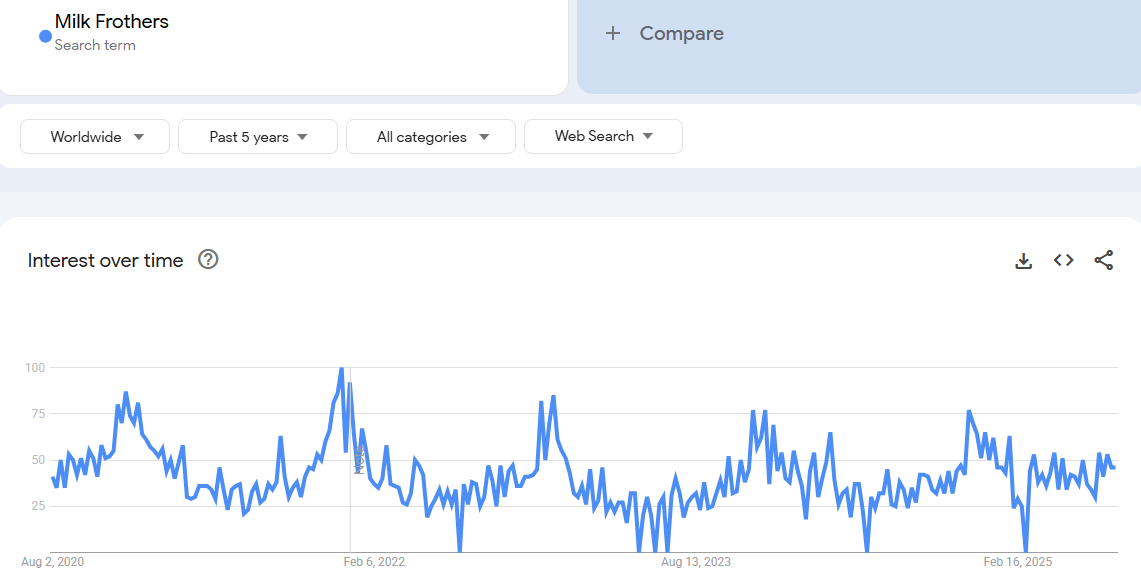
Target audience: Coffee and tea lovers, especially millennials who want café-quality drinks at home.
Market analysis: Thanks to the “coffee culture” and months of café closures in 2020, people invested in home coffee setups. Milk frothers saw a 17% increase in search interest over the past year as dalgona coffee and latte art challenges took off on social media. Manual pour-over drippers (like Chemex or ceramic cones) are also beloved by the artisan coffee crowd. The trend encompasses everything from reusable coffee filters to aesthetic mugs – essentially, making the morning coffee an experience.
Monthly search volume: ~20,000 (“milk frother”), ~50,000 (“French press”).
Price range: Handheld frothers ~$15–$25, electric jug frothers ~$40–$80. Pour-over drippers ~$20–$40, French press ~$20–$60. Many shoppers add multiple accessories to cart, upgrading their coffee corner piece by piece.
5.Insulated Tumblers & Water Jugs
High-capacity insulated cups and jugs (often with handles and straws) for water and beverages, exemplified by the viral Stanley Quencher tumbler.
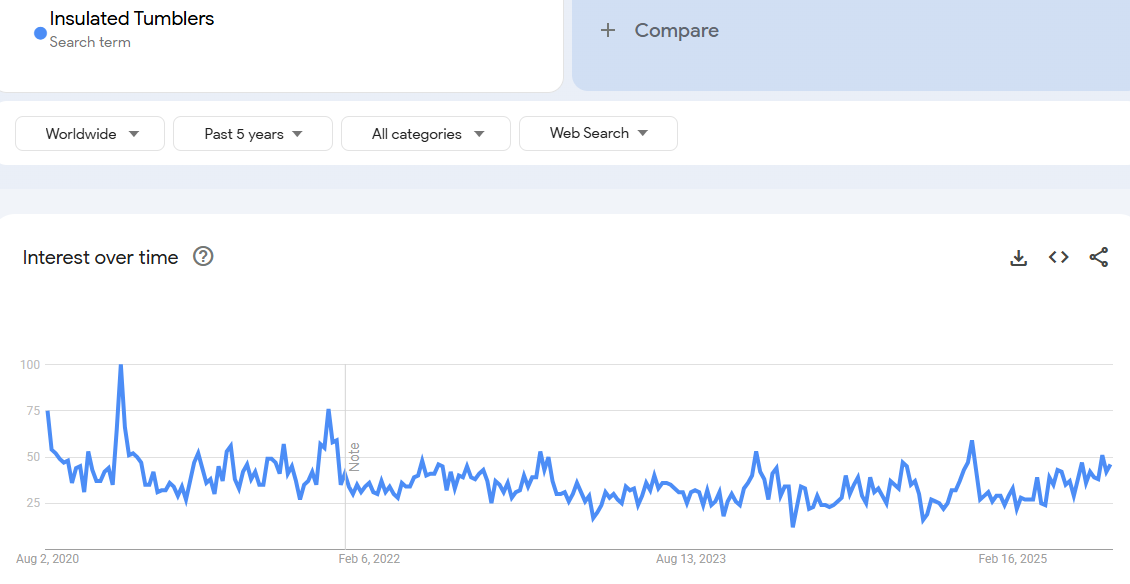
Target audience: On-the-go individuals, fitness enthusiasts, and the TikTok generation that turned a water jug into a status symbol.
Market analysis: Hydration is trendy – in part due to wellness fads and influencer product placements. The Stanley Quencher, for instance, became a viral sensation thanks to social media influencers. It dominated the Home & Kitchen category on Amazon and spawned waitlists. Interest in hydration and aesthetically pleasing drinkware has risen in recent years. Other brands like Owala and HydroJug have also surged. These products address both function (keep drinks cold all day) and form (stylish designs, many color options).
Monthly search volume: ~30,000 (“Stanley tumbler”) – huge given it’s a specific brand, plus lots of organic chatter.
Price range: ~$30–$50 for the major brand tumblers (40oz stainless steel with insulation). Cheaper dupes exist ~$20, but many consumers splurge on the known brands for quality and clout.
6.Smart LED Lighting
App-controlled LED light strips, smart bulbs, and RGB floor lamps that can change color and mood.

Target audience: Young adults, gamers, content creators, and homeowners modernizing their space with tech.
Market analysis: Smart lighting is an intersection of home decor and tech that’s exploded in popularity – especially among Millennials and Gen Z who use it for ambiance in bedrooms, gaming setups, and TikTok backgrounds. Products like color-changing LED strip lights went viral as a must-have room accessory. The global smart lighting market is growing steadily as prices drop; people love the convenience of voice/app control and the fun of custom colors. On TikTok, #LEDlights and room transformations gather billions of views.
Monthly search volume: ~70,000 (“LED light strips”), with consistent interest.
Price range: LED strip kits ~$15–$30, smart bulbs ~$10–$20 each, designer smart lamps ~$60–$120. They’re relatively affordable upgrades, which encourages impulse buying for room makeovers.
7.Filtered Shower Heads
Shower heads with built-in filtration to remove chlorine and minerals, often also high-pressure or multi-setting for a spa-like experience.

Target audience: Homeowners and renters looking to improve water quality for skin/hair benefits, and those seeking a luxury shower feel on a budget.
Market analysis: Bathroom upgrades are trending as part of the broader home wellness theme. A 2-in-1 filtered shower head ranks among “trending home improvement products” because it merges function (cleaner water) and indulgence (better showers). Consumers who notice hard water effects (dry skin, dull hair) are eager to try these relatively low-cost solutions. Sales tend to spike during spring (home improvement season) and again in late fall (when indoor pampering increases).
Monthly search volume: ~12,000 (“filtered shower head”).
Price range: ~$25–$60. Many good models are around $40 – a convincing value proposition for the promised benefits (often confirmed by glowing online reviews).
8.Modular Storage Organizers
Home organization products like stackable pantry bins, under-sink organizers, closet drawer systems, and pegboards.
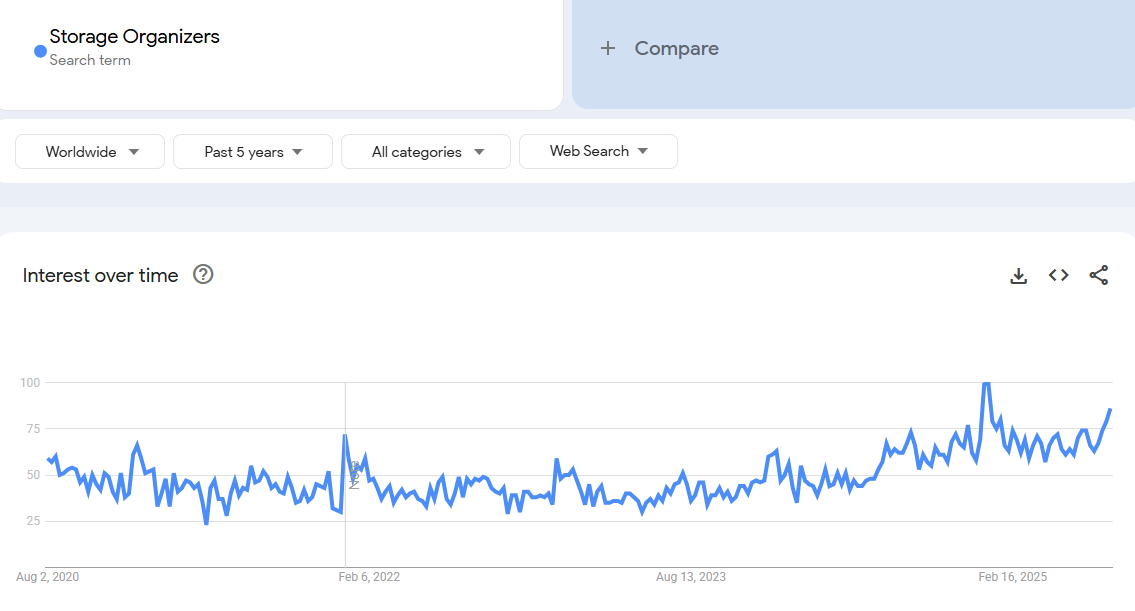
Target audience: Home organizers (inspired by influencers like The Home Edit), apartment dwellers maximizing small spaces, and really anyone aiming for a tidy home.
Market analysis: The organization craze is still in full swing. Netflix shows and Pinterest boards have made storage solutions hot sellers. Clear plastic pantry bins, for example, frequently sell out at retailers after trending on Instagram. The demand for under-sink and closet organizers jumped as people spent more time at home and decided to declutter. These products often have viral moments (like the time a TikTok of a fridge perfectly organized with clear bins got millions of likes).
Monthly search volume: ~20,000 (“pantry organizers”), ~15,000 (“closet organizer”).
Price range: Small bin sets ~$10–$20, multi-piece organizer systems $30–$80. Consumers usually buy multiple units to fully revamp a space, which can lead to high average order values.
9.Air Purifiers
Portable HEPA air purifiers for homes, some with smart features, targeting allergens, pollution, and now even germs.
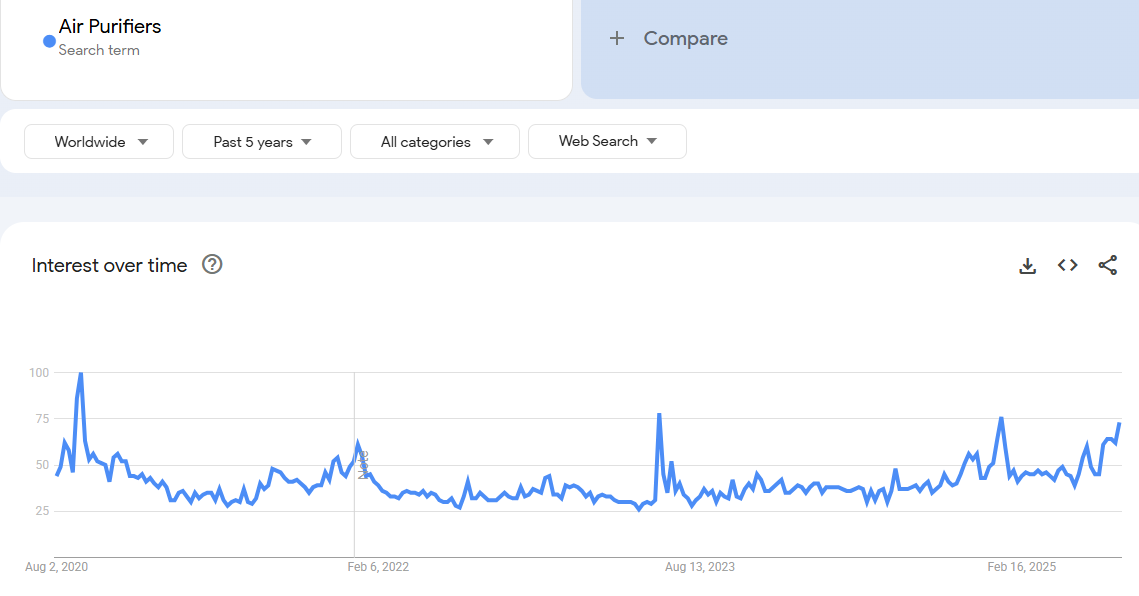
Target audience: Urban residents, allergy sufferers, parents of young children, pet owners – anyone concerned about indoor air quality.
Market analysis: Growing worries about air quality (from wildfires, pollution, to pandemic-era indoor safety) have driven air purifier sales. The U.S. air purifier market is set to expand from $4.5B in 2024 to $6.8B by 2030, a robust growth trajectory. Consumers see these devices as essential, not a luxury, especially in regions hit by seasonal smoke or high pollen. Searches and sales peak during such events (e.g., a spike during West Coast fires). Modern purifiers also emphasize design – becoming part of home decor rather than an eyesore.
Monthly search volume: ~50,000 (“air purifier”), with episodic surges.
Price range: Budget desktop purifiers ~$50, popular mid-room models $100–$200, high-end smart or whole-house units $300+. Many households are willing to invest in a reliable brand for peace of mind.
10.DIY Art & Wall Decor
Home decor items that allow personalization, such as DIY gallery wall frame sets, paint-by-number kits for adults, or custom wallpaper decals.

Target audience: Renters and homeowners in their 20s–40s who want to spruce up their spaces affordably, and hobbyists who enjoy creative projects.
Market analysis: With the continual Instagram/TikTok home tours, people are inspired to decorate their walls uniquely. Sales of gallery frame sets (to create an insta-worthy photo wall) are strong, and “wall art” as a category shows steady growth in interest. In fact, with so many working remotely, individuals want interesting backdrops for video calls – fueling decor upgrades. DIY art kits (like paint-by-number canvases aimed at adults) surged during lockdowns and remain popular for their relaxing, creative appeal.
Monthly search volume: ~40,000 (“wall art”), ~10,000 (“paint by number kit adult”).
Price range: Frame sets ~$30–$60, wall decal kits ~$20–$40, paint kits ~$15–$30. These products are relatively low-cost for the visual impact they provide, which makes them quick sellers.
Best Trending Pet Products
1.Smart Pet Feeders
Automatic pet feeding devices (many app-controlled) that dispense food or water on schedules.
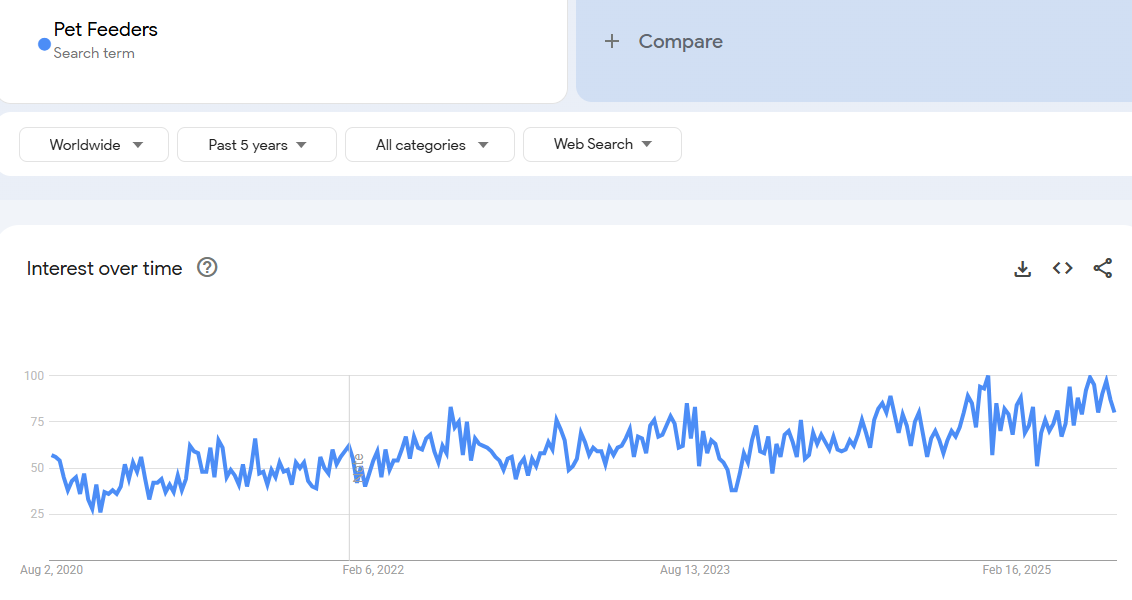
Target audience: Pet owners with busy schedules, travelers, or tech-savvy folks who love monitoring their pet’s meals remotely.
Market analysis: With pets truly treated as family, owners spare no expense to ensure their well-being. Smart feeders saw rising adoption; globally the automatic pet feeder market is predicted to grow from $2.3B in 2024 to $6.9B by 2034. This growth is fueled by urbanization (more pet parents juggling work) and the convenience of IoT devices. Social proof: countless YouTube videos show cats and dogs excitedly using feeders, indirectly marketing them. They often pair with pet cams – another trending product – to let owners virtually “check in” on feeding time.
Monthly search volume: ~8,000 (“automatic pet feeder”), climbing steadily.
Price range: ~$70–$150 for quality smart models (basic gravity feeders are cheaper but smart features command a premium).
2.Stylish Pet Bowls & Feeding Stations
Elevated dog bowl stands, stainless steel or ceramic bowls in chic designs, and slow-feeder bowls for fast eaters.

Target audience: Dog and cat owners who want pet essentials that blend with home decor or solve pet feeding issues.
Market analysis: Even something as simple as a pet bowl has gone upscale. Searches for stainless steel cat bowls are up 110% and for dog food/water bowls up 150% over the last year. Drivers include health (stainless steel and ceramic are preferred to plastic) and aesthetics (modern stands that look like furniture). Raised feeders are popular for larger or older dogs (for comfort), and slow-feeder designs are a hit among owners of gulping pets to aid digestion. Instagram pet accounts often showcase these cute feeding setups, influencing others.
Monthly search volume: ~12,000 (“dog bowl stand”), ~8,000 (“slow feeder bowl”).
Price range: Standard bowls ~$10–$25, designer or elevated sets $30–$75. Many pet owners will pay more for durability and style, considering it a long-term item.
3.Pet Health Supplements
Vitamins, probiotics, CBD treats, and omega-3 fish oil supplements for pets.
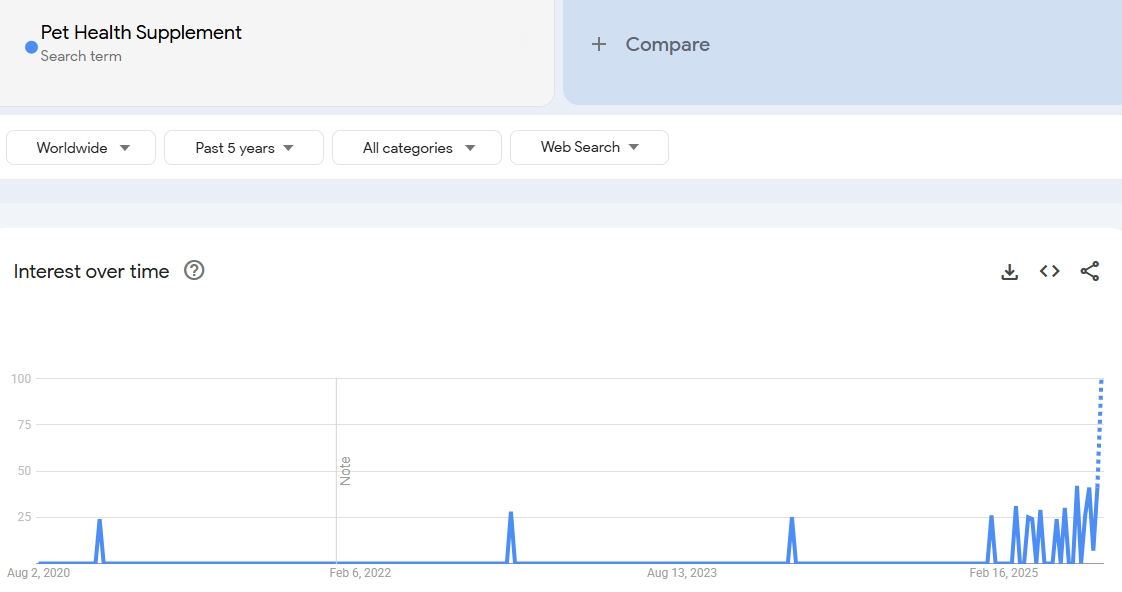
Target audience: Pet parents of aging pets or those with specific health concerns (joint support, skin/coat, anxiety), and generally anyone treating their pet’s health proactively.
Market analysis: Mirroring human wellness trends, the pet wellness sector is booming. Pet supplements (like hip & joint chews or calming treats) are increasingly part of pets’ routines. In the last year, searches like “pet probiotic” or “dog calming chews” have trended upward, and pet health supplement sales have gained momentum. Notably, the push toward natural and holistic pet care drives this – e.g., opting for CBD chews for anxiety instead of medication. The pet supplements market is expected to continue robust growth as more owners view pets like their children (and thus, worthy of premium care).
Monthly search volume: ~6,000 (“dog vitamins”), ~10,000 (“CBD for dogs”).
Price range: ~$15–$40 per bottle/bag. Many opt for subscription purchases for continuous supply if they see benefits, which signals good retention if the product works.
4.Pet Travel Accessories
Items like car seat protectors, booster seats for small dogs, pet travel carriers, and portable water bottles for pets.
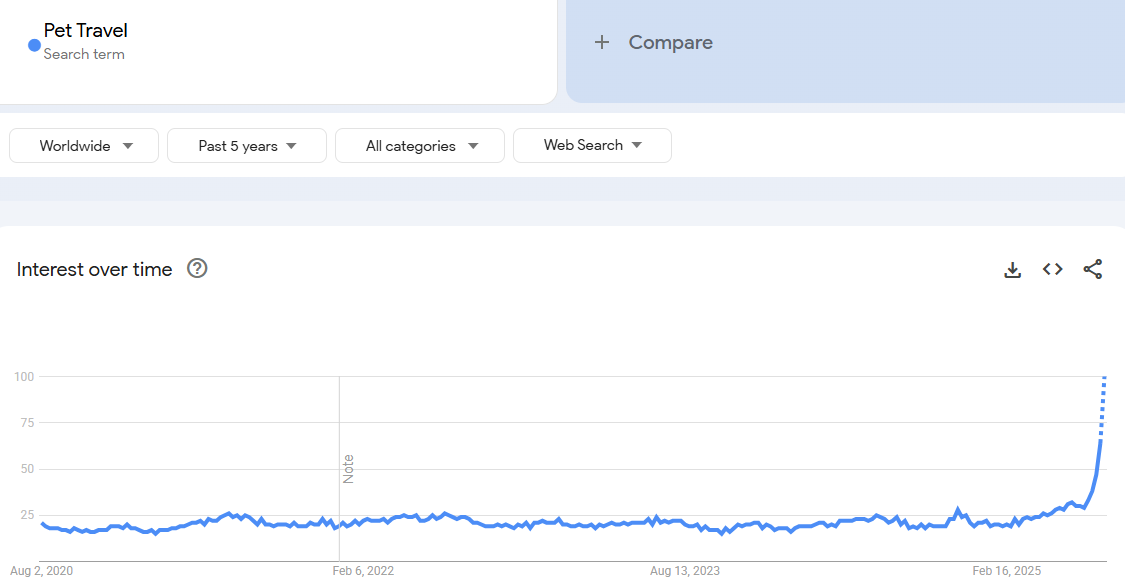
Target audience: Pet owners who frequently travel or take road trips with their pets, and those who include pets in outdoor activities.
Market analysis: As more pet owners consider their pets as constant companions, products enabling safe and convenient travel have spiked. For instance, dog car booster seats and hammocks surged in popularity following viral TikToks of dogs riding comfortably in cars. Many airlines and hotels being pet-friendly now also means carriers (especially stylish, airline-approved ones) are in demand. Google Trends shows steady growth in searches for “dog car seat” and “pet travel bottle” over the past couple of years. Pet-friendly travel blogs and social communities further amplify this trend, sharing product recommendations widely.
Monthly search volume: ~9,000 (“dog car seat”), ~5,000 (“pet travel water bottle”).
Price range: Car seat covers ~$25–$50, booster seats ~$40–$80, soft travel carriers ~$30–$100 depending on size/brand.
5.Cat Litter & Accessories
High-performance litters (clumping, dust-free, natural litters) and accessories like litter disposal systems and mats.
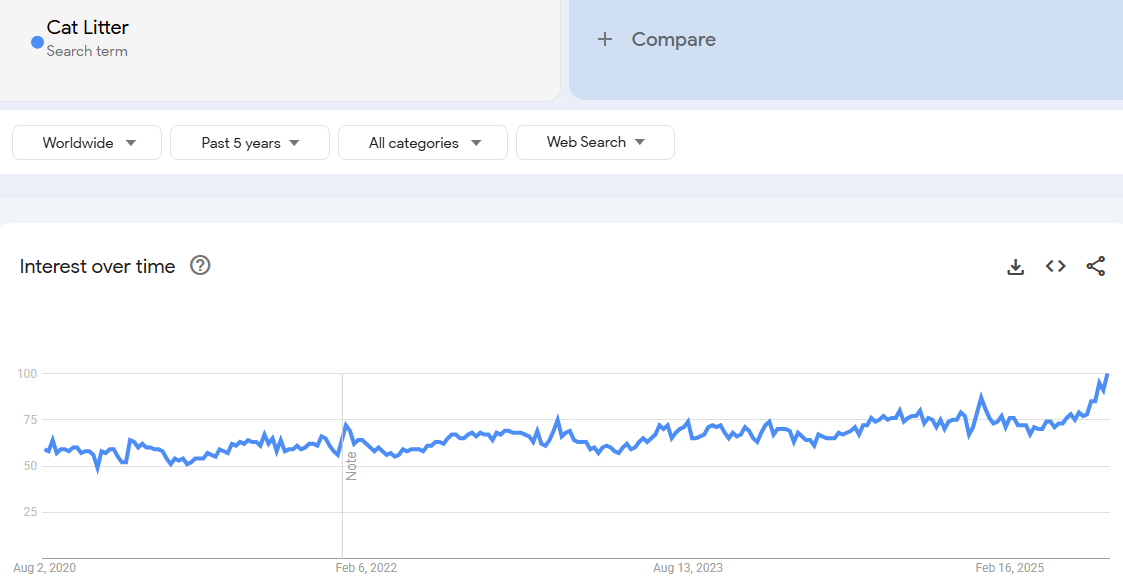
Target audience: Cat owners, particularly those in small apartments (where odor control is paramount) or with multiple cats.
Market analysis: Cat litter is an evergreen product – a true staple with year-round demand. However, premium litters that emphasize odor control and low dust have taken off, as owners look for better solutions. For example, Dr. Elsey’s Ultra Clumping Litter consistently tops Amazon’s pet supplies – praised for odor and dust control. The litter category also sees innovation: natural alternatives (corn, wood, tofu litter) attract eco-conscious owners. Self-cleaning litter boxes (the pricey gadget side of this niche) have also trended upwards among tech-friendly cat parents, though at a higher price point.
Monthly search volume: ~50,000 (“cat litter”), stable but highly competitive.
Price range: Standard clay litter ~$10–$20 per 20-lb, specialty litter $20–$30 for similar volume. Automatic litter boxes run $100–$500 – a significant spend some are willing to make for convenience.
6.GPS Pet Trackers & Smart Collars
GPS tracking devices or collars for pets that sync with apps, and smart collars that monitor activity or vitals.
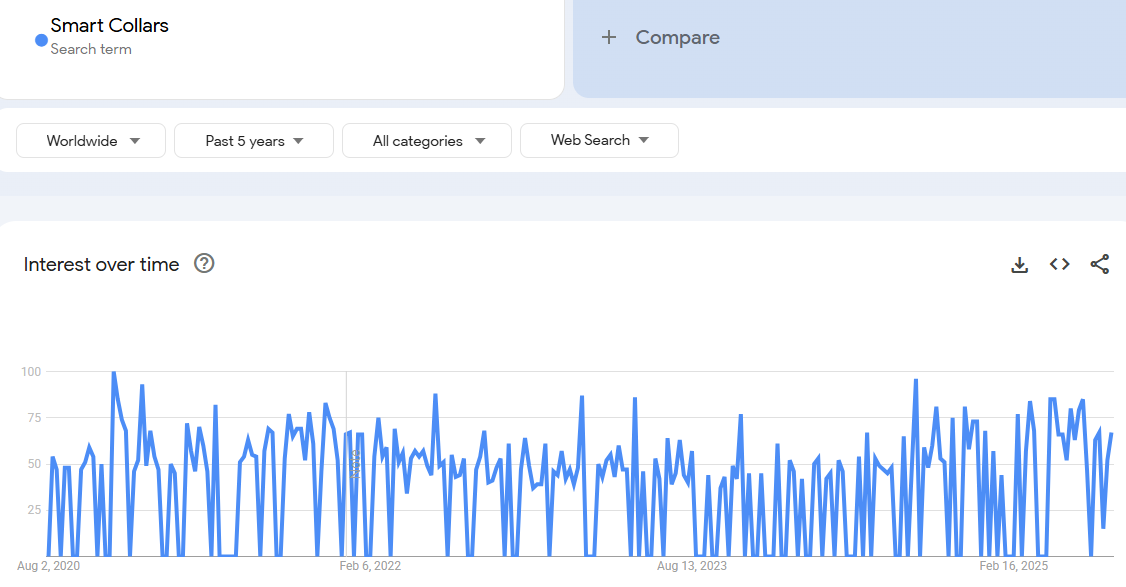
Target audience: Dog owners who allow off-leash activity, outdoor cat owners, and tech-loving pet parents in general.
Market analysis: Pet wearables are a fast-growing segment. The pet tech market (incl. trackers) is expected to grow from $7.6B in 2024 to $17.3B by 2030, reflecting how mainstream this is becoming. A tracker gives owners peace of mind against lost pets, and many also double as fitness trackers for pets (yes, pet Fitbits!). Products like Whistle or Tractive GPS have gained strong customer bases. Social media occasionally surfaces heartwarming lost-and-found stories thanks to trackers, further encouraging adoption.
Monthly search volume: ~7,000 (“pet GPS tracker”), rising year over year.
Price range: Devices ~$50–$150, often with a monthly service plan ($5–$15/mo) for GPS connectivity. Many deem it worthwhile as an insurance of sorts for their beloved pet.
7.Pet Grooming Tools

High-quality grooming brushes, de-shedding tools (like the Furminator), nail grinders, and at-home grooming kits.
Target audience: Dog and cat owners (especially of high-shed breeds or those prone to matting) who prefer DIY grooming to save costs or bond with their pet.
Market analysis: Grooming tools saw a bump when pet salons were closed in 2020 and many learned to do it themselves. Even after reopening, a lot of owners continue regular home grooming. Searches for “dog nail grinder” or “deshedding brush” remain strong. A well-known tool, the Furminator de-shed brush, for example, has sustained popularity due to viral before/after hairball photos online. Cats, being typically groomed at home, drive steady comb/brush sales; and the rise of long-haired cat breeds in popularity means more demand for tangle-removing tools.
Monthly search volume: ~12,000 (“dog grooming kit”), ~10,000 (“cat brush”).
Price range: Basic brushes ~$10–$20, specialty de-shedding tools ~$25–$40, pet clippers ~$30–$80. Given a single pro grooming session can cost $50+, many find these prices a bargain for multiple uses.
8.Eco-Friendly Pet Toys & Gear
Pet toys made from recycled materials, organic catnip toys, and sustainable pet gear (e.g. collars from recycled plastic, biodegradable poop bags).
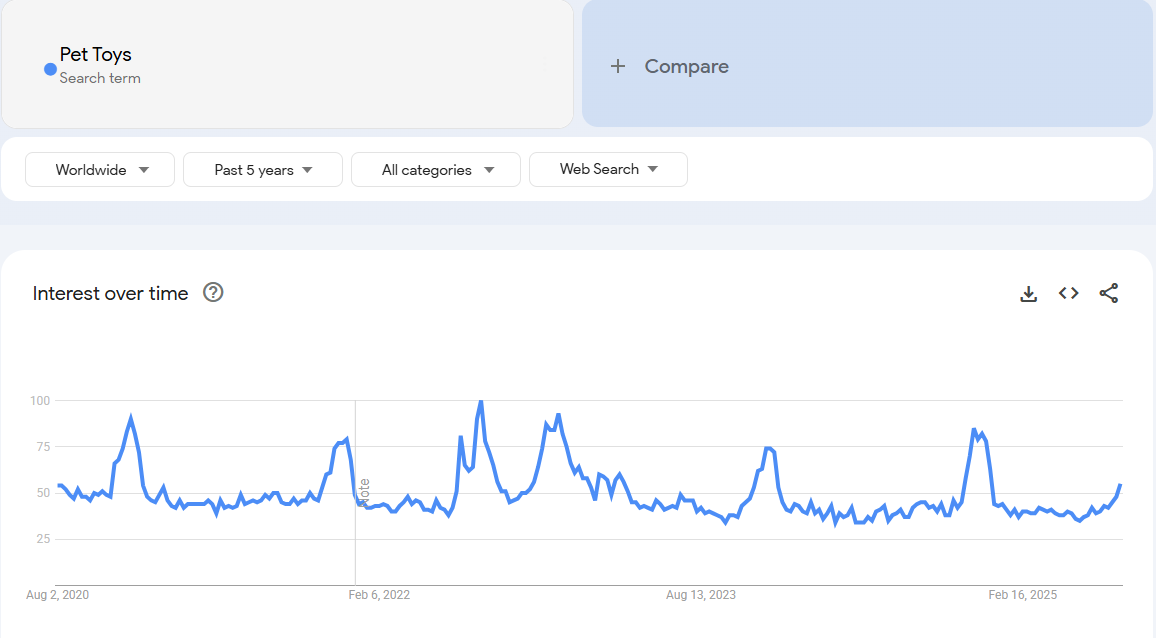
Target audience: Pet owners who are environmentally conscious – often overlapping with younger demographics or those who prioritize sustainability in their own purchases.
Market analysis: Just as sustainability is big in human products, it’s catching on in pet products. Brands now offer vegan leather collars, hemp leashes, and toys made of recycled plastic bottles or organic fibers. There’s also interest in natural chew toys (antlers, olive wood) as alternatives to plastic. Many consumers feel better choosing these for their pets, aligning with their personal values. The market for eco pet products is still emerging, but growing steadily as awareness increases. Pet stores often dedicate a section to “green” pet items now.
Monthly search volume: ~3,000 (“sustainable dog toys”) – niche but rising.
Price range: Similar to conventional products, sometimes a bit higher. E.g. recycled material dog toy $15 vs $10 regular, biodegradable poop bags ~$15 for bulk pack (competitive with normal bags). Buyers often accept a small premium for the cause.
9.Pet Furniture & Beds
Items like orthopedic memory foam dog beds, fancy cat trees, window perches, and pet teepee beds.
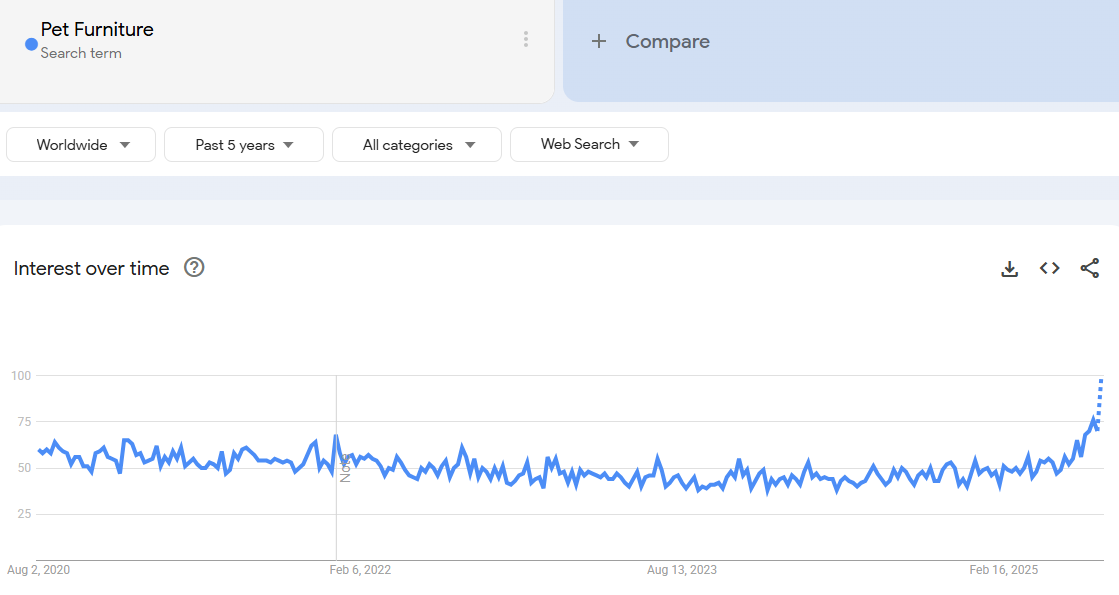
Target audience: Pet owners who want to pamper their pets with comfort or integrate pet furniture into their home decor.
Market analysis: Spending on pet comfort has surged. Orthopedic and calming dog beds (the donut-shaped ones) have gone viral for helping pets with anxiety – many sold out after TikTok reviews. Cat “furniture” like multi-level towers or stylish scratchers is a growth area, especially with more cats kept indoors. Some companies now make designer pet furniture that looks like human furniture (to blend into living rooms) and these find a market among upscale pet owners.
Monthly search volume: ~40,000 (“dog bed”), ~22,000 (“cat tree”).
Price range: Basic small pet beds ~$20, large memory foam beds $80–$150, designer models $200+. Cat trees range $50–$200 depending on size and materials. Pet owners often see these as long-term investments – they’ll pay more if it promises durability and pet health benefits.
10.Interactive Pet Toys
Tech-infused or treat-dispensing toys that keep pets engaged (e.g. automatic laser toys for cats, treat puzzle games, interactive ball launchers for dogs).
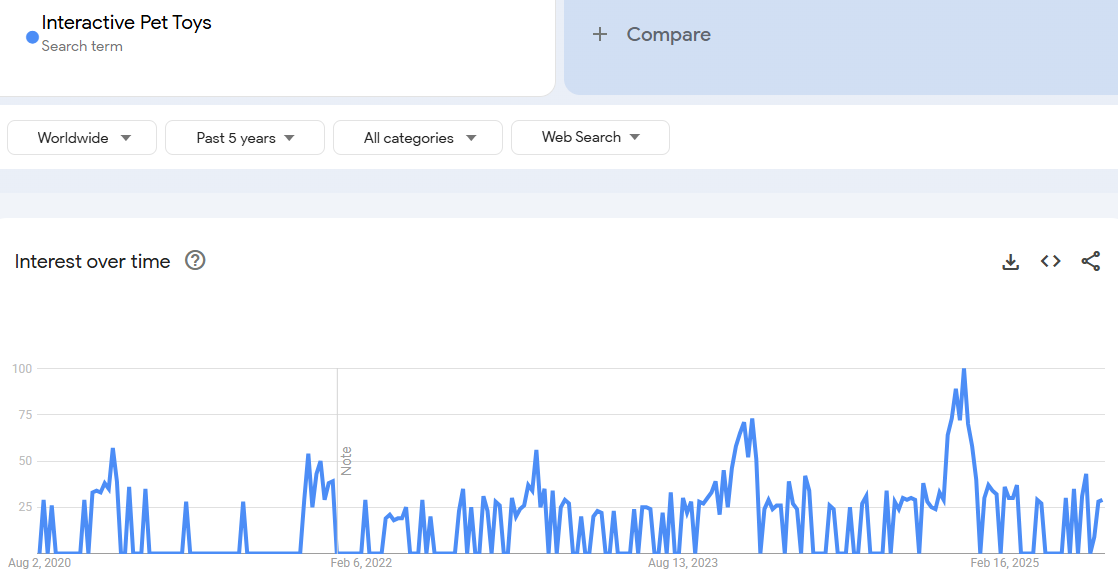
Target audience: Pet owners who leave pets home alone and want to provide stimulation, or anyone with a high-energy pet needing enrichment.
Market analysis: Boredom-busting pet gadgets are trending as understanding of pet mental health grows. Automatic laser toys and treat puzzles are particularly popular for cats (younger cat owners love posting videos of their cats chasing lasers or solving puzzles). For dogs, treat dispensers and smart balls that move erratically are hits. Many of these products saw increased sales when people returned to offices – a bit of guilt alleviation for leaving Fluffy at home. According to Google/Amazon data, searches for “dog puzzle toy” and “automatic cat toy” have trended upward each year.
Monthly search volume: ~8,000 (“dog puzzle toy”), ~5,000 (“automatic cat toy”).
Price range: Simple puzzles $10–$20, high-tech toys $30–$100 (like a ball launcher easily $100+). Pet parents with disposable income often splurge on these to keep their furkids happy.
Best Trending Skin Care Products
1.Bakuchiol Serum
Facial serums featuring bakuchiol, a plant-based retinol alternative known for anti-aging benefits without the harsh side effects.
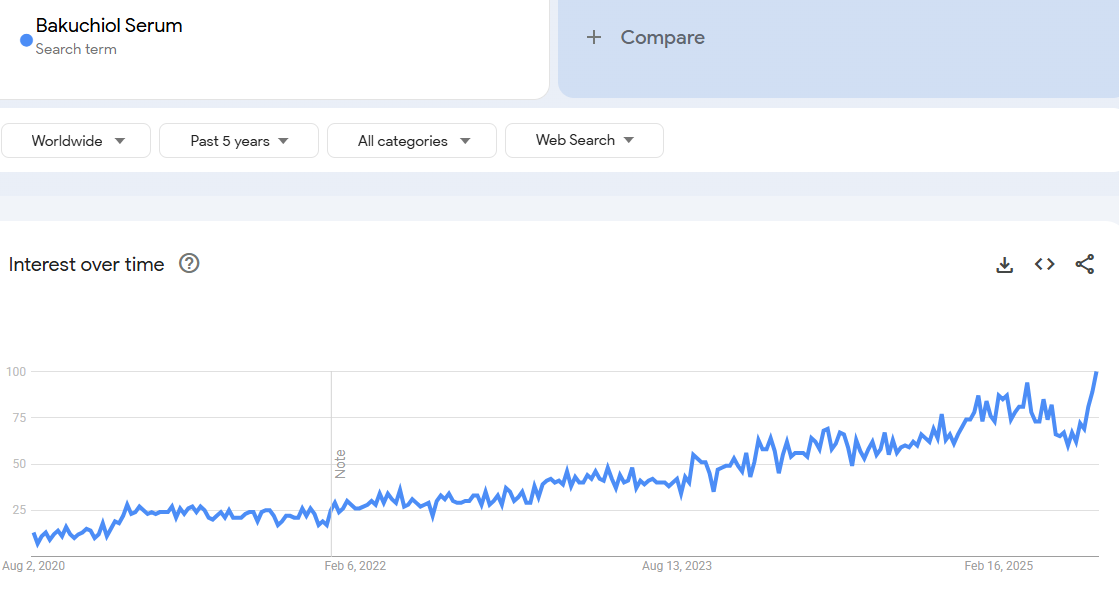
Target audience: Skincare enthusiasts, especially those with sensitive skin or seeking natural/vegan products, and women 25–45 targeting fine lines.
Market analysis: Bakuchiol has been dubbed a “game-changer” in skincare. Its buzz grew from niche blogs to mainstream as studies showed retinol-like effects. Now, bakuchiol serum is trending with ~60.5K searches per month. Multiple TikTok skincare influencers have recommended it, racking up videos with over 100K views. It rides the clean beauty wave as well. Many major skincare brands launched bakuchiol lines in the last 2 years, validating its demand.
Price range: ~$8–$40 per bottle (some drugstore brands on the low end, luxe brands pricing higher). Consumers find it relatively affordable compared to high-end retinols, another factor boosting popularity.
2.Niacinamide Products
Lotions and serums high in niacinamide (Vitamin B3), targeting skin tone, enlarged pores, and oil regulation. A notable item is niacinamide body lotion, bringing facial-grade ingredients to body care.

Target audience: Broad – from teens with oily/acne-prone skin to adults dealing with uneven skin or redness.
Market analysis: Niacinamide has become a hero ingredient in the past few years (The Ordinary’s niacinamide serum famously sold in huge volumes). Now it’s moving into body care – for example, Paula’s Choice and other brands launched niacinamide body treatments to address body acne and discoloration. This indicates consumers want active ingredients head-to-toe. Search interest for niacinamide remains high and stable. Many skincare routines in 2025 include a niacinamide step, and it’s often recommended in skincare communities for its versatility and gentleness.
Monthly search volume: ~90,000 (“niacinamide serum”).
Price range: Budget serums ~$6–$15 (The Ordinary, etc.), higher-end $20–$30. Body formulations ~$25. Given the effectiveness, even pricier options are considered worth it by skincare aficionados.
3.Barrier Repair Creams
Moisturizers designed to restore the skin barrier, often labeled as “ceramide cream” or simply barrier cream.
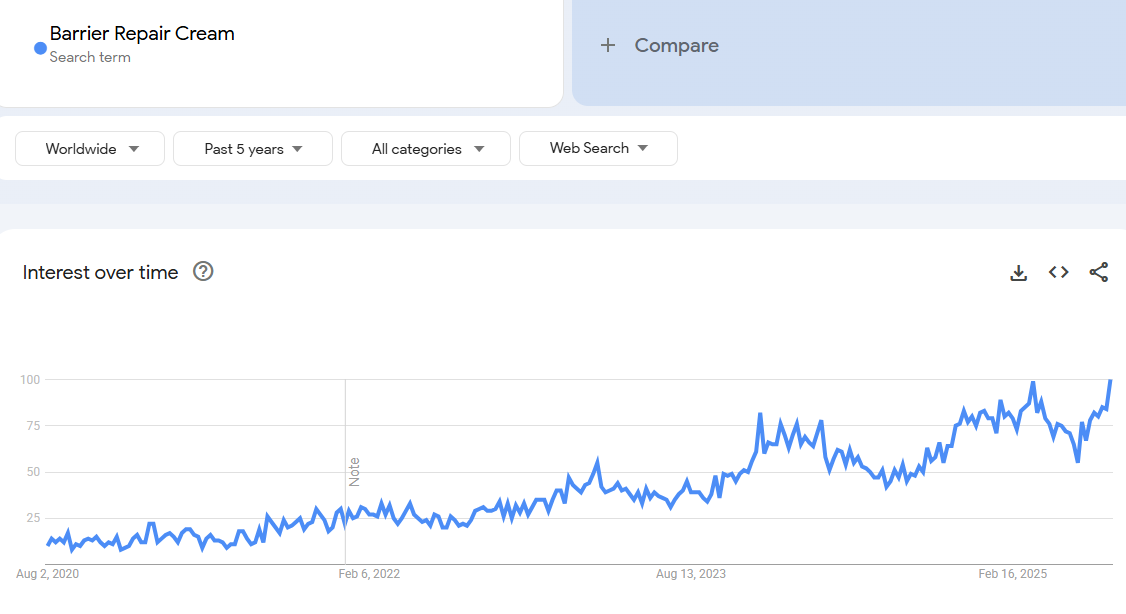
Target audience: People with damaged or sensitive skin (from over-exfoliation, retinol use, cold weather, etc.), and anyone focusing on skin health over just aesthetics.
Market analysis: The concept of protecting the skin’s moisture barrier went mainstream recently. Barrier creams have about 40.5K monthly searches, and growing interest thanks to dermatologist influencers who emphasize skin barrier in their advice. Many consumers have swung from aggressive skincare to a gentler “barrier-first” approach, fueling sales of products like CeraVe (rich in ceramides). TikTok has countless videos on “How I healed my skin barrier” featuring these creams.
Monthly search volume: ~40,000 (“ceramide cream” or “barrier repair cream”).
Price range: ~$15–$35, largely in line with mid-range moisturizers. Users see them as essential, especially in winter months or post-chemical peels.
4.Kojic Acid & Brightening Serums
Serums with ingredients like kojic acid, tranexamic acid, vitamin C, etc., aimed at fading dark spots and evening skin tone.

Target audience: Those with hyperpigmentation, melasma, or post-acne marks – very common across various age and ethnic groups.
Market analysis: Brightening products are perennially popular, but kojic acid is a standout newcomer in western markets (long used in Asian skincare). Interest climbed as consumers seek hydroquinone alternatives. Kojic acid serum got lots of TikTok attention for being a natural skin brightener – videos related to it garnered over 5 million views. Google searches and product launches for kojic and tranexamic acid treatments have trended up. The global demand for “glowing skin” keeps vitamin C serums in high rotation too.
Monthly search volume: ~12,000 (“kojic acid serum”), ~100,000+ (“vitamin C serum” remains huge).
Price range: Kojic/tranexamic serums ~$15–$30, vitamin C serums range $20–$80 depending on brand potency. Multi-ingredient brightening serums in the $30–$60 range are often seen as worth the investment to consumers battling stubborn dark spots.
5.Under-Eye Patches
Gel or sheet under-eye masks infused with ingredients like hyaluronic acid, caffeine, collagen or gold, used for quick fixes to puffiness and dark circles.
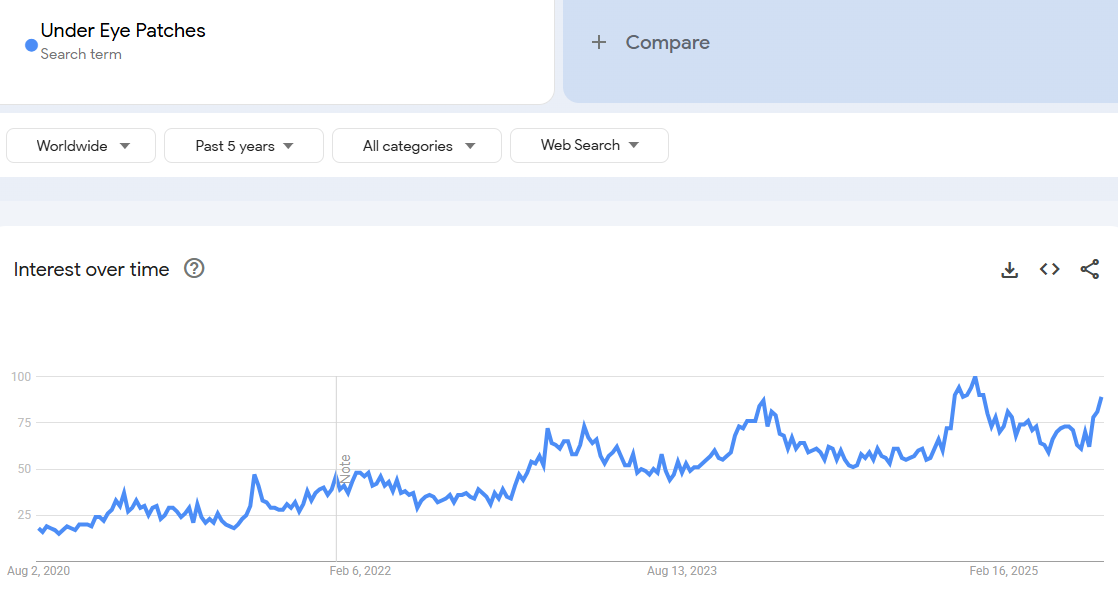
Target audience: Busy professionals, new parents, skincare junkies, and anyone looking for a quick under-eye refresh (often women 25–45).
Market analysis: These have exploded as a self-care and glam routine staple. Under-eye patches see ~60.5K searches per month, and brands from luxury to K-beauty have jumped in. Social media plays a big role – from influencers wearing them on camera while doing eye makeup (showing they’re part of the process) to countless “morning routine” posts featuring them. They’re perceived as an affordable mini-spa treat. TikTok videos showcasing before/after de-puffing effects have racked up over 55 million views.
Price range: Wide – drugstore brands ~$10 for a pack of 5 pairs, high-end $30–$50 for similar count (and even $5 per pair for luxury “24k gold” versions). They sell well at all price points because they’re often bought as gifts or little indulgences.
6.African Net Sponge (Exfoliator)
Long, net-like bath sponges originating from West Africa (also called Sapo or African exfoliating nets) used for full-body exfoliation.

Target audience: Skincare enthusiasts looking for effective body exfoliation, people with textured skin or hyperpigmentation on the body (like strawberry skin), and generally those adopting global beauty tools.
Market analysis: This traditional product went viral on social media for its superior exfoliating ability and quick-drying hygiene. The result: African net sponges now have about 246K monthly searches – enormous interest and a 7,600% search growth over 5 years. Consumers laud that it’s more effective and longer-lasting than loofahs. It also ties into the trend of “world beauty secrets” becoming mainstream (similar to how K-beauty and gua sha tools did).
Price range: ~$5–$10. It’s a low-cost item but often purchased in multiples or with other bath products. Many first-time buyers are coming through viral recommendations.
7.Microneedle Patches
Tiny patch devices with dissolvable micro-needles (often used for acne, wrinkles, or transdermal delivery of actives).
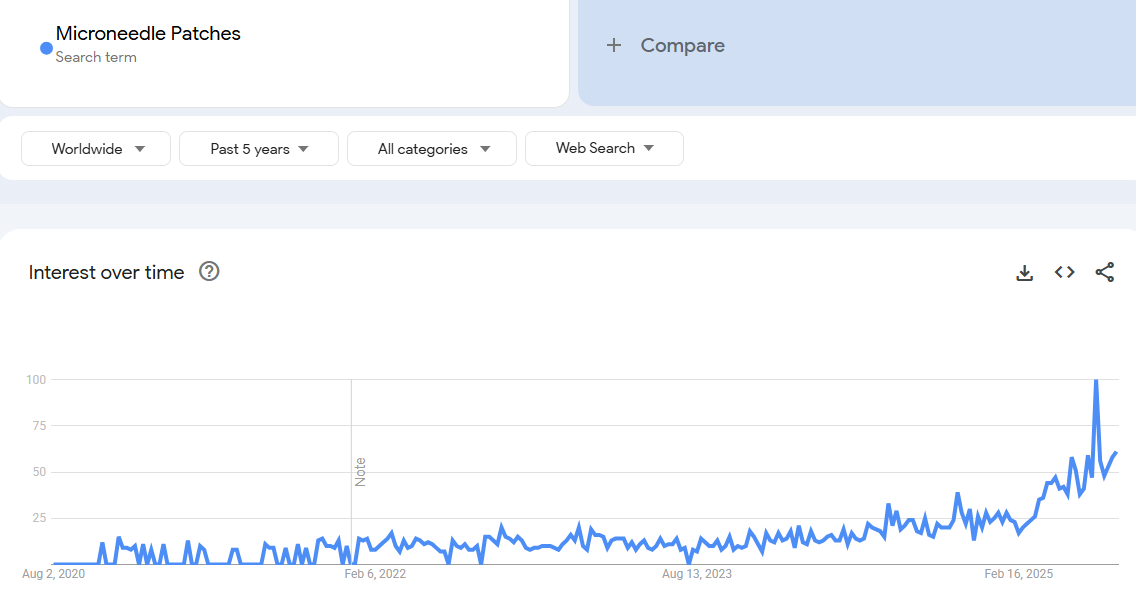
Target audience: Tech-forward skincare users, acne sufferers (for pimple patches with microdarts), and those exploring advanced at-home treatments for fine lines or localized issues.
Market analysis: Evolving from basic hydrocolloid pimple patches, microneedling patches promise deeper ingredient delivery without pain. They cater to people who want pro-grade results at home. There’s been an 809% rise in interest over 5 years, as indicated by search trends. They’re particularly popular for stubborn pimples or under-eye lines. While a relatively niche product, they piggyback on the microneedling trend (dermarollers, etc.) which is well-established. Clinical skincare brands and K-beauty brands alike have launched versions, validating the concept.
Monthly search volume: ~9,900 (“microneedle patches”), plus related high interest in “pimple patches” generally.
Price range: ~$15–$40 per box (often containing 4–8 patches). Consumers view them as targeted treatments worth the cost for specific concerns.
8.Plum and Fruit Enzyme Face Washes
Gentle cleansers featuring fruit extracts or enzymes (papaya, plum, etc.) that cleanse and mildly exfoliate without stripping.
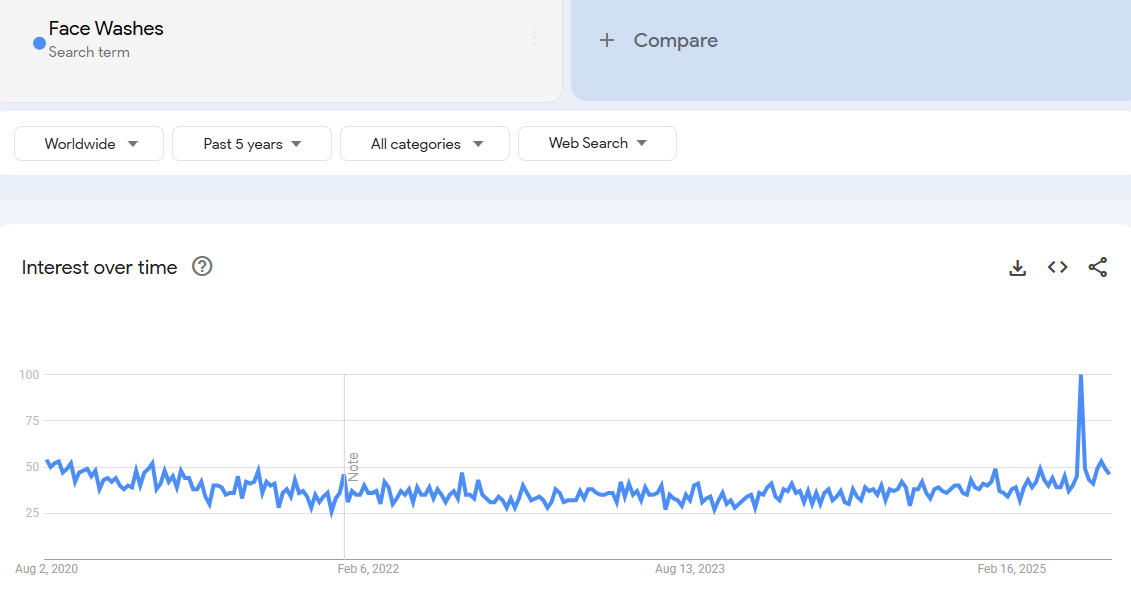
Target audience: Teens and adults with dull skin or mild acne, fans of K-beauty/J-beauty inspired routines, and those who want natural ingredient-based cleansers.
Market analysis: Fruity face washes are trending thanks to the sensorial aspect and natural positioning. A specific example: “Plum face wash” got attention with 2+ billion TikTok views on videos mentioning it, partly due to a brand named Plum popular in India and globally. Enzyme cleansers (like papaya enzyme) appeal because they promise brightening without harsh scrubs or acids. As consumers double-cleanse more (a concept from Korean routines), there’s room for fun second-step cleansers like these.
Monthly search volume: ~40,500 for “Plum face wash” (brand-specific), indicating significant interest.
Price range: ~$10–$20. Generally affordable, which encourages trial among younger demographics.
9.Lash & Brow Enhancers
This includes lash shampoos for extension wearers, lash growth serums, and brow growth oils.
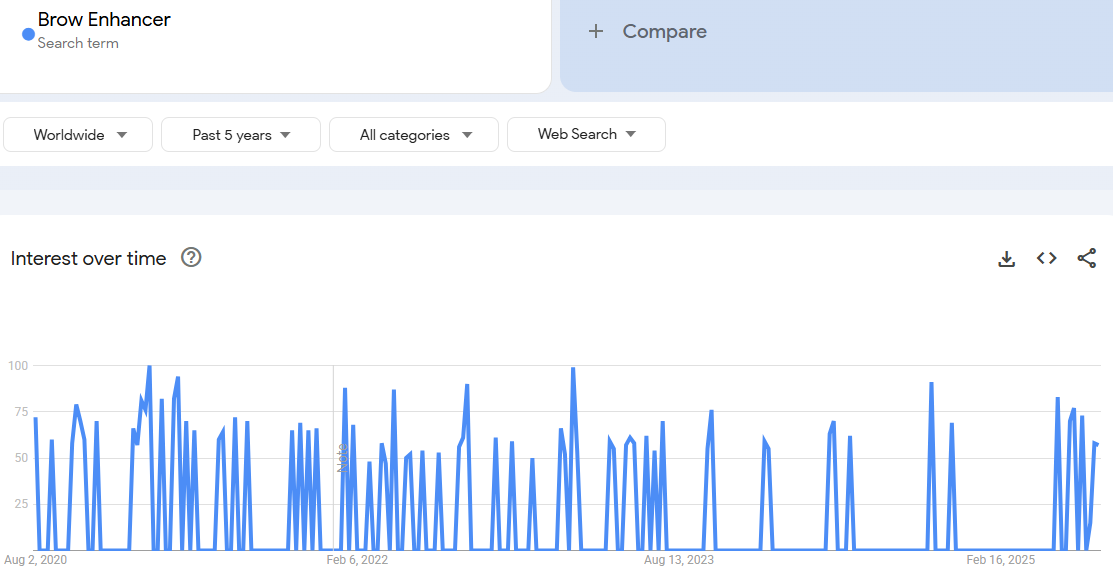
Target audience: Those with eyelash extensions (for lash shampoo), anyone trying to grow fuller natural lashes or brows – a big beauty goal particularly for women 20–45.
Market analysis: With the bold brow and long lash trends still strong, products catering to lash/brow health are in demand. Lash shampoos, once a niche product for extension salons, have gained popularity among the average consumer (with ~14.8K searches a month). They’re boosted by lash extension aftercare routines on YouTube/TikTok. Meanwhile, lash serums like GrandeLASH have become best-sellers in beauty retail, and castor oil for brows is a classic DIY that spawned many new products. Social media is rife with before/after proof, driving trust and sales.
Monthly search volume: ~15,000 (“lash serum”), lash shampoo ~15k.
Price range: Lash shampoo ~$10–$20, lash growth serums $30–$100 (the high end doesn’t deter many since results are coveted). Brow serums similarly priced, though some opt for cheaper natural oils at <$15.
10.Tallow-Based Moisturizers
Balms or creams made with beef tallow (often grass-fed), touted for its skin-nourishing fatty acids and similarity to natural skin oils.
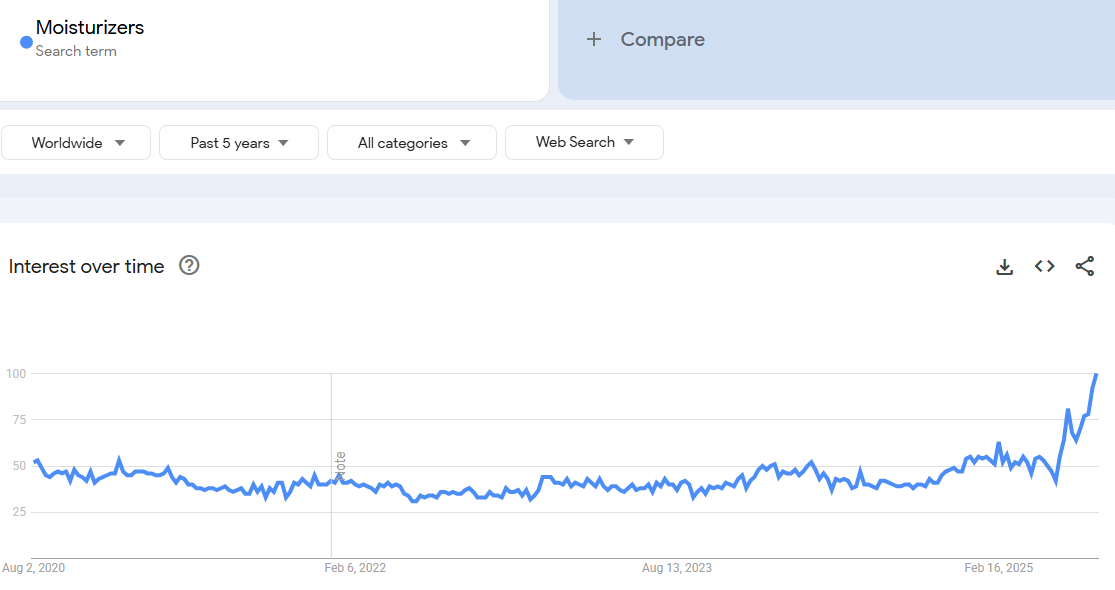
Target audience: Fans of ancestral or “farm-to-skin” skincare, those with very dry or eczema-prone skin looking for heavy-duty natural moisturizers.
Market analysis: An unconventional trend, but “beef tallow moisturizer” Google searches jumped 400% in some regions (e.g. New Zealand, North America). The trend piggybacks on the broader movement of returning to traditional ingredients (bone broth for diet, tallow for skin). It’s somewhat niche and controversial (vegans avoid, but paleo lifestyle folks embrace), yet its rapid rise shows curiosity and demand. Some users rave that it reduces inflammation and blemishes. Small artisanal brands have emerged selling tallow balms, and they often sell out due to word-of-mouth.
Monthly search volume: A few thousand and rising (“tallow balm” etc.).
Price range: ~$15–$30 for a small jar. Often more expensive than regular lotion due to small-batch production and sourcing of high-quality tallow, but consumers interested in this trend are willing to pay for purity.
Best Trending Outdoor & Adventure Gear Products
1.Padel Rackets & Gear
Equipment for Padel, the racket sport hybrid of tennis and squash that’s exploding in popularity globally.
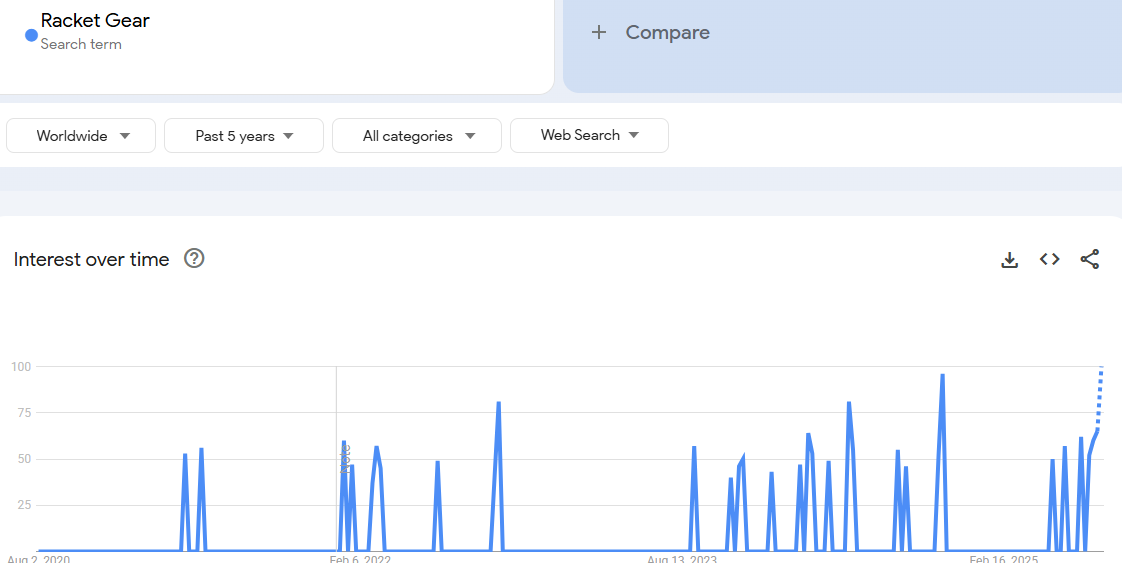
Target audience: Sports enthusiasts and tennis players (mostly in Europe, Latin America, Middle East, now catching on in U.S.) switching to or trying padel.
Market analysis: Padel is one of the world’s fastest-growing sports – with over 18 million players worldwide. Searches for “padel racket” average 201K per month(!), illustrating massive interest. Countries like Spain, Sweden, and UAE have padel booms, and investors are pouring in. For sellers, this means strong demand for rackets, padel balls (which saw 165K/mo searches), racket bags, and accessories. Social media (including many TikToks around padel tips and highlights) has helped spread it. Early adopters in North America present a growth opportunity as well.
Price range: Padel rackets ~$60–$300 (entry-level vs. pro models from brands like HEAD, Dunlop). Balls ~$5–$10 for a can. Many enthusiasts invest in high-quality gear as they get serious.
2.Pickleball Equipment
Pickleball paddles (especially advanced carbon fiber ones), balls, and nets for the ultra-popular sport.
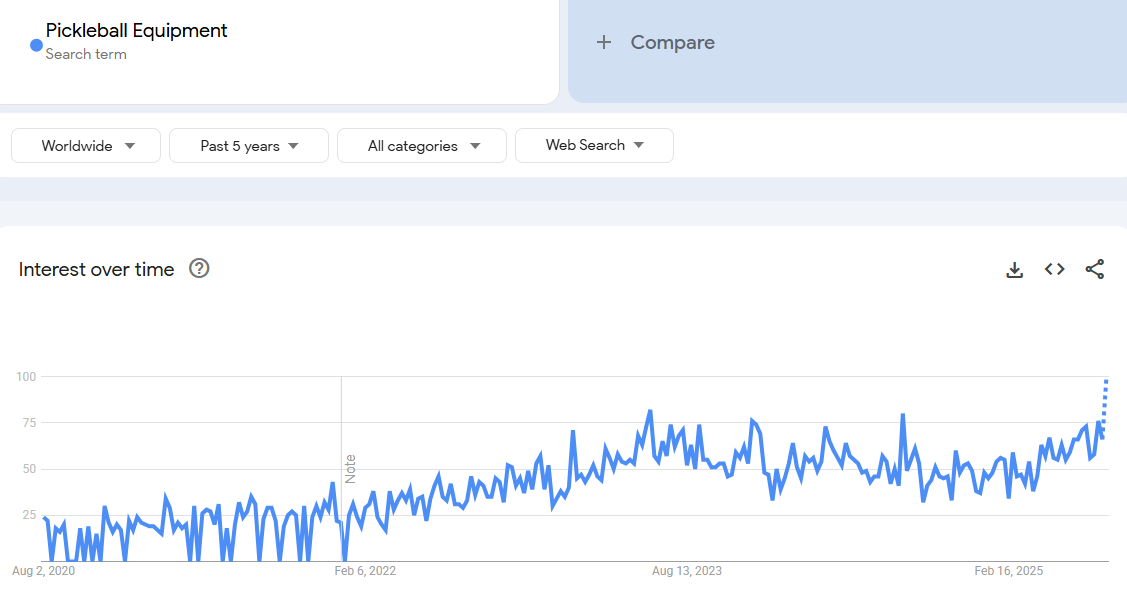
Target audience: A broad range – from retirees to young adults – since pickleball has caught on across age groups as a fun, social, and accessible sport.
Market analysis: In the U.S., pickleball is surging (participation doubled in recent years). There is a thriving market for better paddles as casual players turn competitive. For example, carbon fiber pickleball paddles are hot: one trending carbon paddle saw “99x+” growth and ~5.4K searches/mo. Manufacturers can’t keep up with demand at times. Tournaments are televised now, boosting visibility. Even celebrities are investing in pickleball clubs. This sustained trend means balls and other gear also sell steadily (often in bundles).
Monthly search volume: ~60,000 (“pickleball paddle”).
Price range: Starter paddle sets ~$30–$50, advanced composite paddles $80–$150, tournament-level paddles $150–$250. Serious players upgrade their gear frequently, which means repeat sales potential.
3.E-Bikes & Electric Scooters
Electric bicycles and scooters for urban commuting and recreation.
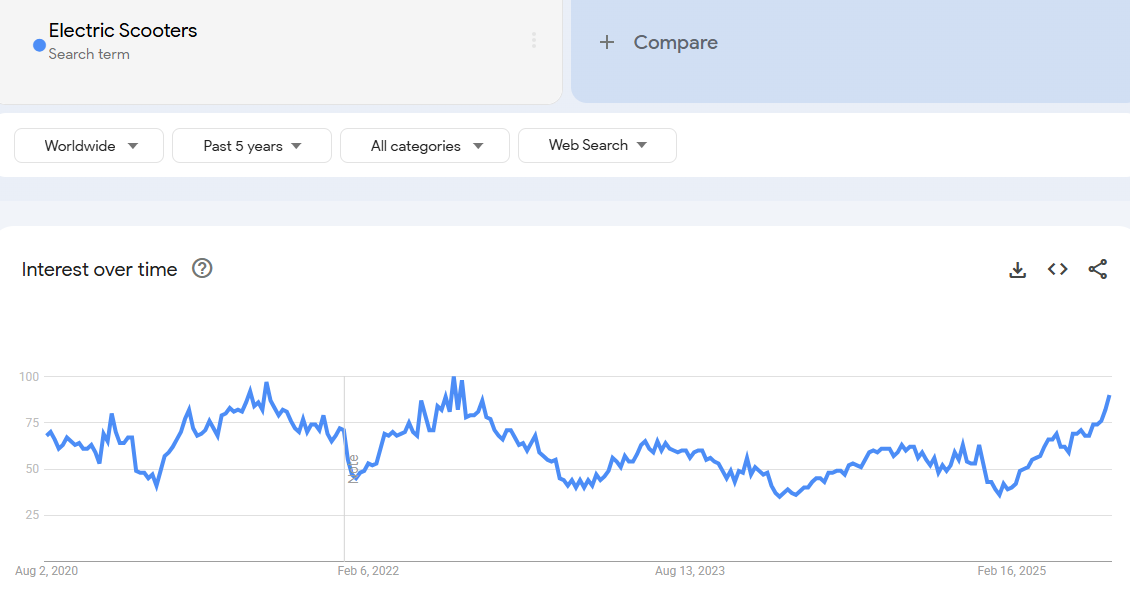
Target audience: City commuters, eco-conscious travelers, delivery workers, and outdoor adventurers wanting a boost.
Market analysis: Micro-mobility is transforming transport. E-bike sales in the U.S. rose 240% from 2019 to 2021 and are expected to hit 6.4 million units annually by 2025. Globally, the e-bike market could exceed $90B in 2025. People turn to e-bikes/scooters to save on gas, avoid traffic, or tackle hills easily. Various countries offer incentives for e-bike purchases, further fueling growth. Additionally, many see e-bikes as a fun leisure activity (mountain e-biking, etc.). Electric scooters (think Xiaomi, Ninebot) are similarly popular in cities and campuses.
Monthly search volume: ~90,000 (“electric bike”), ~50,000 (“electric scooter”).
Price range: E-scooters ~$300–$800 for quality models; E-bikes ~$600–$2,000+, depending on features and brand. Although high-ticket, consumers view them as investments replacing car miles or enhancing mobility, which supports the robust growth.
4.Portable Power Stations (LiFePO4 Batteries)
Rechargeable lithium iron phosphate battery packs / generators for camping, RV, and emergency backup, often solar-compatible.
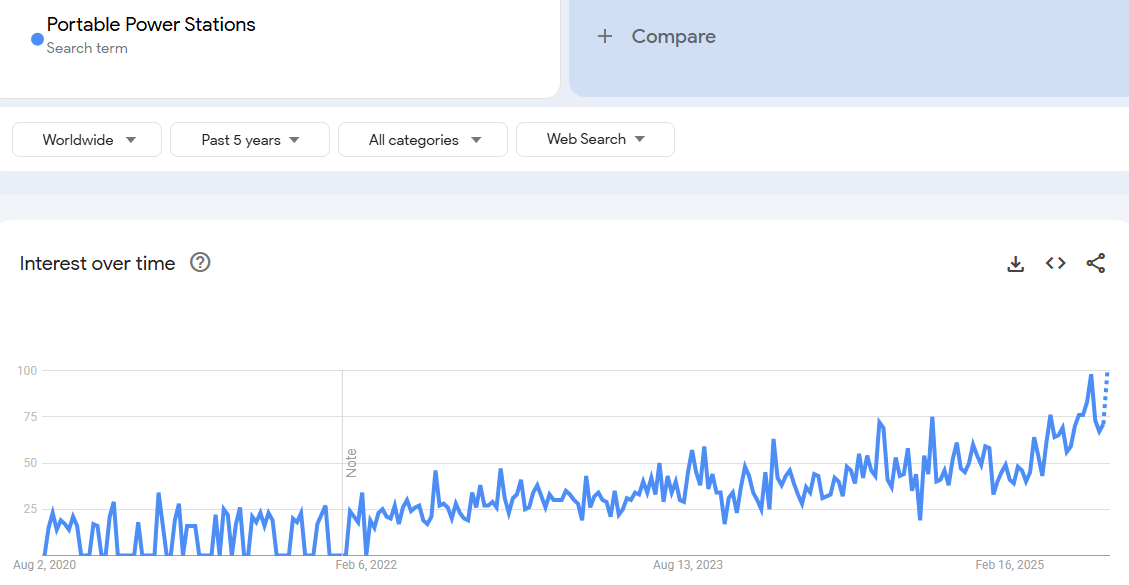
Target audience: Campers, van-lifers, off-grid enthusiasts, and homeowners preparing for outages (especially in disaster-prone areas).
Market analysis: As outdoor recreation and remote work from anywhere trend up, so does the need for reliable power off-grid. LiFePO4 (lithium iron phosphate) batteries are safer and longer-lasting than traditional lithium-ion, making them the new favorite in power stations. This segment has strong growth; forecasts suggest LiFePO4 batteries could claim 47% of the battery market by 2026 (partly due to EVs and storage solutions). Brands like Jackery or EcoFlow have seen booming sales of their solar generators. Furthermore, frequent extreme weather events have more people seeking backup power at home.
Monthly search volume: ~20,000 (“portable power station”), and rising.
Price range: Smaller power banks $200–$400, larger solar generator kits $800–$2,000. Consumers in this niche are willing to pay for quality and capacity – it’s often a considered purchase for safety or crucial convenience.
5.Inflatable Paddle Boards (SUPs)
Stand-up paddle boards that are inflatable, making them portable and easy to store, complete with pump and backpack.
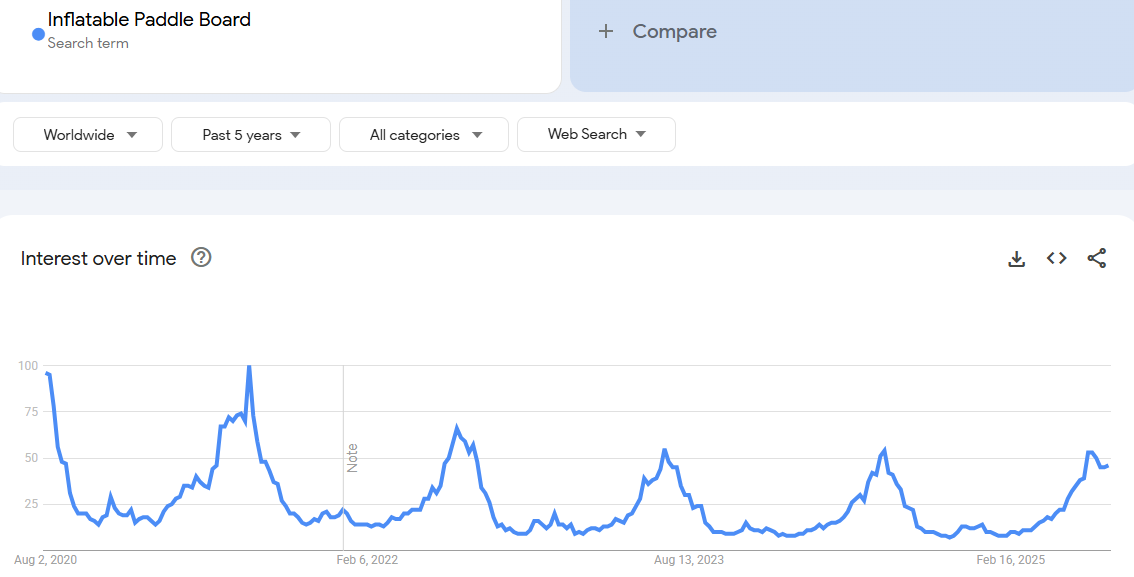
Target audience: Outdoor water enthusiasts, beach vacationers, surfers cross-training, and families (SUP is popular among all ages).
Market analysis: SUP has grown from a niche to a mainstream summer activity. Inflatable SUPs in particular opened the market to people without storage or roof racks. U.S. sales have climbed significantly since 2018. Many find SUP a fun fitness activity (core workout) and a serene nature experience. Social media shows influencers doing yoga on paddle boards, fishing, even bringing dogs along – inspiring more purchases. Multiple brands compete, driving innovation (lighter materials, quicker pumps). During the pandemic, SUP was one of the outdoor sports that boomed as people sought socially-distanced fun, and that momentum continues.
Monthly search volume: ~30,000 (“inflatable paddle board”).
Price range: ~$200–$500 for a full set (board, pump, paddle). Some high-end models $600+. Sales often peak in spring/early summer – smart sellers bundle accessories (dry bags, electric pumps) to increase value.
6.Cold-Weather Outdoor Gear (Winter Sportswear)
Thermal cycling outfits, heated gloves, winter running gear, and all-weather jackets for people staying active in winter.

Target audience: Cyclists, runners, hikers, and outdoor workers who don’t slow down for winter, as well as commuters in cold climates.
Market analysis: More people are embracing year-round outdoor activity for fitness and commuting, which drives demand for better winter gear. For example, a Winter Cycling Set (thermal jacket + pants) is highlighted as a trending product because it addresses cold-weather challenges for cyclists. Reflective, insulated, yet breathable gear appeals to serious enthusiasts. Meanwhile, gadgets like heated socks or gloves are trending thanks to improved battery tech. Outdoor retailers note that categories like winter running apparel have higher sales than prior years, possibly because the pandemic got folks used to exercising outdoors in all seasons.
Monthly search volume: ~8,000 (“thermal cycling jacket”), spikes in fall.
Price range: High – Quality winter sports jackets $100–$250, thermal tights ~$80–$150, heated gloves ~$100+. Customers in this segment prioritize performance and are often willing to invest for comfort/safety.
7.Ultralight Camping & Hiking Gear
Equipment focused on minimal weight: e.g. ultralight one-person tents, titanium cookware, compact sleeping pads.
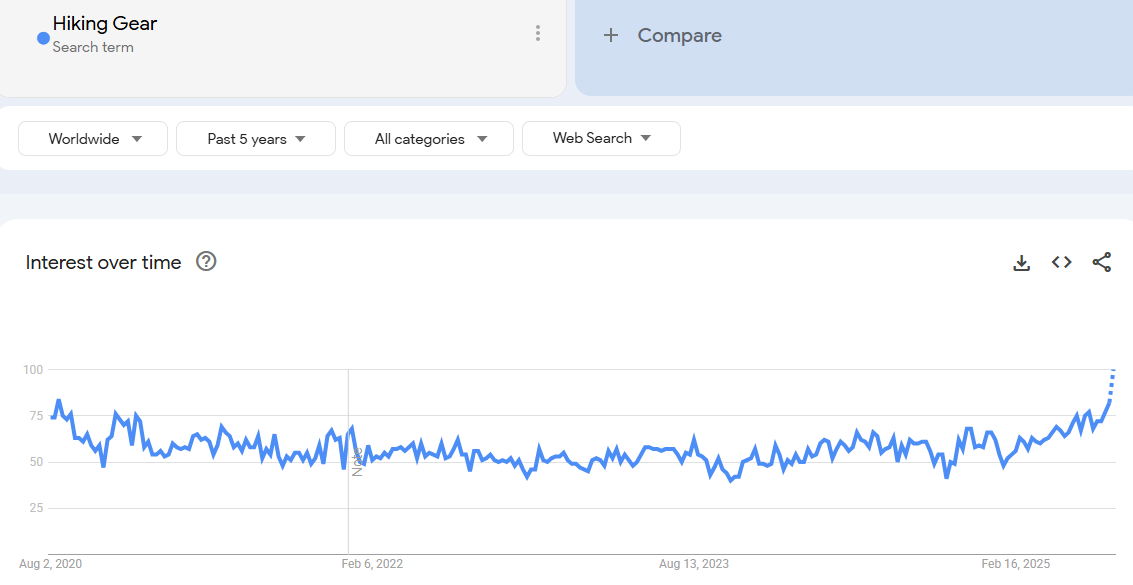
Target audience: Backpackers, thru-hikers (think Pacific Crest or Camino hikers), and minimalist campers who count every gram.
Market analysis: The ultralight movement in hiking has grown significantly, with forums and communities dedicated to shaving weight. Solo tents and compact gear are top sellers as more people attempt solo adventures. A featured example is an Ultralight Solo Backpacking Tent, highlighted for tapping into multiple niches – solo travel, ultralight trekking, etc.. As remote work allows longer travel, some take extended treks and are investing in gear that won’t break their back. Plus, survival shows and YouTube vloggers often showcase these products.
Monthly search volume: ~5,000 (“ultralight tent”) and numerous specific queries.
Price range: Ultralight often equals higher cost due to advanced materials – one-person tent $250–$400, titanium pot $50, ultralight pack $200+. Devotees of this niche justify the cost for the weight savings and durability; they’re very gear-conscious shoppers.
8.High-Capacity Hiking Backpacks (65L+)
Large yet lightweight backpacks (~60–80 liter) for multi-day hiking and backpacking trips.
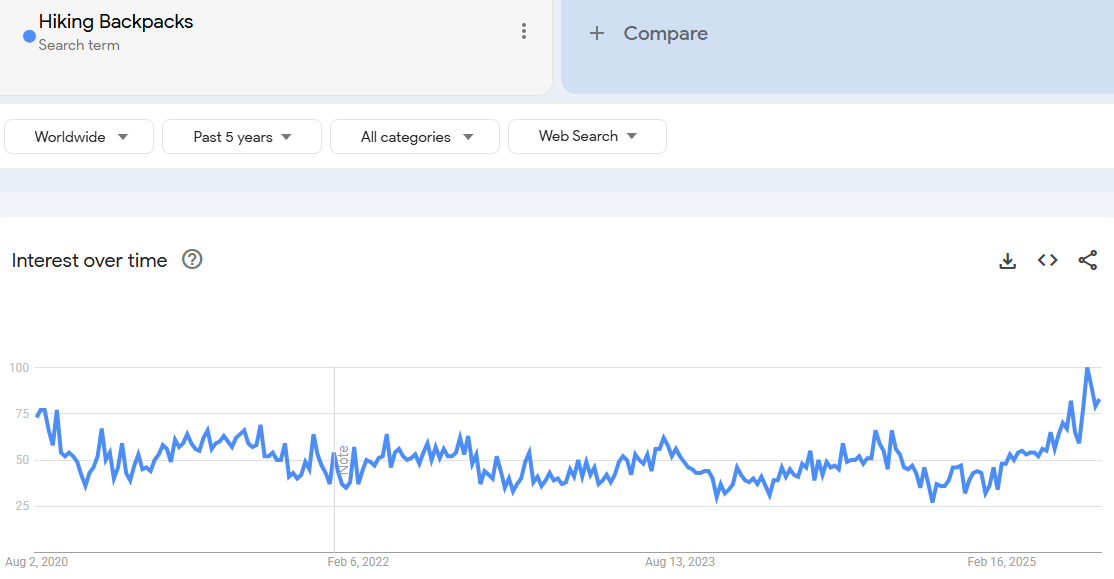
Target audience: Serious hikers, backpack travelers (gap year folks, etc.), and outdoor expedition goers.
Market analysis: Despite trends to minimize, the classic big backpack is still very much in demand for those doing long treks or traveling through multiple countries. A 70L hiking backpack was noted as a trending product due to seasonal surges and broad appeal to both hardcore and casual campers. The market is competitive (many brands, lots of innovations like ergonomic frames, ultralight fabrics). Seasonal patterns: sales rise in spring (ahead of summer hikes) and late summer (for back-to-school/outdoor college programs). Many new backpackers, inspired by post-COVID wanderlust, are gearing up for extended outdoor trips.
Monthly search volume: ~12,000 (“70L backpack”), with peaks in early summer.
Price range: $80–$200 for reputable brands. Feature-rich or ultralight models on higher side. Customers often research heavily (comparing weight, comfort) and value durability for these packs.
9.Action Cameras & Drones for Adventure
Rugged 4K action cameras (GoPro alternatives) and compact drones designed for hikers and travelers.
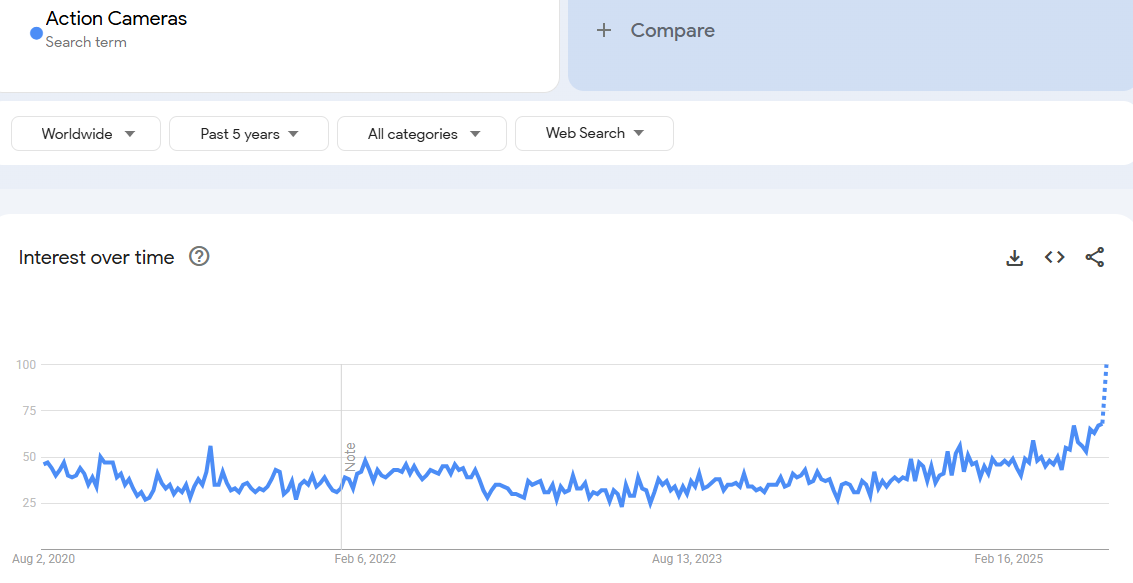
Target audience: Travel vloggers, extreme sports enthusiasts, and hobbyist photographers who document their adventures.
Market analysis: Capturing outdoor experiences is practically part of the adventure now. Even amateurs want footage of their summit or mountain bike ride. GoPro remains popular, but a host of Chinese brands (DJI’s Action cam, Insta360, etc.) offer strong alternatives – increasing adoption. Drones like the DJI Mini series specifically target hikers (lightweight, under regulations) to carry on trails. As image stabilization and quality improve, even bumpy trail runs can yield smooth video, which is impressive to share online. Social sharing of outdoor feats in high definition is a motivator for purchasing these gadgets.
Monthly search volume: ~100,000 (“GoPro”) consistently, drone queries vary by model (~30k for “DJI Mini 3” etc.).
Price range: Action cams ~$250–$400 (top models), older or budget ones $100–$200. Travel-friendly drones ~$400–$1000. High cost, but the target audience sees it as essential gear for memory-making and content creation.
10.Portable Water Filtration
Gear like water filter straws (LifeStraw), pump filters, and gravity-fed camp filters to get safe drinking water outdoors.
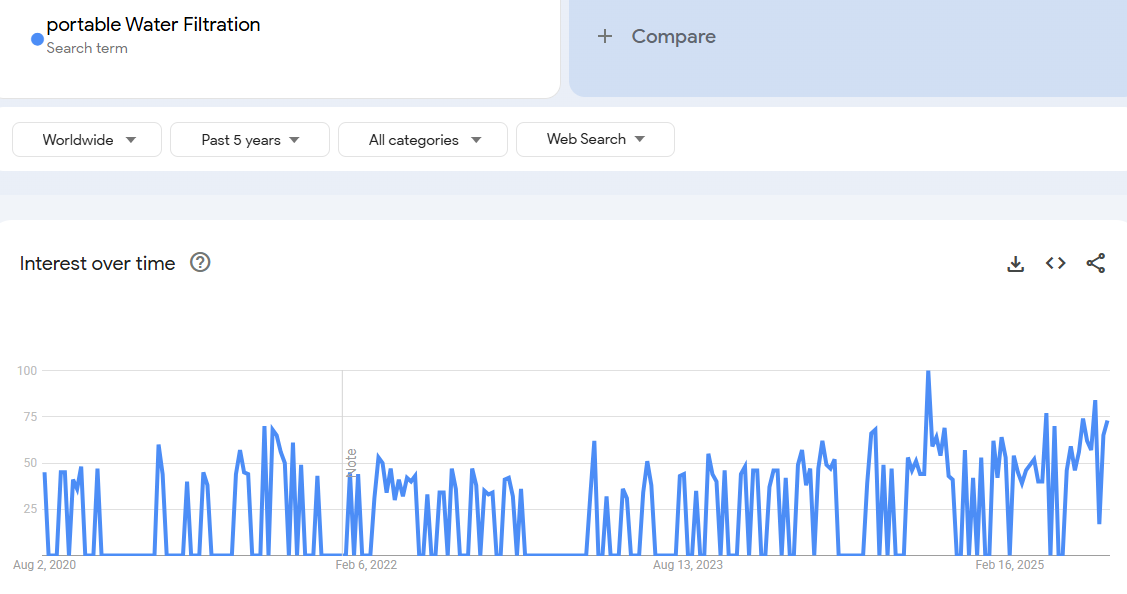
Target audience: Hikers, campers, international travelers, preppers, and emergency kit builders.
Market analysis: The LifeStraw personal filter essentially created a viral product category a decade ago, and demand remains strong as outdoor participation grows. Additionally, more people are adding such filters to emergency preparedness kits after seeing crises (boil water advisories, etc.). Searches for “water filter straw” are consistently high each summer. Campers on multi-day treks consider filters essential to lighten water carry load. Backpacking bloggers and survival YouTubers often review and recommend these, influencing newbies to purchase.
Monthly search volume: ~20,000 (“LifeStraw”) – the brand name itself is widely recognized.
Price range: Straw filters ~$15–$25, pump filters ~$60–$100, gravity bags ~$80–$150. They’re reasonably priced given their life-saving utility, so many outdoor folks buy at least a basic one.
Best Trending Toys and Baby Products
1.LCD Writing Tablets
Portable e-writer tablets for kids (and adults) that allow drawing or writing with a stylus and erase with a button (essentially paperless doodle pads).
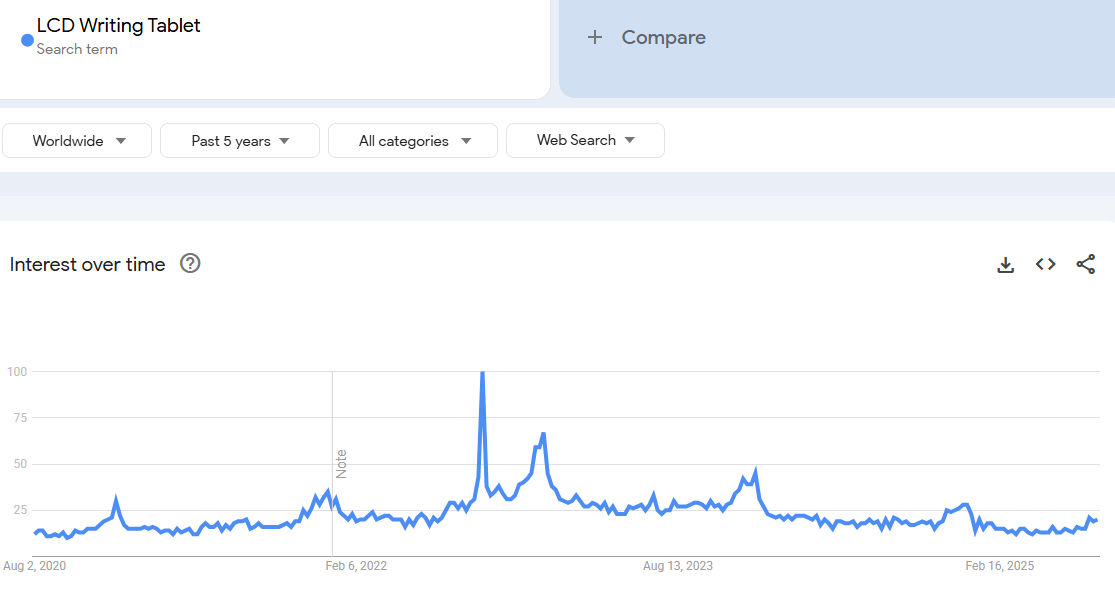
Target audience: Parents of young kids, educators, and even adults for note-taking; but primarily marketed as a kids’ tech toy (typically 3–10 years old).
Market analysis: These tablets check a lot of boxes: fun, educational, mess-free, and eco-friendly (no paper or crayons needed). One top example, the TEKFUN LCD writing tablet, is highlighted as a great choice in Toys & Games – parents love it for travel and quiet play, noting it’s “mess-free” and sparks creativity. During the pandemic home-school phase, sales spiked, and they’ve remained popular as alternatives to screen time. They often land on “best gifts” lists for kids.
Monthly search volume: ~15,000 (“LCD writing tablet”).
Price range: ~$15–$30. Very affordable, which makes them popular gifts (parents and relatives often purchase multiple for siblings).
2.Smart Baby Monitors & Tech
High-tech baby monitors (some with breathing/heart rate tracking), smart bassinets (like the SNOO), and nursery gadgets.
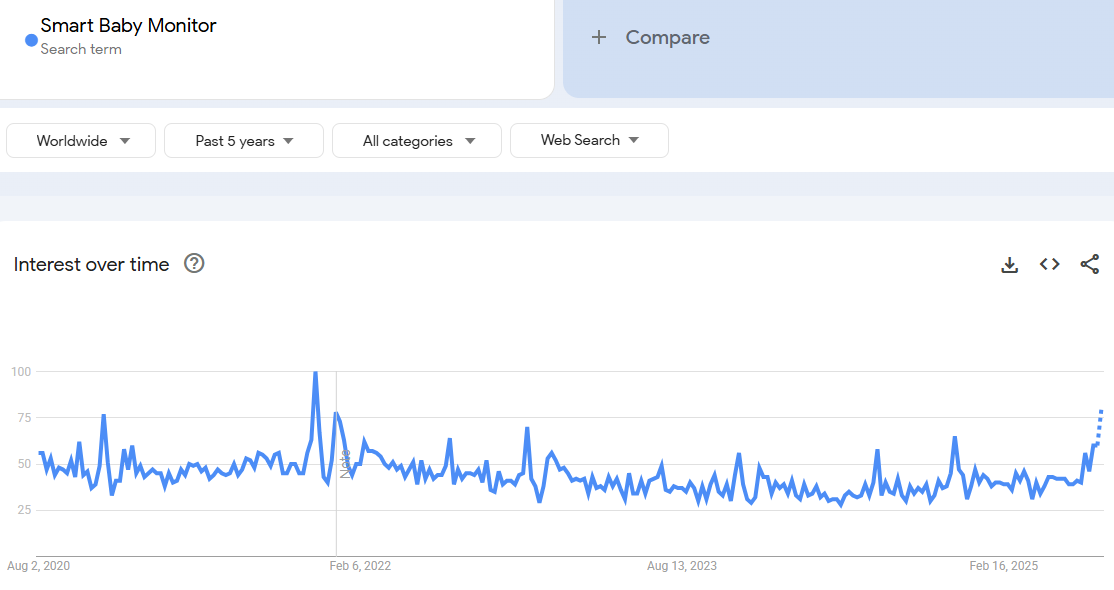
Target audience: New parents, especially millennials who are comfortable with tech, and anxious parents seeking peace of mind.
Market analysis: The baby product category is going increasingly tech-centric, driven by parental desire to ensure safety. Searches for smart nursery gear and baby health trackers are climbing steadily. Notably, products like Owlet smart socks (to monitor vitals) and the SNOO (responsive rocking bassinet) created a buzz. Though pricey, many new parents invest in these or add to registries. The baby products market is projected to grow from $250B in 2025 to $419B by 2032, and a chunk of that is innovative gear. Word of mouth in parenting groups (and fear of SIDS or missing a cry) often convinces parents to buy multiple devices.
Monthly search volume: ~20,000 (“smart baby monitor”), and heavy activity on parenting forums beyond raw search.
Price range: Basic WiFi monitor $50, advanced monitors $150–$300, smart bassinets ~$1,300 (often available for rent as well). Despite high costs, many see it as an investment in baby’s safety and parents’ sleep.
3.Baby Health & Safety Essentials
Products like nasal aspirators, baby thermometers, and baby-proofing kits. Particularly nasal aspirators (both manual and electric) are a standout.
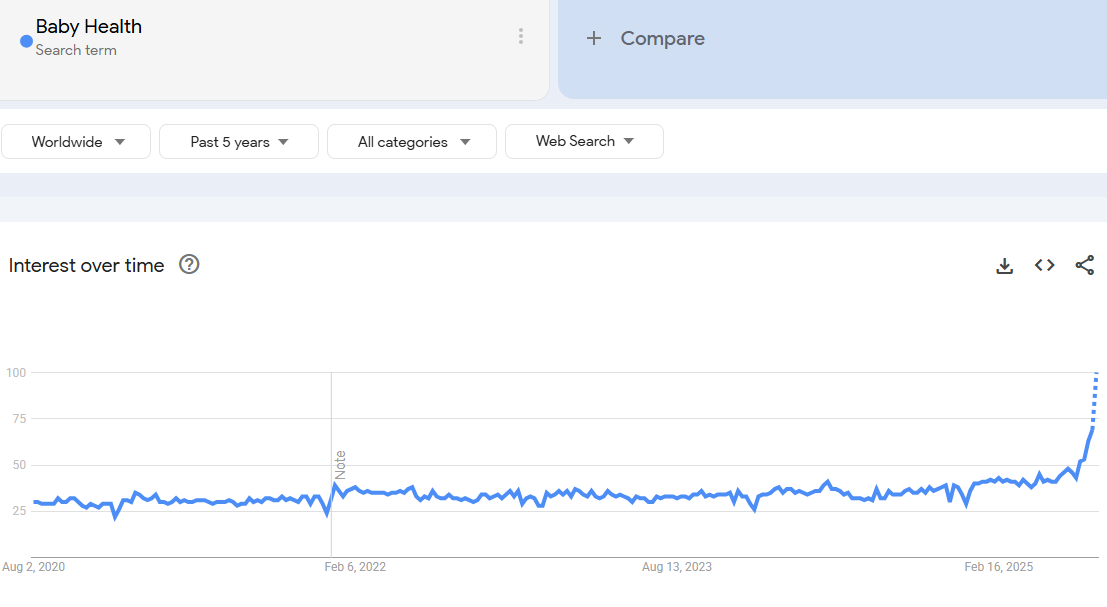
Target audience: Parents of infants and toddlers – essentially every new parent, as these are must-haves.
Market analysis: Practical health items show consistent growth because they solve real pain points (literally, in the case of a congested baby). Baby nasal aspirators have shown consistent growth; one electric model went viral on TikTok for how much gunk it could pull (gross but effective marketing!). Similarly, demand for contactless thermometers and smart health tracking (like Frida’s FeverFrida) is solid. As first-time parents increasingly turn to online research, they often learn about these products (e.g. NoseFrida became a household name through social media testimonials).
Monthly search volume: ~12,000 (“baby nasal aspirator”), spikes during cold seasons.
Price range: Manual aspirators ~$15, electric $30–$60. Thermometers $20–$50. Childproofing kits ~$20–$40. These mid-range prices and obvious utility make them quick additions to baby registries and Amazon carts.
4.Eco-Friendly Baby Clothes (Organic Bamboo)
Soft baby apparel made from organic cotton, bamboo viscose, or other sustainable materials.

Target audience: Millennial and Gen Z parents who value organic fabrics for their baby’s sensitive skin and those interested in eco-friendly lifestyles for their family.
Market analysis: Baby skin is delicate, and many parents are willing to pay a premium for natural, chemical-free fabrics. Bamboo baby clothing has emerged as a go-to choice, noted for being breathable and hypoallergenic. In fact, in the last 5 years it’s become a staple for many, reflecting a broader demand for thoughtful materials in baby products. Niche brands selling bamboo sleepers and onesies have exploded via Instagram shops. Additionally, sustainability-minded parents often choose quality over quantity, driving up average spend per item.
Monthly search volume: ~8,000 (“organic baby clothes”), plus brand-specific searches for popular eco baby brands.
Price range: ~$15–$30 for an organic cotton/bamboo onesie (vs. $5–$10 fast fashion). Multi-piece sets or special designs can be more. Many parents mix these in with cheaper basics, but the segment overall is growing as part of the $419B baby market by 2032 trend.
5.Water Wipes & Natural Baby Care
Ultra-pure baby wipes (like WaterWipes, made with 99.9% water) and other natural skincare for babies (organic diaper creams, etc.).
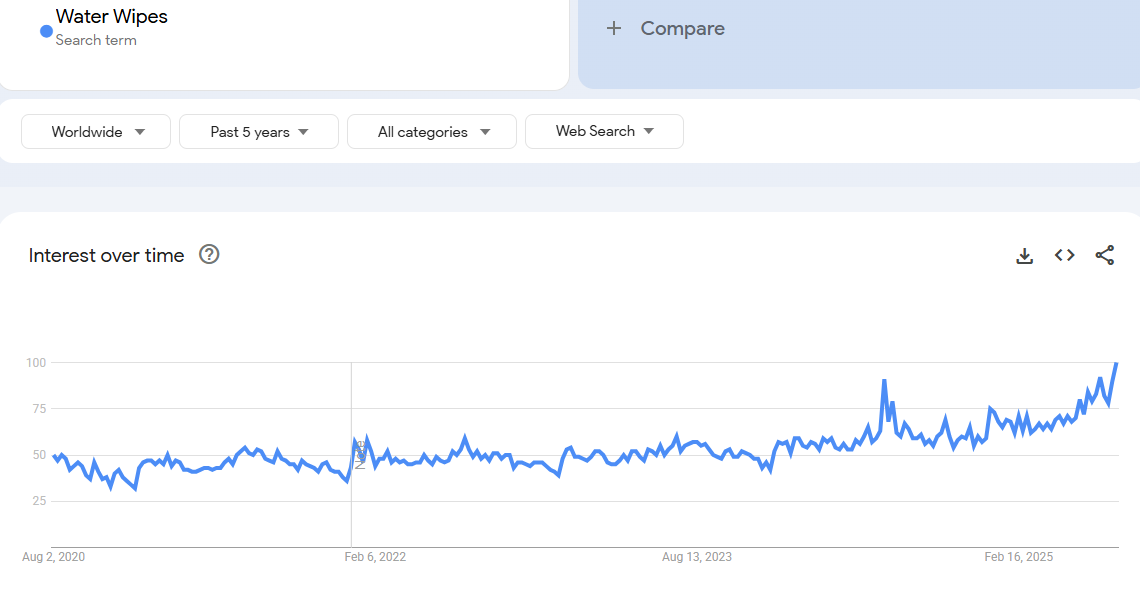
Target audience: Parents of newborns, especially those concerned about chemicals due to sensitive skin or conditions like eczema.
Market analysis: Baby wipes are an everyday essential, and WaterWipes carved a strong niche by marketing ultimate purity. They gained a reputation, even endorsed by healthcare professionals. Parents praise that they contain only water and a drop of fruit extract, relieving rash concerns. With growing awareness of what touches baby’s skin, WaterWipes and similar “99% water” wipes have surged in sales. Many hospitals now use them, further influencing new parent choices. This mirrors the general trend towards clean-label products for babies.
Monthly search volume: ~30,000 (“WaterWipes”), indicating brand strength.
Price range: Slightly higher than regular wipes – ~$4–$5 per pack of 60 (whereas generic might be $3). Lots of parents stick with them despite cost, or use them during the sensitive newborn phase then switch.
6.Silicone Baby Feeding Sets
BPA-free silicone tableware for babies and toddlers: suction plates, bowls, bibs, and utensils with soft silicone tips. Often in cute designs (e.g. bear shapes).
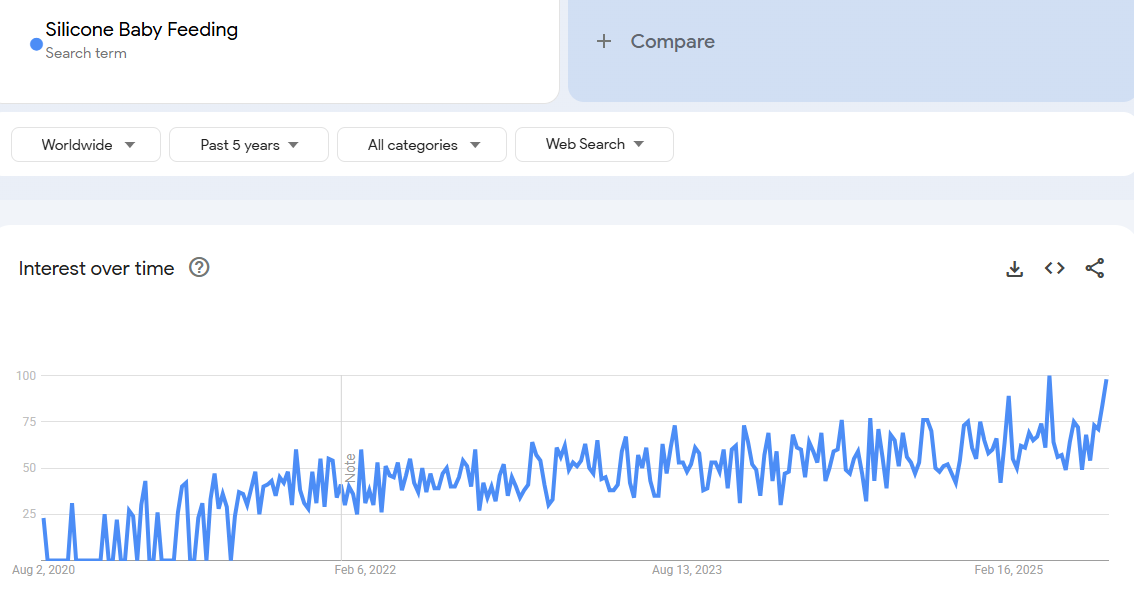
Target audience: Parents starting solids with babies (~6 months+), toddler parents encouraging self-feeding, and gift-givers (feeding sets are a popular baby shower gift).
Market analysis: As babies transition to solid food, parents love products that make the process easier and cleaner. Silicone feeding sets have boomed because they are safe (no BPA/phthalates), unbreakable, and often suction to the table to prevent flinging. A baby silicone tableware set was mentioned as a trending product, combining cuteness with practicality. It’s soft, non-toxic, and dishwasher-safe – huge pluses for busy parents. The set in example (fork, spoon, plate) illustrates what sells: adorable design + function, promoting independent eating in a mess-minimized way.
Monthly search volume: ~5,000 (“baby suction plate”), but many purchases driven by recommendations and registry adds rather than search.
Price range: ~$15–$30 for a multi-piece set (plate, bowl, utensils). Many parents are willing to pay for 1–2 good sets since they’ll be used daily and handed down to siblings.
7.Kids’ Play Tents & Teepees
Indoor play tents (often teepee-style or pop-up tents) that give kids a cozy play space.
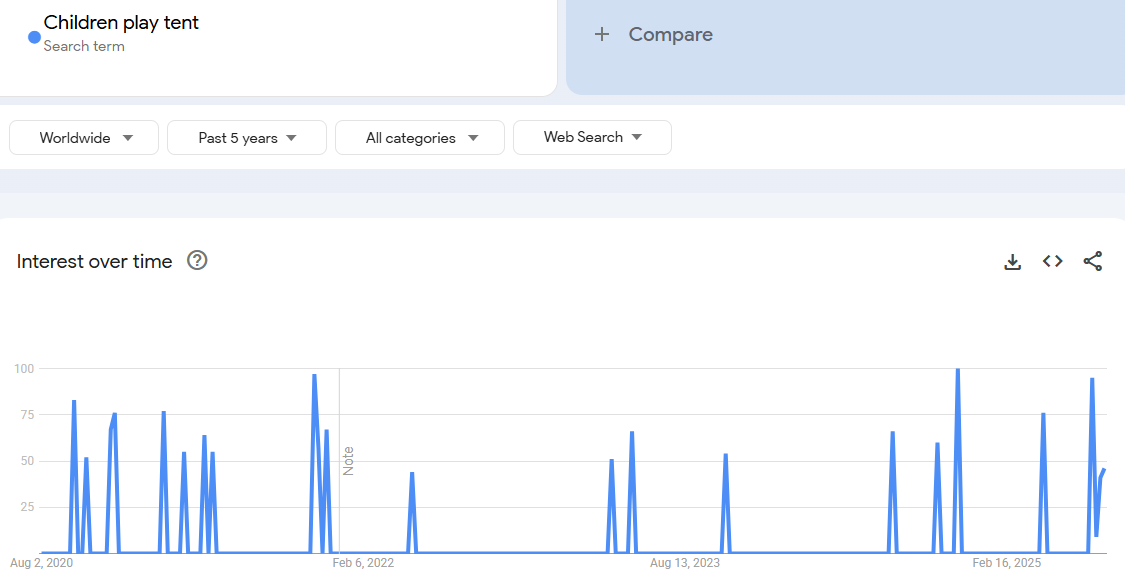
Target audience: Parents of toddlers and young kids (approx 2–7 years old), as well as gift buyers (grandparents, etc.) looking for a “wow” present.
Market analysis: Play tents create a magical mini-world for kids, fueling imagination in a screen-free way. One popular style is the canvas teepee tent, which has become a decor item in many modern playrooms. A kids’ play tent is cited as a trending product because it provides independent play and quiet time, plus it’s portable and photogenic. It aligns with Montessori ideas of giving children their own space. Sales often spike around holidays and birthdays. Instagram and Pinterest abound with cute setups of these tents with fairy lights and cushions – inspiring parents to recreate the look.
Monthly search volume: ~10,000 (“kids teepee tent”).
Price range: ~$40–$100. Many good options around $60–$80 which people find reasonable for a sizable, reusable toy that doubles as room decor.
8.STEM Educational Toys & Kits
Toys that teach Science, Technology, Engineering, Math concepts: e.g. coding robots for kids, chemistry sets, circuit board kits, and building block sets like magnetic tiles.

Target audience: Parents and educators of kids 6–12 who value learning through play, and gifted toy shoppers.
Market analysis: With the push for STEM skills, parents are actively seeking toys that combine fun and education. Products like coding caterpillars, kids’ microscopes, or Lego Technic sets have strong sales. Additionally, the pandemic’s remote learning period saw parents purchasing more STEM kits to supplement learning. Big retailers have expanded STEM sections, and smaller innovative brands (KiwiCo, etc.) offer monthly STEM subscription crates – also trending. Google queries for specific kits spike around back-to-school and holidays (when many parents buy these as “smart” gifts).
Monthly search volume: ~12,000 (“STEM toys”), but often specific like “Magna-Tiles” ~33k (magnetic tiles were a huge hit).
Price range: Simple kits $20–$50, advanced robotics kits $80–$150. Many see these as investments in their child’s development, justifying higher prices, especially if multiple siblings can use the kit.
9.Fidget & Sensory Toys for Kids
Items like Pop It fidget pads, sensory stress balls, chewable necklaces for sensory needs, and kinetic sand kits.
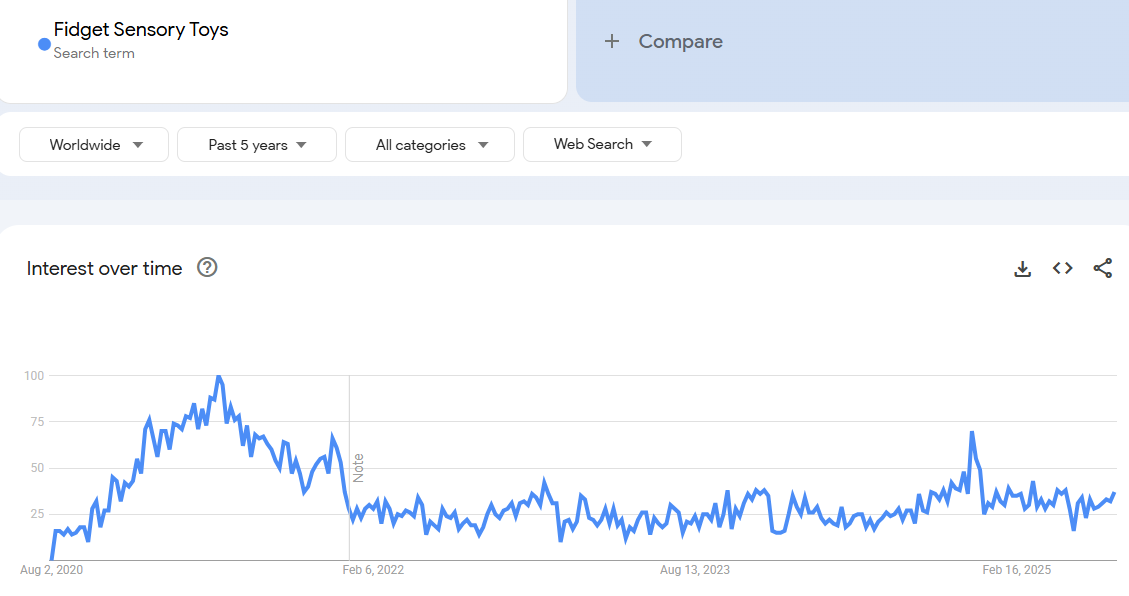
Target audience: Kids (and adults) with fidgety tendencies, including neurodivergent children (ASD, ADHD) who benefit from sensory play, as well as the general fad-following children.
Market analysis: Fidget toys became a massive trend in schools globally in the last couple of years (Pop It toys were the playground craze). While the initial fad has cooled slightly, a baseline demand remains. Teachers and therapists also use these as tools to help kids focus. Sensory toy sets (like different textured objects, putty, etc.) are increasingly included in toy catalogs, reflecting demand from parents looking to manage kids’ stress and improve fine motor skills. Social platforms show huge communities trading fidget toys and showing off collections.
Monthly search volume: ~60,000 (“Pop It fidget”), far higher at peak but still significant.
Price range: Pop It ~$5–$15, fidget variety packs ~$20, kinetic sand kits ~$15–$25. They’re generally low cost, which encourages impulse buying and collecting multiple.
10.Balance Bikes & Ride-On Toys
Pedal-free balance bikes for toddlers, as well as other popular ride-ons (scooters, foot-powered cars).

Target audience: Parents of toddlers (18 months – 4 years) for balance bikes, slightly older for first scooters; anyone getting kids active outdoors early.
Market analysis: Balance bikes have largely replaced tricycles as the preferred way to teach kids to ride. Parents rave that kids transition to pedal bikes easier if they start on balance bikes. Thus, their adoption soared in the past decade. Brands like Strider led the way and now even big bike companies have balance models. Also, with more focus on outdoor play for young kids (especially post-lockdown), things like mini scooters (e.g. Micro Kickboard) remain very popular. Search interest for “balance bike” is steady and high each spring. Combined with increasing focus on gross motor skill development in early childhood, these ride-ons are staples.
Monthly search volume: ~33,000 (“balance bike”).
Price range: Balance bikes ~$50–$120. Many quality ones around $80 – parents often gift these for 2nd birthdays. Scooters for little ones ~$30–$100. Given their longevity (can be used for a couple of years and passed on), parents see good value in spending for durability.
Best Trending Personalized Gifts Products
1.Custom Phone Cases
Phone cases that can be personalized with names, initials, photos, or bespoke designs.
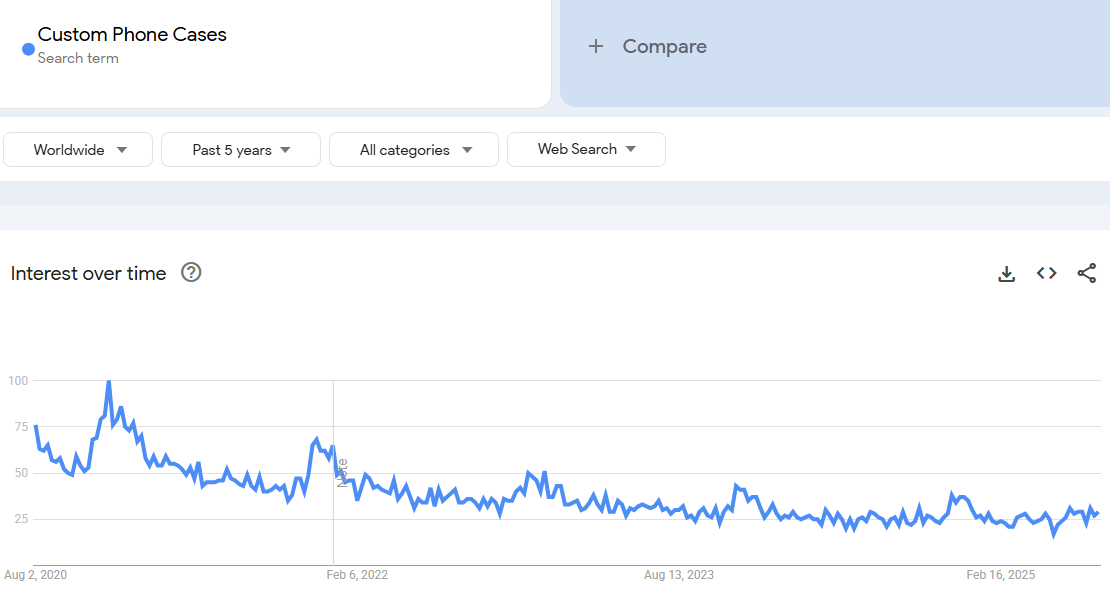
Target audience: Primarily younger consumers (teens, college students) and gift-givers (a custom phone case is a popular small gift). Also businesses or events sometimes order them as merch.
Market analysis: With over 18 billion mobile devices in use globally, the accessory market is enormous – phone cases alone are a $27.3B industry in 2025. Personalized cases stand out as people seek to differentiate the look of ubiquitous devices. Many online services let you upload photos or add monograms easily, fueling impulse buys. There are seasonal spikes (before new iPhone releases, holidays for gifting). Social media ads for custom cases (e.g. with a collage of your Instagram pics) have proven very effective.
Monthly search volume: ~40,000 (“custom phone case”).
Price range: ~$15–$30. Consumers expect to pay a bit more than a generic case for the custom aspect. Often offered with promotions (buy one get one half off for couples cases, etc.), which increases uptake.
2.Personalized Mugs & Tumblers
Drinkware with custom text, names, or images (think “World’s Best Dad [Name]” mugs, or engraved tumblers with a person’s name).
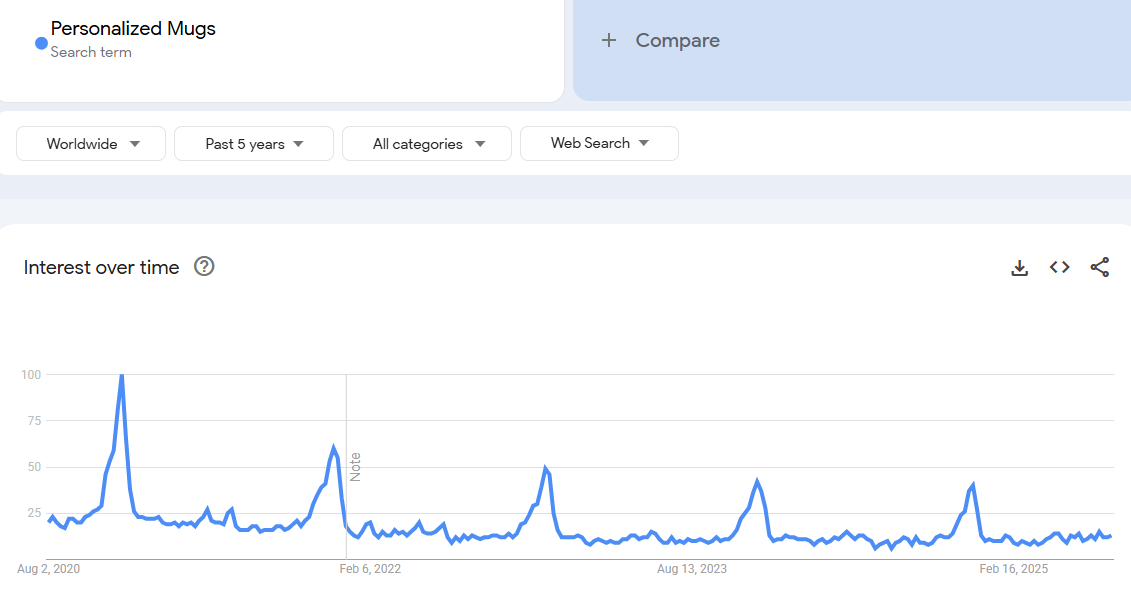
Target audience: Gift buyers (Mother’s/Father’s Day, teacher gifts, etc.), corporate swag buyers, and individuals who love seeing their name on things.
Market analysis: Mugs are classic gifts, and the trend continues strong. People are emotionally attached to their favorite mug – nearly 60% report this feeling – which makes a personalized mug potentially someone’s cherished item. The rise of high-quality laser engraving and print-on-demand made it easier to personalize not just ceramic mugs but also stainless steel travel tumblers (which became very popular with the advent of products like Yeti). On Etsy and similar marketplaces, custom mugs are perennial bestsellers. Personalized water bottles/tumblers also saw increased interest as part of wellness trends (everyone carrying a water bottle).
Monthly search volume: ~20,000 (“personalized mug”), plus strong presence on customized product sites.
Price range: ~$10–$15 for custom mugs (often with volume discounts for larger orders), $20–$40 for personalized insulated tumblers. Reasonable price points make them accessible gifts for anyone.
3.Custom T-Shirts & Apparel
T-shirts, hoodies, even socks printed or embroidered with custom messages, images, or inside jokes.

Target audience: Event organizers (family reunions, bachelor parties), small businesses (merch or uniforms), and friend groups or individuals wanting unique attire.
Market analysis: The print-on-demand industry thrives on custom apparel. While not new, it’s only grown with better digital printing tech. People love wearing something that represents them uniquely, whether it’s a niche meme or their own artwork. For gifts, personalized shirts (think matching couple tees, “I’m with ___” shirts) are common. Shopify notes that shirts and tops are the #1 bestselling products for their merchants, and part of that success is the ease of customizing and offering endless designs. Spreadshirt, Teespring, etc., all capitalized on this.
Monthly search volume: ~30,000 (“custom t-shirt”) – robust as people often search for where to get it made.
Price range: ~$20–$30 for a single custom tee. Many sellers use tiered pricing (cheaper per shirt for bulk orders). People are generally willing to pay a bit more than a mass-produced tee for personal flair.
4.Name Necklaces & Jewelry
Necklaces, bracelets, or keychains featuring someone’s name, initials, or a personal message (engraved or crafted).

Target audience: Partners gifting each other (think name necklaces, coordinates bracelets), mothers (children’s names jewelry), and individuals treating themselves to a personalized piece.
Market analysis: Personalized jewelry hits a sentimental sweet spot. Shoppers increasingly seek meaningful, customized pieces – e.g., single-letter initial pendants are popular as easy personalization and gift-friendly items. This trend got a boost from celebrities (e.g., Carrie’s famous “Carrie” necklace in Sex and the City started a craze). Now, countless options exist in all price ranges. Etsy’s marketplace of jewelry sellers thrives largely due to custom offerings. Men’s personalized accessories (engraved cufflinks, ID bracelets) are also notable around wedding season.
Monthly search volume: ~27,000 (“name necklace”).
Price range: Huge range – fashion jewelry $20–$50 for plated name pieces, sterling silver around $50–$100, solid gold $200+. Many consumers opt for mid-range gold-plated or silver options that look high-end without costing a fortune.
5.Star Maps and Custom Art Prints
Posters or framed prints that are personalized, such as a map of the stars on a specific date (anniversary, birth), custom city maps, or personalized family illustrations.
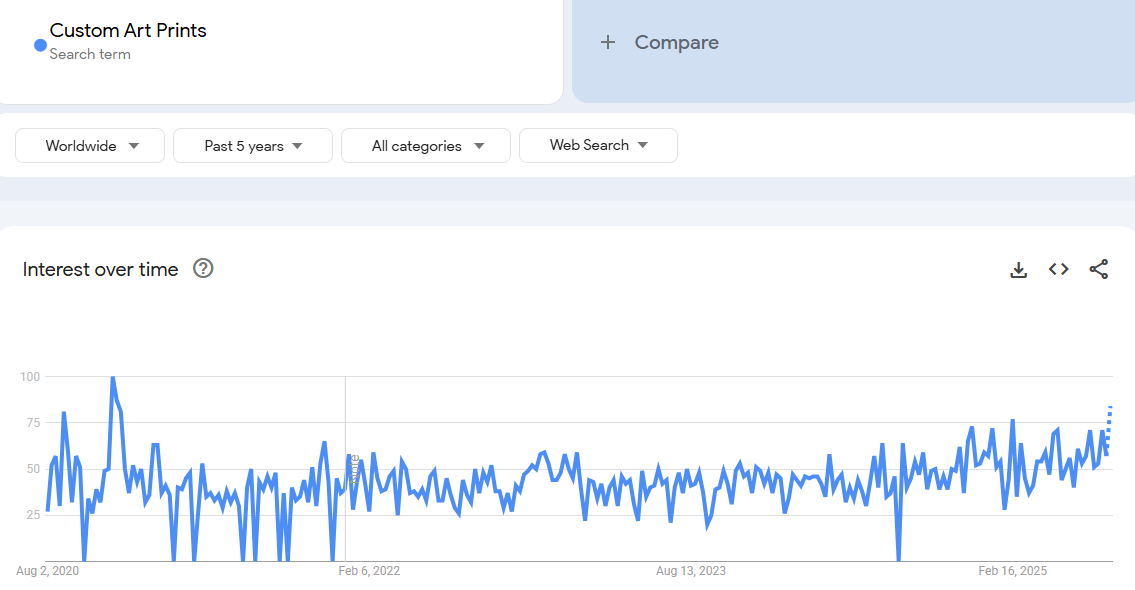
Target audience: Romantic gift buyers (star maps are popular for anniversaries), new parents (nursery custom art), and folks commemorating special moments.
Market analysis: Personalized art has become a big niche thanks to digital printing and online design tools. The “star map on your special night” poster was a viral product a couple years back and still remains a go-to sentimental gift. People also enjoy custom cartoon portraits of their family or pets, which are often sold via artists on Etsy. It’s the kind of heartfelt decor that’s Instagrammable too (“look what my SO gifted me!”). DIY sites let users generate these prints easily by inputting dates/locations.
Monthly search volume: ~10,000 (“custom star map”), plus interest spikes around Valentine’s Day.
Price range: Digital file from an artist ~$30, printed and framed star map $50–$100 depending on size and frame quality. Many find the emotional value worth the cost for a one-of-a-kind art piece.
6.Photo Books and Calendars
Printed photo albums or calendars filled with personal photos and captions (often created via online platforms).

Target audience: Families documenting memories, couples making year-in-review books, proud pet owners, and as gifts for grandparents or relatives who cherish photo memories.
Market analysis: Even in the digital age, tangible photo books are cherished. Companies like Shutterfly have built an empire on this. Each year, people create custom calendars (with family photos marking each month, often given at holidays). And for events like weddings or baby’s first year, photo books are very popular. The trend persists because while social media has our photos, there’s nostalgia and satisfaction in flipping through a real album – especially for older family members or coffee table displays.
Monthly search volume: ~30,000 (“custom photo book”), peaks in Nov-Dec (holiday gift-making season).
Price range: ~$20–$50 per book (varies by pages and cover type), calendars ~$15–$30. There’s frequent promo pricing (e.g., buy one get one), encouraging more orders. People often make these annually or for major life events, fueling repeat usage.
7.Engraved Cutting Boards & Home Gifts
Wooden cutting boards or kitchen items engraved with family names, special dates, or messages (e.g., a board that says “Grandma’s Kitchen established 2025”).
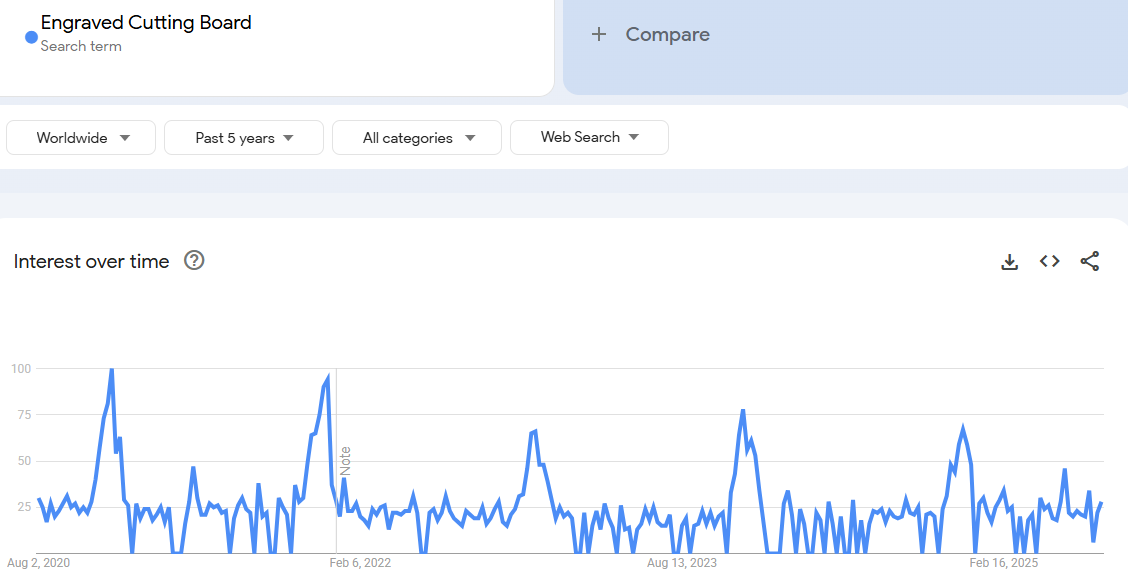
Target audience: Wedding and housewarming gift buyers, as well as families personalizing their kitchen.
Market analysis: Personalized home items grew popular through Etsy and artisan markets. An engraved cutting board is both decorative and functional – newlyweds love them, and they often appear in wedding registries or real estate agents’ closing gifts. Other similar trending items include personalized serving trays, recipe boxes with engraved names, etc. The handmade feel plus personalization = a thoughtful gift that stands out. Laser engraving tech made it efficient to produce these at scale while still offering custom touches.
Monthly search volume: ~5,000 (“personalized cutting board”) – much search happens on Etsy or via Google Shopping integration.
Price range: ~$30–$70 depending on wood quality and size. Many buyers don’t mind the price since it’s a premium, long-lasting item (often they aren’t daily cutting boards but keepsakes).
8.Personalized Children’s Books
Storybooks where the child’s name (and sometimes likeness) is woven into the story, making them the hero.
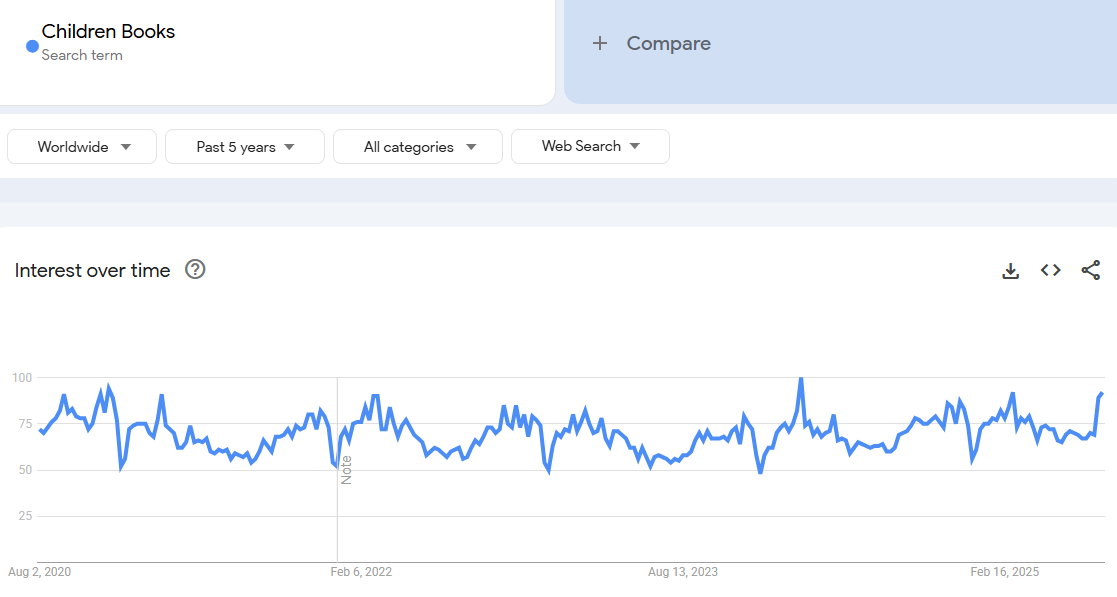
Target audience: Parents and relatives of young children (ages ~2–7), often for birthday or holiday gifts.
Market analysis: Kids light up seeing themselves in a story. Companies like Wonderbly (formerly Lost My Name) proved the viability of this – their flagship personalized book sold millions of copies. This trend addresses both the gift market and educational market, encouraging kids to read by making it about them. Search and social ads target grandparents especially (“Best gift for your grandchild!”). The novelty and emotional factor make these strong sellers.
Monthly search volume: ~6,000 (“personalized kids book”) – not massive, but many customers come from word-of-mouth after seeing one.
Price range: ~$30–$50 per book. It’s higher than standard kids’ books, but buyers perceive it as a unique, memorable present. Many are willing to buy one per child given its keepsake nature.
9.Custom Pet Portraits & Gifts
Artistic portraits of people’s pets (drawn/painted or digital), often printed on canvas or made into items like pillows, phone cases,
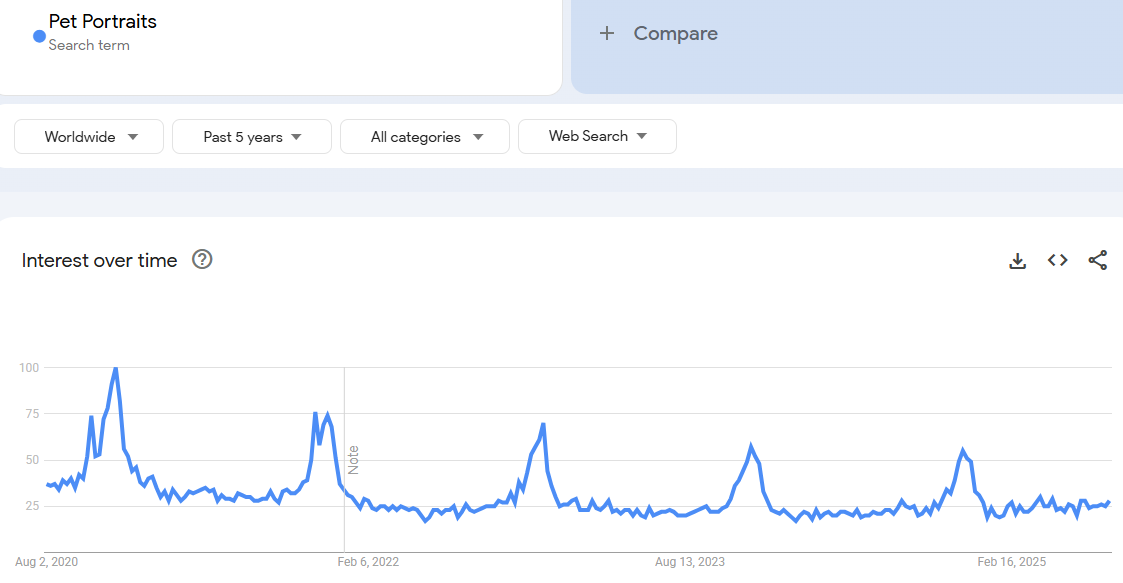
Target audience: Pet owners who treat pets as family (so, a lot of people!), and friends/family getting gifts for pet lovers.
Market analysis: The pet industry overlaps with personalization heavily. Many artists on Etsy offer to turn a photo of Fluffy into a Renaissance-style painting or a cartoon, and these have gone viral at times for how delightful (or humorous) they are. Additionally, simple personalized pet items like name-embroidered collars or custom photo blankets are in steady demand. With pet ownership at an all-time high, people spend lavishly on pet-related decor and keepsakes. Personalized pet portraits in particular saw a spike as a quarantine hobby – lots of folks immortalized their pandemic puppy in art form.
Monthly search volume: ~8,000 (“custom pet portrait”).
Price range: Commissioned digital portraits ~$40–$100 (depends on artist skill and whether physical print included), personalized pet accessories $15–$30. Pet parents often splurge similarly as they would for items about their human kids.
10.Unique Personalized Keepsakes
This includes an array of smaller yet sentimental items like engraved keychains (with coordinates or handwriting), music boxes that play a couple’s song, personalized puzzles (photo puzzles), etc.
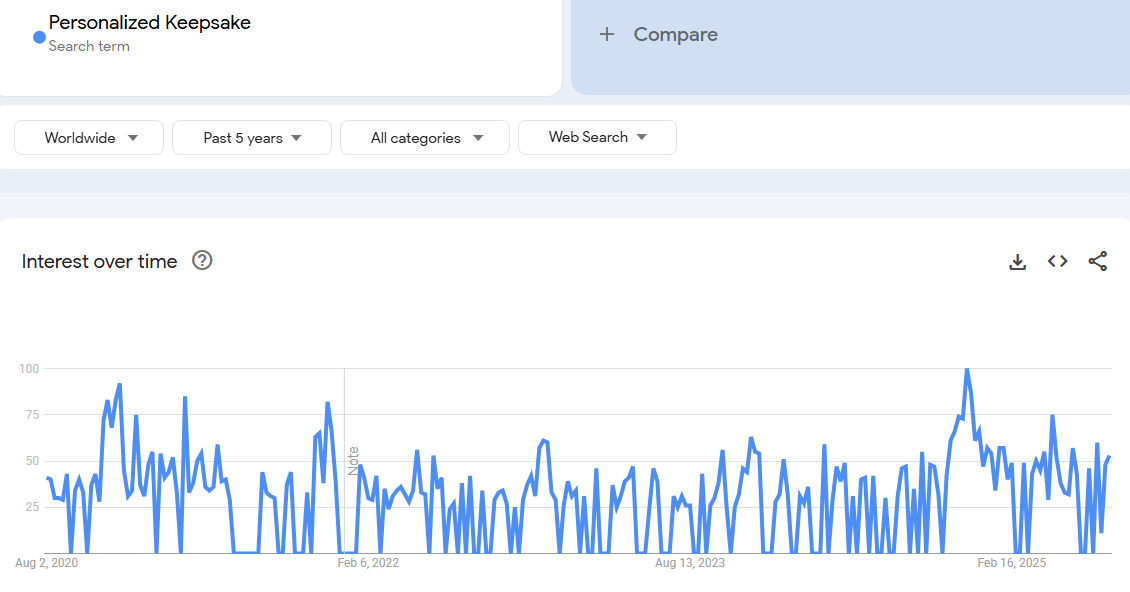
Target audience: People celebrating relationships (anniversaries, long-distance couples exchanging coordinates keychains), travelers commemorating a place (coordinate keychains/necklaces), and families preserving a memory (e.g., puzzle of a family photo).
Market analysis: These niche keepsakes circulate widely on Pinterest and Facebook ads, capturing impulse buys for special occasions. A keychain with the exact GPS coordinates of where a couple met, or jewelry engraved with a loved one’s actual handwriting (captured from a note) – these are intimate gifts that have trended as technology allowed such customization. Photo puzzles became quite popular during lockdowns too, serving both as entertainment and a personalized gift. The broad variety means while each sub-item is niche, collectively the category is significant.
Monthly search volume: ~4,000 (“engraved keychain”), etc. Much business happens via viral posts and Etsy browsing.
Price range: ~$10–$20 for keychains, $30–$60 for custom music boxes, $25–$50 for photo puzzles. Often purchased for meaningful dates (weddings, etc.). Buyers appreciate the relatively low cost for something so personalized.
How to Identify High-Growth Niches for 2025
Finding a lucrative niche is about spotting where demand is rising and competition isn’t yet oversaturated. Here are strategies to identify high-growth niches in 2025:
-
Follow Market Data: Look at industry reports and projections to see which categories are booming. For example, projections show Apparel & Footwear on track to reach $2 trillion by 2028, and Beauty & Personal Care valued around $758 billion in 2025 (with natural skincare $19B). Likewise, Baby Products are expected to grow from $250B in 2025 to $419B by 2032 – indicating huge potential if you find a unique angle in the baby niche. Such data highlights big-picture growth areas.
-
Use Google Trends: Enter niche keywords on Google Trends to gauge interest over time. You’re looking for upward trajectories or sudden spikes. For instance, seeing sustained rising interest in “eco-friendly products” or “home fitness” could validate those niches. If you suspect wireless chargers are hot, Google Trends can confirm if search interest is indeed climbing (and in which regions). High-growth niches often show clear uptrends or seasonal surges that get bigger each year.
-
Observe Social Media and Pop Culture: Fast-growing niches often germinate on social platforms. Check TikTok hashtags and communities for viral product categories (e.g. #VanLife for outdoor gear, #CleanBeauty for skincare). In 2025, TikTok and Instagram are major trendsetters – viral engagement can hint at niche growth before formal data catches up. For example, TikTok’s #PerfumeTok (4.2B views) revealed a spike in interest in fragrance layering, and #RoomTransformation (for home decor) signaled the DIY decor niche’s strength.
-
Identify Emerging Problems or Desires: High-growth niches solve new problems or cater to new desires. Think of changes in lifestyle or technology – e.g., widespread remote work created opportunities in home office equipment; increasing environmental awareness is boosting sustainable goods. Ask: What do people need or want now that they didn’t before? The answers often lead to growth niches (like ergonomic home office gear, or plant-based alternatives in food and products).
-
Check Sales on Marketplaces: Browse Amazon’s Best Sellers or Movers & Shakers across categories to see what’s climbing fast. Also use tools like Jungle Scout or Helium 10 to spot keywords with surging search volume but relatively few top-tier competitors. If an item’s sales rank is quickly improving or a subcategory has many new entrants, that niche might be heating up. For instance, if you see lots of new weighted hula hoop brands doing well, the “at-home fitness gadgets” niche might be on fire.
-
Consider Demographic Shifts: The interests of large demographic groups (like Gen Z entering the workforce, or aging Millennials with kids) can foreshadow booming niches. Gen Z’s love for thrifting and values-based shopping suggests growth in secondhand and ethical niches. The aging population worldwide suggests health-tech and assistive products will grow. Align niches with these macro shifts for high potential.
-
Validate with Communities: Once you suspect a niche (say, “pet tech” or “DIY cosmetics”), lurk in related forums, subreddits, or Facebook groups. A very engaged, growing community often indicates a promising niche. If you find lots of chatter, unmet needs, or excitement about new products in those communities, that’s a green light. For example, an exploding subreddit on electric bikes signals sustained niche momentum.
Remember, a “niche” can be a specific segment of a larger category. Instead of just “beauty,” it might be “male grooming subscription boxes” or instead of “fitness,” maybe “postnatal fitness programs.” High-growth often happens in these focused sub-niches where consumer passion is high but big corporations haven’t dominated yet. Combining data-driven research with on-the-ground trendspotting will help you pinpoint niches that are poised for major growth in 2025 and beyond.
How to Find Trending Products
Identifying trending products requires keeping your ear to the ground and leveraging a few key tools and tactics:
-
Use Trend Research Tools: Start with free tools like Google Trends to see if a product’s search interest is rising. For example, plug in “air fryer” and you’d have seen its interest surge in past years. Also use platforms like Exploding Topics, which highlight products with rapid growth (our list referenced several from there, like bakuchiol serum and toe spacers with triple-digit growth). These tools surface early-stage trends before they saturate.
-
Browse Social Media Virality: Many trending products go viral on TikTok, Instagram, or YouTube first. Monitor hashtags and viral videos for products that appear repeatedly. TikTok in particular has launched items like the TikTok leggings, heatless hair curlers, etc., into massive demand. Follow influencers in your niche and see what products they unbox or rave about. If multiple creators in a short span feature a product (sponsored or organically), it’s likely trending. For instance, the Stanley Quencher tumbler blew up after social influencer attention, something you’d catch by watching TikTok’s lifestyle content.
-
Check Online Marketplaces’ Movers: Amazon’s Movers & Shakers and Trending Now sections (or Etsy’s “Popular Right Now”) are gold. These show which products have had big rank jumps in sales over the past 24 hours. If you regularly scan these, you can spot spikes (like a particular toy suddenly climbing near holiday time). Remember not to cite Amazon search results directly as a source, but use them as a directional signal. For example, if you see surge protectors and ice makers in Amazon’s trending list, those might be having a moment (perhaps due to seasonal demand or news events).
-
Leverage Pinterest and Etsy: Pinterest is essentially a visual trend engine. Look at the Pinterest Trend tool or simply search for terms like “2025 must-haves” or browse popular pins in categories like Home, Fashion, DIY. Pinterest’s user base often skews to planning purchases, so rising pins = rising interest. Etsy’s front page or trends reports can similarly show which handmade or personalized items are gaining traction (Etsy releases trend reports each season highlighting popular searches).
-
Monitor News & Pop Culture: Sometimes a news event or pop culture moment drives a product trend. E.g., a famous celeb uses a certain skincare tool on a TV show – next day, that tool’s a hit. Or new technology (like next-gen VR headset) creates peripheral product demand (VR accessories). Set up Google Alerts for “trending product” or join entrepreneur communities where people often chatter about “what’s selling hot right now.” Even Twitter can be a quick pulse-check for sudden buzz. The key is to connect the dots: when the Apple Vision Pro was announced, smart entrepreneurs anticipated a spike in AR/VR accessories and started scouting those products.
-
Seasonal Trend Cycles: Many trending products are seasonal or tied to events. Use a calendar to your advantage. Search for trending items by year/season (e.g., “summer 2025 trending products”). Historically, there are patterns: fitness gear spikes in Jan, patio and gardening in spring, toys in Q4. But each year has unique hits (like fidget spinners one year, squishmallow plushies another). Reading Shopify’s or HubSpot’s yearly trend recaps can prepare you for upcoming seasonal fads.
-
On-the-Ground Research: If possible, observe brick-and-mortar retail buzz. Are people lining up for something (console releases, sneaker drops)? Are local boutiques prominently featuring a type of product? Visiting trade shows or even scanning bestseller shelves at stores can yield hints. For example, if every gadget store front displays ring lights and streaming mics, that tells you the “creator gear” trend is hot.
-
Compile and Validate: When you think you’ve found a trending product, validate it by checking multiple sources. Say you noticed “toe spacers” in Exploding Topics (they showed 292% growth). You’d then see toe spacers all over fitness Instagram, plus Amazon has new brands selling them – that triangulation confirms it’s a real trend, not a blip. Look for consistency: a trending product will usually appear in social buzz, search trend, and sales rank improvements concurrently.
-
Keep a Swipe File: Maintain a list or spreadsheet of interesting products you come across, along with notes on where you saw them trending. Revisit it every few weeks to see which ones gained momentum and which fizzled out. This builds your intuition over time.
By combining these methods, you’ll cast a wide net for trend signals. Essentially, you become a detective following clues: a viral TikTok here, a search spike there, a half-dozen new Amazon listings on page 1 all of a sudden – together these scream “trending product.” Act fast when you’ve confirmed a trend, because timely execution is everything (some fads can be brief!). Remember, trending products often align with larger trends (e.g., home fitness, eco-consciousness, nostalgia), so understanding those macros helps you find the specific products riding that wave.
How to Validate Your 100+ Product Ideas for Profitability
Having a big list of product ideas is exciting, but before investing time or money, you need to validate which ones can actually make you a profit. Here’s how to sift through your 100+ ideas and zero in on winners:
-
Conduct Keyword and Market Research: For each product idea, use tools like Google Keyword Planner or Ubersuggest to see search volumes and competition. If “ceramic coffee dripper” has decent search volume and not dominated by big brands, that’s a positive sign. Avoid products with extremely low search volume (no demand) or insanely high competition where you can’t differentiate. Essentially, you want to find evidence of demand but also room to stand out. If your idea is a niche like custom pet portrait mugs, check how many sellers exist and how well they’re doing via their reviews/sales rank. The sweet spot is a product that people are looking for, but not every major retailer is selling yet.
-
Analyze Competitors and Pricing: Identify the top 5–10 competitors for each idea. How are they pricing the product? What are their reviews like? This helps gauge viability: can you match or improve on their offering and still profit? Calculate a rough cost of goods (via Alibaba or local suppliers) and compare to market price. For profitability, a common rule is aim for a product you can sell at 3x–4x its cost (to cover marketing, fees, profit). For instance, if a baby silicone feeding set sells for $30, you’d want your cost ideally around $7–$10. If competitor prices are in a race to the bottom with razor-thin margins, that product might not be worth it unless you can add significant value.
-
Read Customer Reviews (Pain Points): Go through reviews of existing products in that category, especially the 3-star ones. They often reveal unmet needs or problems. For example, if many say “this camping tent is great but the zipper breaks,” that’s an opportunity to source a tent with a better zipper. Validation comes from confirming you can solve a pain point or add a unique feature people want. Reviews also tell you how well the product delights users – a product with consistently happy customers (and growing review count) indicates stable demand. Conversely, if customers express lukewarm interest or lots of returns, reconsider that idea.
-
Test on a Small Scale: Before fully committing to a product, do a small test. If possible, create a quick landing page or a preorder campaign. You could use a platform like Kickstarter for innovative products – if strangers back your project with real money, that’s strong validation. Or run a modest Facebook ad campaign for a dropshipping version of the product (if feasible) and see if you get conversions. For instance, if you have a gut feeling about a new type of fidget toy, put up a one-product Shopify store, spend $50 on targeted ads, and gauge interest. If you get some sales or lots of add-to-cart activity, it’s promising; if crickets, you may need to tweak the offer or drop the idea.
-
Calculate Unit Economics: Crunch the numbers beyond cost – consider shipping, any import duties, platform fees, and marketing cost per sale. A product might have demand, but if it’s heavy or large (high shipping) or requires expensive PPC ads to sell, the margin could vanish. For each idea, do a rough profit calculation: Selling price – (product cost + shipping + fees + ad cost per sale) = profit. Only pursue ideas where this profit is healthy and scalable. If a certain baby product will net you just $1 profit per unit after all costs, you’d need huge volume to survive – probably not ideal unless volume is guaranteed. Aim for products where you can comfortably achieve a solid profit per unit to buffer against unforeseen costs or price wars.
-
Assess Longevity and Seasonality: Some products trend hard but burn out fast (fads), others have perennial demand. Decide what balance you want. Having a few seasonal hits is fine, but you generally want products you can sell year-round for sustained profit. Use Google Trends to see if interest is steady or seasonal. If it’s purely seasonal (like snow gear), plan accordingly and have complementary products for off-season. Also consider if the product is a “one-off purchase” or can lead to repeat sales. Profitability is higher when you can get repeat customers (consumables, refills, or product lines). For example, a personalized gift might be one-time, but something like skincare or supplements could have reorders, enhancing lifetime value.
-
Validate Social Proof: If you already have an audience (say on social media or an email list), float your product ideas to them. A quick poll like “Which of these would you buy?” can give surprisingly clear direction. People love giving opinions, and though not everyone who says they’d buy will do so, it separates lukewarm ideas from exciting ones. Even posting concept pics or asking for feedback in relevant Facebook groups can be insightful (just be cautious not to reveal too much to potential competitors). If your target demographic collectively yawns at an idea, better to know now.
-
Avoid the Common Pitfalls: Validate that your product isn’t violating any IP (e.g., don’t sell something trademarked), and that it meets safety standards. A product might look profitable until you realize you need costly certifications or there’s a patent blocking your path. Do a quick due diligence check for each – search the USPTO for patents if it’s a novel gadget, ensure any electronics have required certs (FCC, CE), etc. This might save you from pursuing a legally or logistically unfeasible idea.
In summary, validation is about making sure there’s real demand and real profit behind the ideas on your list. It’s better to thoroughly test and refine 10 excellent product ideas than to blindly launch 100 and hope. By checking demand signals, analyzing competitors, running numbers, and even doing small tests, you’ll filter out the duds and highlight the gems that can truly thrive in the market. When you go through this vetting process, you might discover that maybe 10–20 of your original 100+ ideas carry 80% of the profit potential – those are the ones to double down on.
What Are the Best Trending Products for Dropshipping?
If you’re pursuing a dropshipping model (selling products shipped directly from supplier to customer), you’ll want trending products that fit key dropshipping criteria: not too expensive, relatively small/light, unbranded or generic enough to source easily, and with proven demand online. Here are some of the best types of trending products suited for dropshipping in 2025:
-
Tech Accessories and Gadgets: Small electronics accessories are ideal for dropshipping. Think wireless chargers, phone mounts, earbuds, LED strip lights – all trending and easy to source from platforms like AliExpress. For example, MagSafe car mounts (searches up ~90% last year) or car phone holders are in demand and can be shipped compactly. These have broad appeal and steady turnover. Just ensure any electronic item has quality control – source from suppliers with good reviews to avoid returns.
-
Fashion Jewelry & Accessories: Trending fashion items like layered necklaces, charm bracelets, or bucket hats (which saw a 350% interest increase) can be great for dropshipping. They’re lightweight, have high perceived value yet low sourcing cost, and style trends can be tested quickly. Personalized jewelry (like initial necklaces) is a bit trickier for classic dropshipping due to customization, but generic trending styles (e.g., Y2K-inspired butterfly chokers) can be pulled off a supplier’s shelf and shipped on demand.
-
Beauty Tools and Accessories: Many trending beauty gadgets are well-suited for dropshipping. Examples: facial rollers, LED face masks, heatless curlers (a TikTok trend), etc. They’re small and often unbranded, so you can find generic versions through suppliers. The beauty niche thrives on newness – consumers love trying novel tools, which lends itself to the dropship model of quick turnover. Ensure compliance for anything that touches skin (most tools are fine; just avoid chemical products that need certification if you’re not ready for that).
-
Pet Supplies: Pet products are evergreen and lots of them fit dropshipping: think pet grooming gloves, interactive laser toys for cats, portable pet water bottles, or cute pet outfits. We saw stainless pet bowls trending up – those can be dropshipped too. Pet owners are avid buyers, and dropshipping allows you to offer a wide catalog of fun pet items without holding stock (like the quirky pet bed designs or new puzzle toys). Just pick items that ship easily (e.g., avoid extremely heavy litter boxes, but toys and accessories are great).
-
Home and Kitchen Gadgets: Dropshipping thrives on solving little problems. Trending home gadgets like vegetable choppers, reusable silicone stretch lids, or decorative LED lamps are all good candidates. For instance, the smart RGB floor lamp (popular with gamers) – you can often find similar LED lamps via suppliers. Also, kitchen gizmos that go viral (say a unique ice cube tray or a dumpling maker) can sell like hotcakes once a TikTok shows how they work. These impulse buys in home/kitchen category often have low cost and high margin potential in dropship.
-
Fitness Accessories: While heavy gym equipment is out, smaller fitness accessories that trend (like resistance band sets, yoga rings, massage balls) are excellent for dropshipping. A prime example was the weighted hula hoop that went viral on TikTok – lots of dropshippers made money off that trend by sourcing identical hoops from overseas. With continued interest in home workouts, items like push-up board sets or portable Pilates bars can be sourced and shipped one-by-one. They satisfy a current need without requiring you to buy bulk inventory.
-
Lifestyle and Novelty Products: These are the fun, quirky items that often do well in a one-product dropshipping store format. Fidget gadgets, novelty lighting (like galaxy projectors), or seasonal decor (e.g., holiday laser lights) can explode in demand. For example, galaxy star projectors were a big trend – easy to dropship, decent markup. The key is catching the wave early and marketing cleverly via social media ads. Because they’re novelty, you don’t want to overstock – perfect for dropshipping’s just-in-time model.
Why dropship these? They tend to meet dropshipping’s sweet spot: not too fragile (avoiding high defect rates), not oversized (keeping shipping cheap), trending among impulse buyers (so good ROI on ads), and available through multiple suppliers (no single brand monopoly). Plus, categories like phone accessories or beauty tools often have constant new iterations, so you can refresh your store with the next trend easily.
One crucial aspect: even though you’re not holding inventory, quality test samples from suppliers. Trending or not, if a product arrives broken or subpar, your dropshipping venture will suffer from returns and bad reviews. So once you identify a promising dropship product (say, a pet hair remover brush that’s trending via video virals), order one yourself to vet it.
In summary, the best dropshipping products are those that align with current trends (so marketing them is like pushing an open door) and fit the logistical constraints of dropshipping. The examples above – tech gadgets, small fashion/beauty items, pet and home accessories – have historically been winning choices for dropshippers and continue to be in 2025, especially when you piggyback on what’s hot now.
How to Start Selling Trending Products Online
Ready to capitalize on these trends? Here’s a step-by-step guide to get your online selling started:
-
Choose Your Selling Model and Platform: First, decide if you’ll hold inventory or use dropshipping/print-on-demand. This affects everything from upfront cost to shipping. For beginners, dropshipping or print-on-demand can be lower risk (no inventory investment). Next, pick a platform: popular options are Shopify (for building your own store), marketplaces like Amazon or Etsy, or even social commerce on Instagram/Facebook shops. For example, if you’re selling a variety of trending gadgets, a Shopify store gives flexibility and branding. If it’s personalized gifts or crafts, Etsy might bring you easier traffic due to its customer base.
-
Set Up Your Online Store: If you go with a Shopify or similar, it’s time to create a sleek, user-friendly website. Use clear categories (maybe based on the niches we’ve covered). Ensure your store name and design align with your product vibe (a tech store should look modern, a baby product store should feel warm and safe, etc.). High-quality product photos are a must – if sourcing from suppliers, ask for multiple images or order a sample to photograph. Write compelling product descriptions highlighting not just features but benefits (tie it to the trend: e.g., “This athleisure set isn’t just comfy – it’s the matching set style that saw searches soar 350% last year, so you’ll look on-trend while feeling great.”). Don’t forget basic pages like About Us, Contact, and policies (shipping, returns).
-
Source Your Products: For each trending product you plan to sell, line up reliable suppliers. If dropshipping, platforms like AliExpress, Alibaba (for bulk or dropship), or Oberlo/Spocket can connect you to suppliers. Look for suppliers with good ratings, reasonable shipping times (consider epacket or local warehousing for faster delivery), and consistent quality. Order samples where feasible – not only for quality check but also to create your own content (images or videos) for marketing, which perform better than using the same stock images everyone else might use. If you’re holding inventory, consider starting small (a few dozen units) with a supplier who offers low minimum order quantities, then scaling up if it sells well. Tip: use a dropshipping tool/app to automate order forwarding and tracking if possible, so you can focus on marketing.
-
Implement a Marketing Strategy: “Build it and they will come” sadly doesn’t apply to new online stores. You need to actively drive traffic. Start by identifying where your target audience hangs out online. For visually appealing consumer products (fashion, decor, gadgets), social media marketing is powerful. Create accounts on Instagram, TikTok, Facebook – post engaging content related to your products (short demo videos, trend-related memes or tips, customer unboxing if you can get early customers to share). Use relevant hashtags (e.g., #trendingtech, #kitchenhacks). Consider running paid ads: Facebook/Instagram ads let you target specific demographics and interests (you could target “online shopping” + “pet owners” for your pet products, for instance). TikTok ads are newer but can rapidly boost a trending product if the video ad resonates. Also, optimize for search engines – use SEO on your product pages (mention those trending keywords!). If you’re on Amazon or Etsy, optimize listings with keywords and encourage reviews, since their algorithm will give love to listings with good sales velocity and feedback.
-
Leverage Influencers and User-Generated Content: A shortcut to gaining trust and eyeballs is partnering with influencers relevant to your niche. Find micro-influencers (say 5k–50k followers) whose audience matches your target – they are often cost-effective and have engaged followers. Send them a free product in exchange for an honest review or feature. For example, a beauty vlogger demonstrating your trending LED skincare mask can generate interest and sales through their affiliate link (set up an affiliate program or discount codes if possible). Encourage customers to share their own photos or videos using your product (perhaps run a contest or offer a small freebie for those who do). This user-generated content not only provides social proof but gives you more material to repost and market with. People seeing real users enjoying the trending product can tip them from consideration to purchase.
-
Nail Customer Experience: Early sales are crucial – treat those customers like gold so they become repeat buyers and brand advocates. Ensure your order process is smooth, send confirmation and tracking emails (customers love to know their item is on the way). If dropshipping and shipping is slower, be transparent about delivery times on the product page to manage expectations. Implement a responsive customer service system – even if it’s just you with an email and maybe a chatbot FAQ – quick, helpful responses can turn a frustrated customer into a loyal one. Have a reasonable return/refund policy and display it clearly; it builds trust that you stand behind your products. Also, include a personal touch if you can – a thank you note in the package or a follow-up email asking for feedback can delight customers. Happy customers lead to positive reviews, which in turn bring more customers (especially on marketplaces where reviews heavily influence conversions).
-
Stay Agile with Trends: Trends evolve, so monitor how your products are performing and be ready to rotate in new trending items as needed. Use analytics: which product pages get the most views? What’s selling out, what’s slow? If you see a trend fading (sales dipping, Google Trends declining), start phasing it out or discounting remaining stock, and have the next product ready to launch. Continuously research (using the methods we discussed earlier) so your store’s catalog stays fresh and aligned with what’s hot. An online store of “cool gadgets” in 2025 might completely change its inventory by 2026 as trends shift – and that’s okay, that’s part of riding the trend wave.
Starting to sell online is a journey – expect to tweak your approach as you learn what resonates with your audience. The beauty of trending products is demand is on your side, you just have to capture it with the right marketing and customer experience. By setting up properly and staying responsive to trend data and customer feedback, you’ll position your store to ride each new wave successfully.
Pro Tips: Integrating These Trending Products into Your Marketing Strategy
Once you have these trending products in your lineup, how do you maximize their impact? Here are some advanced tips to weave hot products into a killer marketing strategy:
-
Ride the Trend in Content: Create content that contextualizes the trend. Don’t just sell a product – sell the trend lifestyle around it. For example, produce short videos or blog posts that show the product in action during its trend peak: a montage of remote workers using smart mugs and LED ambient lights to upgrade their home offices (tying into the work-from-home trend), or an Instagram Reel of “10 TikTok-famous gadgets that make life easier” featuring items like your wireless mini blender or skincare fridge. By framing products as part of a larger popular movement, you make them more desirable. Remember, products that look good on social media tend to get more shares and buys – as Printful noted, items that look great in Instagram posts (like embroidered apparel) practically market themselves via user sharing.
-
Use Urgency and FOMO: Trending products often have a hype cycle – capitalize on that. Use phrases like “Limited Edition” or “Hot Seller” on your site. Show stock counters or delivery-by deadlines (if you can meet them) to encourage quick action. In ads and emails, mention how it’s “this season’s must-have” or “everyone is snagging one – don’t be the last to know.” Social proof widgets (like pop-ups that say “X just bought this in New York”) also stoke FOMO. Be honest, but tapping the psychology that a trend is fleeting can spur hesitant customers to hit buy. For instance, “#1 Trending Toy of the Year – Selling Out Fast!” can nudge a parent to purchase that LCD writing tablet sooner rather than later.
-
Leverage Influencer UGC in Ads: Once you have some influencer or user-generated content (UGC) showing off your trending products, repurpose it in your paid ads and on your site. A selfie video of a happy customer unboxing and trying the product can outperform polished studio shots, because it feels real and relatable. Meta (Facebook/Instagram) ads do especially well with UGC-style creatives, which don’t scream “advertisement” and blend into social feeds. For example, an influencer’s TikTok of them styling outfits with your wide-leg pants (the ones with 40% search growth) can double as an ad on Instagram Stories for your fashion store, giving social proof that those pants are in vogue.
-
Cross-Sell and Bundle: Increase average order value by bundling trending products with complementary items. If you know someone’s buying a trending item, suggest what naturally goes with it. Sell a “Trendsetter Kit”. For instance, if a customer adds a bakuchiol serum to cart, prompt them with “Complete Your Glow Routine – add Vitamin C serum and save 10%” (since those in the brightening trend often pair actives). Or bundle a balance board with resistance bands for a home fitness pack. Printful suggested bundling pillows with blankets for cozy sales – use that logic. Bundles not only boost sales but also position you as a curator helping customers fully partake in the trend.
-
Refresh Creatives Rapidly: Trends evolve quickly, so be ready to update your marketing creatives often. New angle, new season, new meme reference – keep it fresh. Monitor what type of content around your product is performing (e.g., a humorous TikTok vs. a serious how-to) and iterate. For trending products, what’s viral today might be old news next month, so infuse your campaigns with current references. Example: if a catchphrase or challenge associated with the product is trending (like a dance challenge that uses a ring light), incorporate that in your marketing materials (maybe run a contest to win the product by participating in the challenge).
-
Influencer Partnerships with Promos: Deepen influencer collabs by giving them custom discount codes or affiliate links to share. For instance, an influencer posts about your pet camera and mentions code “PAWS10” for 10% off – their followers get an incentive and you can track sales. Influencers will feel more invested because they have a hand in conversion. Also consider doing limited co-branded versions of a trending product with a top influencer in your niche if feasible (print their slogan on a mug, etc.) – their fans will rush for the exclusive. This integrates trending products with influencer credibility and unique appeal.
-
Email Marketing Exploiting Trends: Use your email list to surf the trend wave. Send out “Trend Alert” newsletters highlighting why the product is trending and including reviews or user pics (social proof). Segment your list by interest and tailor the trend content – e.g., to your fitness segment, email about the latest home workout gear trend with your related products; to your eco-conscious customers, showcase trending sustainable swaps like those reusable beeswax wraps, citing that 49% stat of Americans buying sustainable goods to reinforce their choice. Emails are also great for upselling trending accessories or refills to past buyers (“You got the air fryer, here are 5 trending air fryer accessories you’ll love”).
-
Retarget with Trend Emphasis: Many people browse a trending product due to curiosity but might not buy immediately. Set up retargeting ads that remind them of the product but also the trend’s appeal. For example: someone visits your site’s page for a LED facial mask (hot skincare gadget) but leaves. Later, show them a retargeting ad with a testimonial or a media feature like “As seen on TikTok’s #SkinTok – the LED mask everyone’s talking about” plus a discount to entice return. This combines social proof (“everyone’s talking about it”) with a timely nudge to close the sale.
-
Tap into Values and Emotions: Trends often tie into deeper consumer values or emotions, and reflecting that can deepen engagement. If selling sustainable products, highlight not just that it’s trending to be eco-friendly, but that by buying they’re part of a movement making a difference (maybe mention that eco-friendly market stat or some positive environmental impact metric). For self-care trends, appeal to the need for relaxation and personal time – market the weighted blanket or candle as tools for “your much-deserved cozy retreat”. Essentially, align the product with the emotional core of the trend (sustainability, self-improvement, connectivity, nostalgia, etc.) to create a stronger bond with your audience.
By integrating these trending products into your marketing strategy in a savvy way, you’re not only selling a product, you’re selling the excitement and relevance of it. Trends have a built-in “cool” factor – your job in marketing is to amplify that and associate your brand with it. Keep analyzing performance as you deploy these strategies; double down on what’s working (certain ad creatives or partnerships) and tweak or drop what isn’t. With agile marketing that truly rides the wave of the trend, you’ll turn interest into engagement, and engagement into booming sales.
